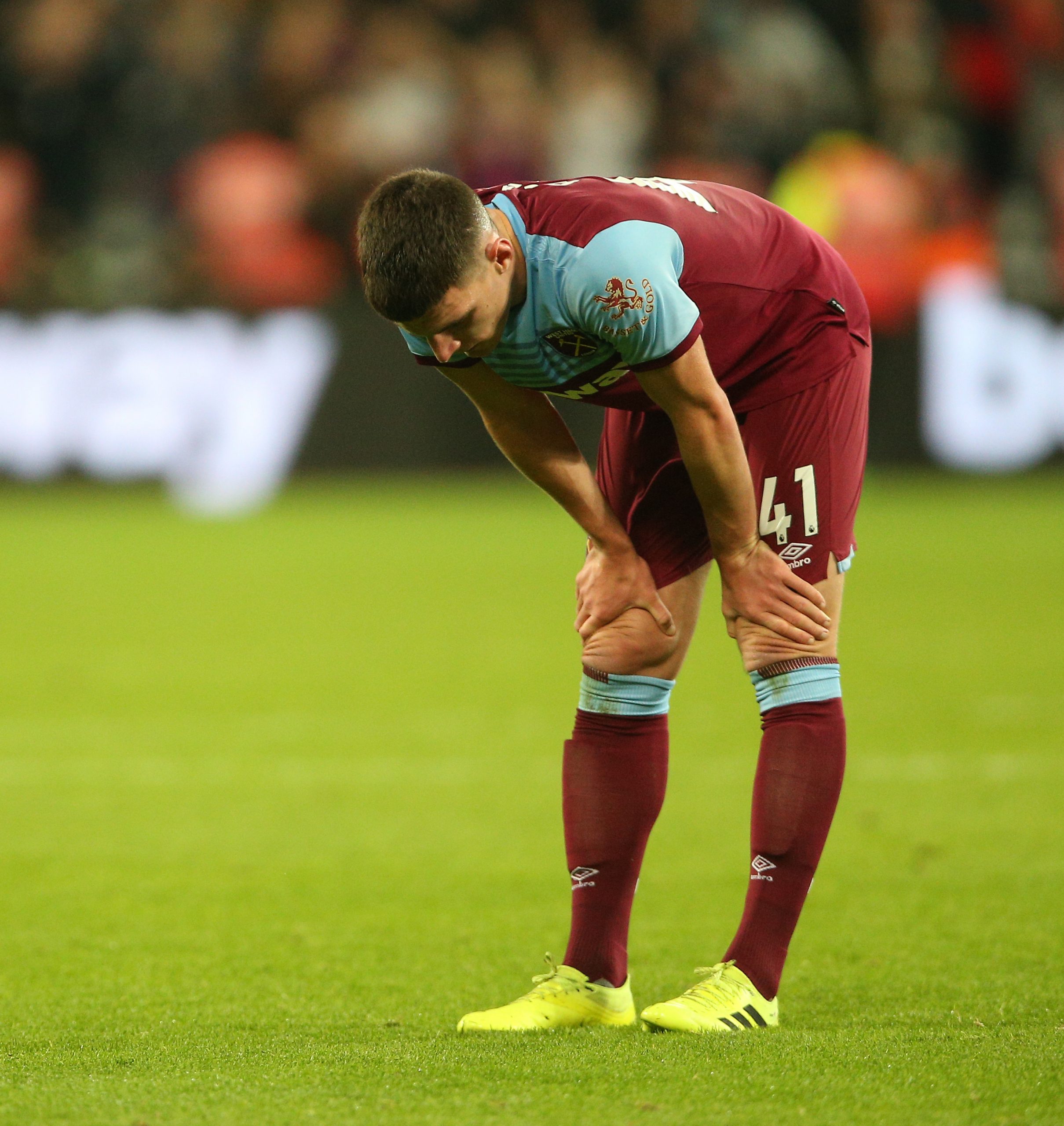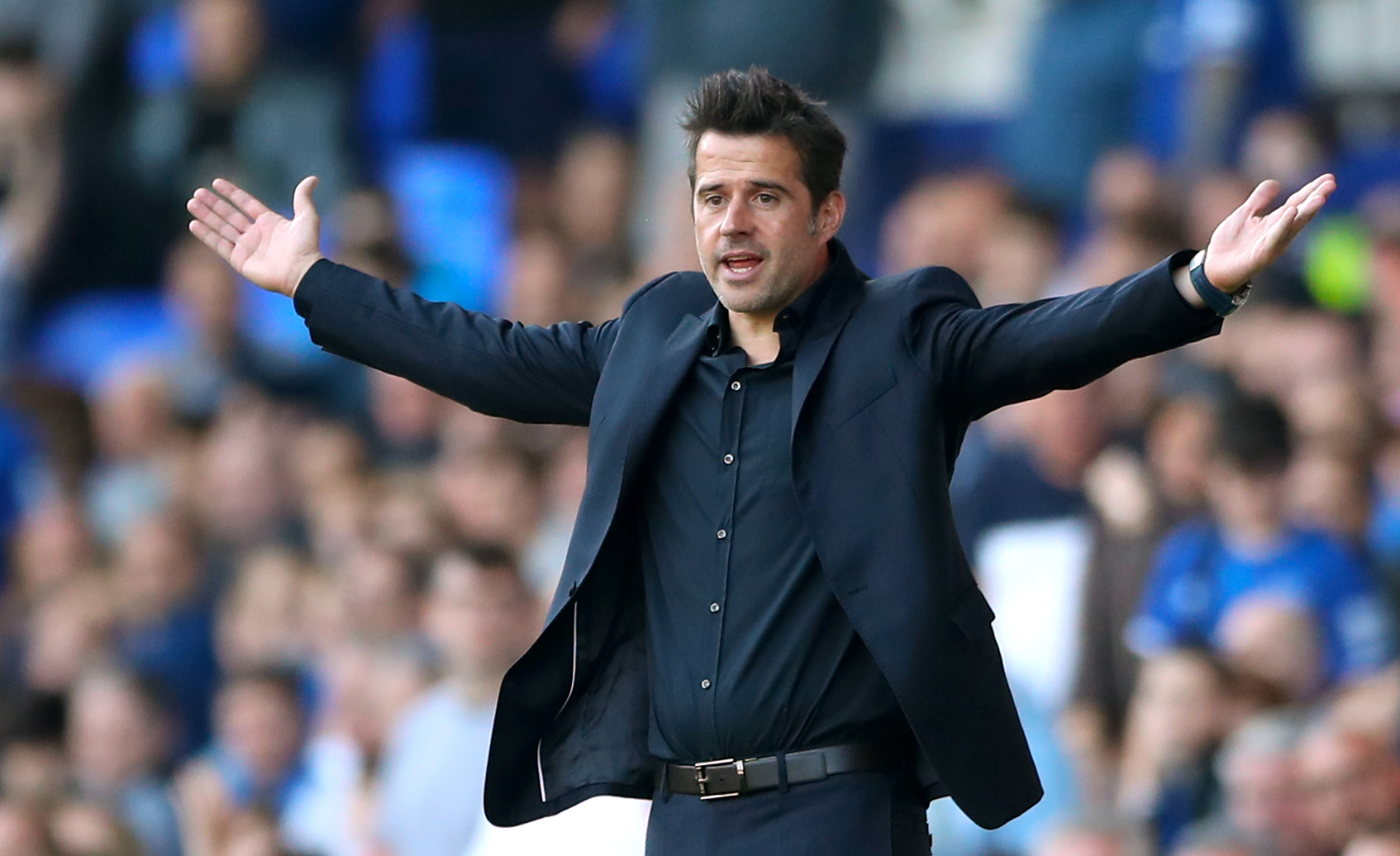Christian Pulisic is starting to fulfil his promise. After a slow start, the USMNT winger is becoming one of the most dangerous forwards in the Premier League. Aside from moody coaches and a Russian oligarch, Stamford Bridge is known as a place where young players flop, only to move abroad and hit the top bracket. Kevin De Bruyne and Mohamed Salah were benched at Chelsea and never managed to fight their way into the team. Earlier this season a similar fate seemed to befall Christian Pulisic, the most expensive US player in history, whose fall from favour culminated in once being left out of a Champions League match squad. Bought in January for £58 million from Borussia Dortmund, where he stayed on loan until summer, Pulisic started three of the first four league games under Frank Lampard, but was then frozen out, starting just one of the next nine games, a League Cup tie at home to fourth-tier Grimsby Town. Despite playing the entire match, he failed to score even once in Chelsea's 7-1 victory. Mason Mount jumped ahead of him in the queue, as did Callum Hudson-Odoi. When Chelsea travelled to Lille in early October, Pulisic was not in the squad. “It hurt not to be there,” he said. It would've made sense if Lampard was particularly fond of Mount, whom he had on loan at Derby last season, or of Hudson-Odoi, an academy product who in September signed a five-year deal worth a reported £120,000 a week to fend off interest from Bayern Munich. Yet Lampard said Pulisic needed to train better and take his chances. When Pulisic got a start at Burnley, it was in part because of a couple of good displays coming off the bench, but also because Hudson-Odoi had started two games in five days and needed a rest. That game was a big chance for Pulisic to earn a place in the team. Yet what indicated that he had the ability to grasp it? Certainly not the goalscoring stats. After joining Dortmund as a 16-year-old in February 2015, Pulisic never scored more than four goals in a Bundesliga season before leaving for England. By the time he was 19 and playing for the Dortmund first team, he had become an elusive dribbler, but that did not translate into big chances. The four goals Pulisic scored in 2017–18 were more or less as expected. The season after, however, Pulisic took big a leap. He refused to sign a new contract and was linked to the Premier League, before the emergence of Jadon Sancho limited his playing time. Yet in the time Pulisic did get on the pitch his xG per 90 minutes soared to an elite level for a winger, 0.38 per 90. 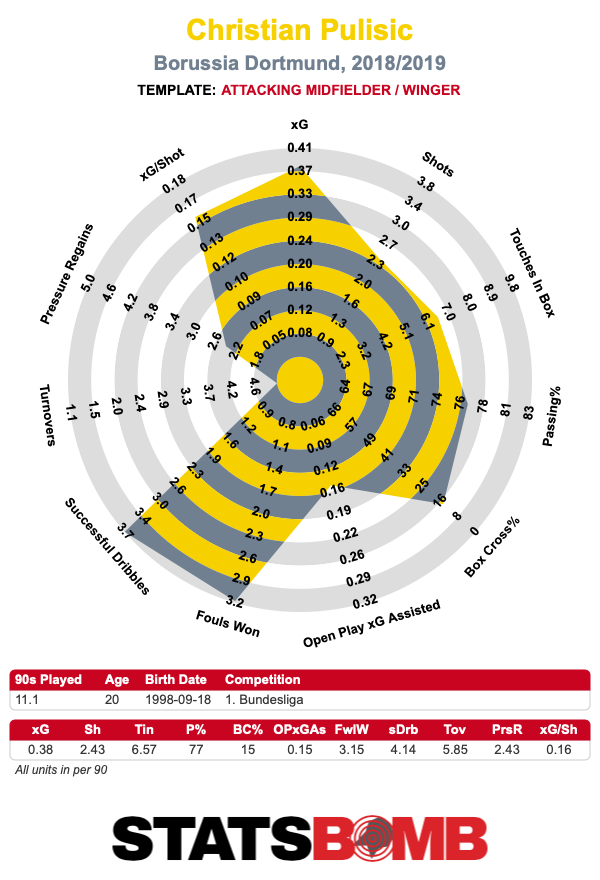 That formed a promising foundation for Pulisic even as he sat on the bench watching Mount and Hudson-Odoi shine. He hadn't shown it yet at Chelsea, but his time at Dortmund clearly suggested Pulisic had the instincts of a prolific goal scorer. And when Pulisic then struck a hat-trick at Burnley, the underlying numbers suggested that he had the ability to keep scoring over a longer spell. And that he has. By now Pulisic has started eight games in a row and scored six goals over the same period. The underlying numbers have improved since his final campaign at Dortmund. His shots per 90, xG per 90, and xG per shot are all up year over year.
That formed a promising foundation for Pulisic even as he sat on the bench watching Mount and Hudson-Odoi shine. He hadn't shown it yet at Chelsea, but his time at Dortmund clearly suggested Pulisic had the instincts of a prolific goal scorer. And when Pulisic then struck a hat-trick at Burnley, the underlying numbers suggested that he had the ability to keep scoring over a longer spell. And that he has. By now Pulisic has started eight games in a row and scored six goals over the same period. The underlying numbers have improved since his final campaign at Dortmund. His shots per 90, xG per 90, and xG per shot are all up year over year. 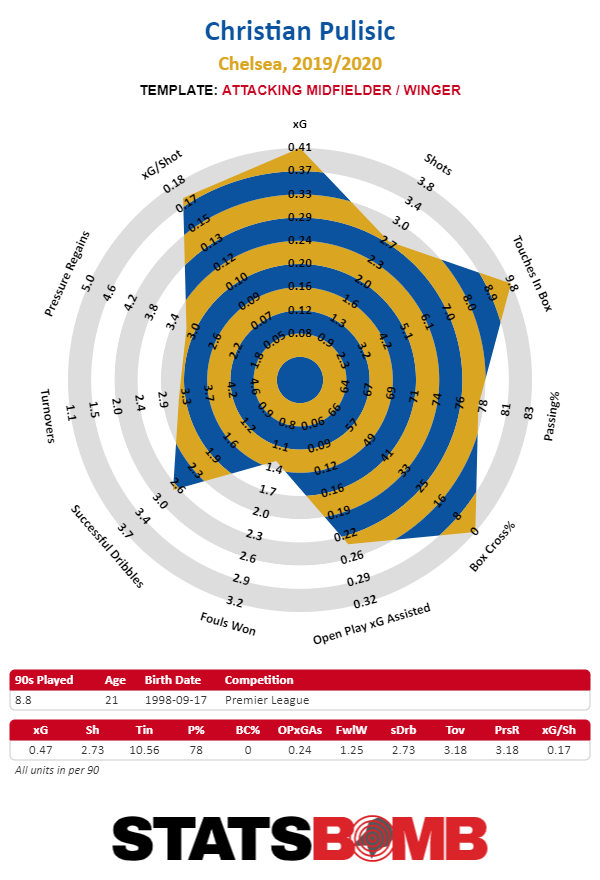 Part of what makes Pulisic so dangerous is his ability to get into good positions in central areas. His main rival on the left wing, Hudson-Odoi, likes to get the ball out wide before taking on defenders. The graphic below shows the passes Hudson-Odoi has received in the league this season.
Part of what makes Pulisic so dangerous is his ability to get into good positions in central areas. His main rival on the left wing, Hudson-Odoi, likes to get the ball out wide before taking on defenders. The graphic below shows the passes Hudson-Odoi has received in the league this season. 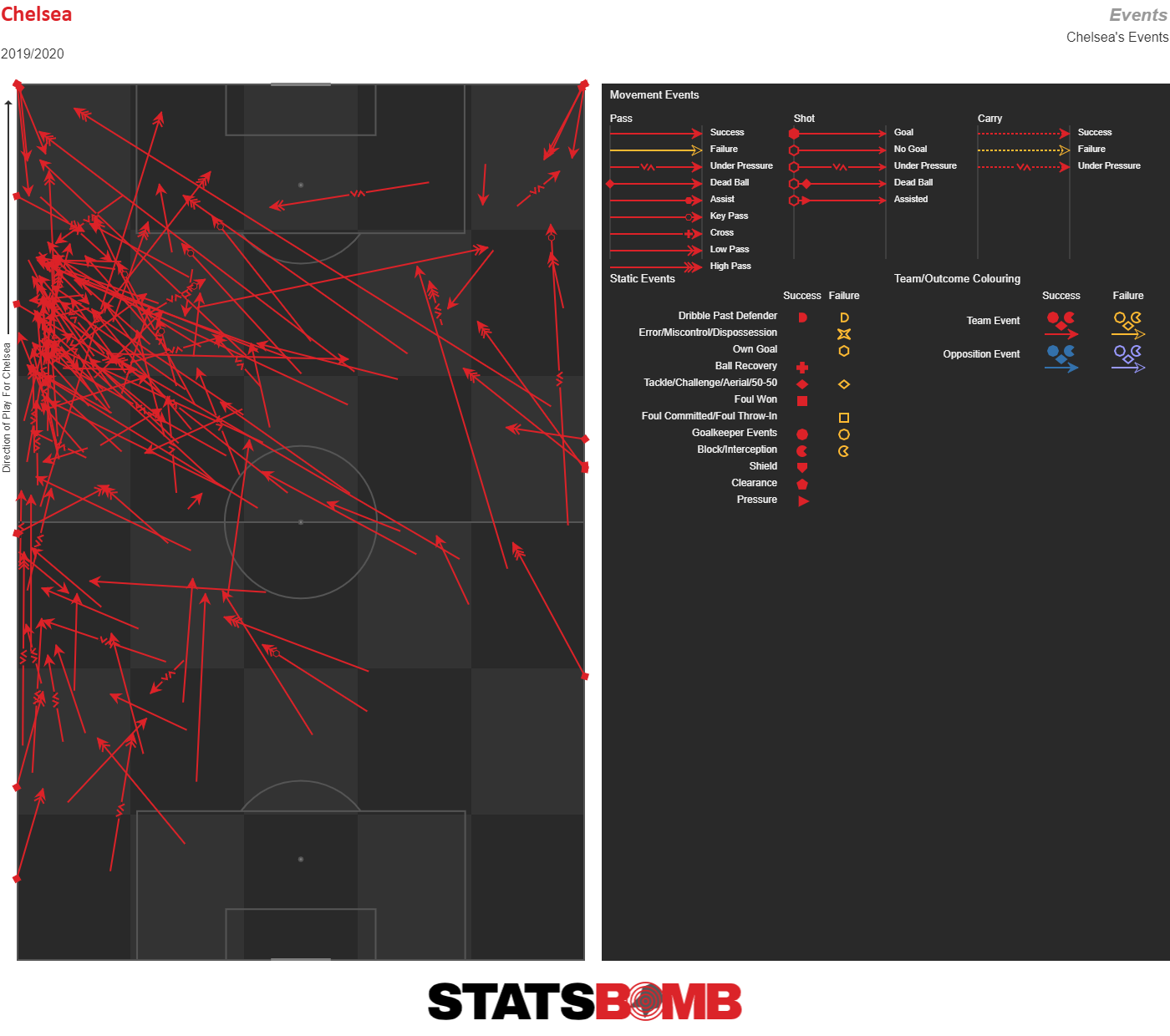 Pulisic moves in between the lines and into the box far more often. The graphic below shows the passes he has received in his last four league games.
Pulisic moves in between the lines and into the box far more often. The graphic below shows the passes he has received in his last four league games. 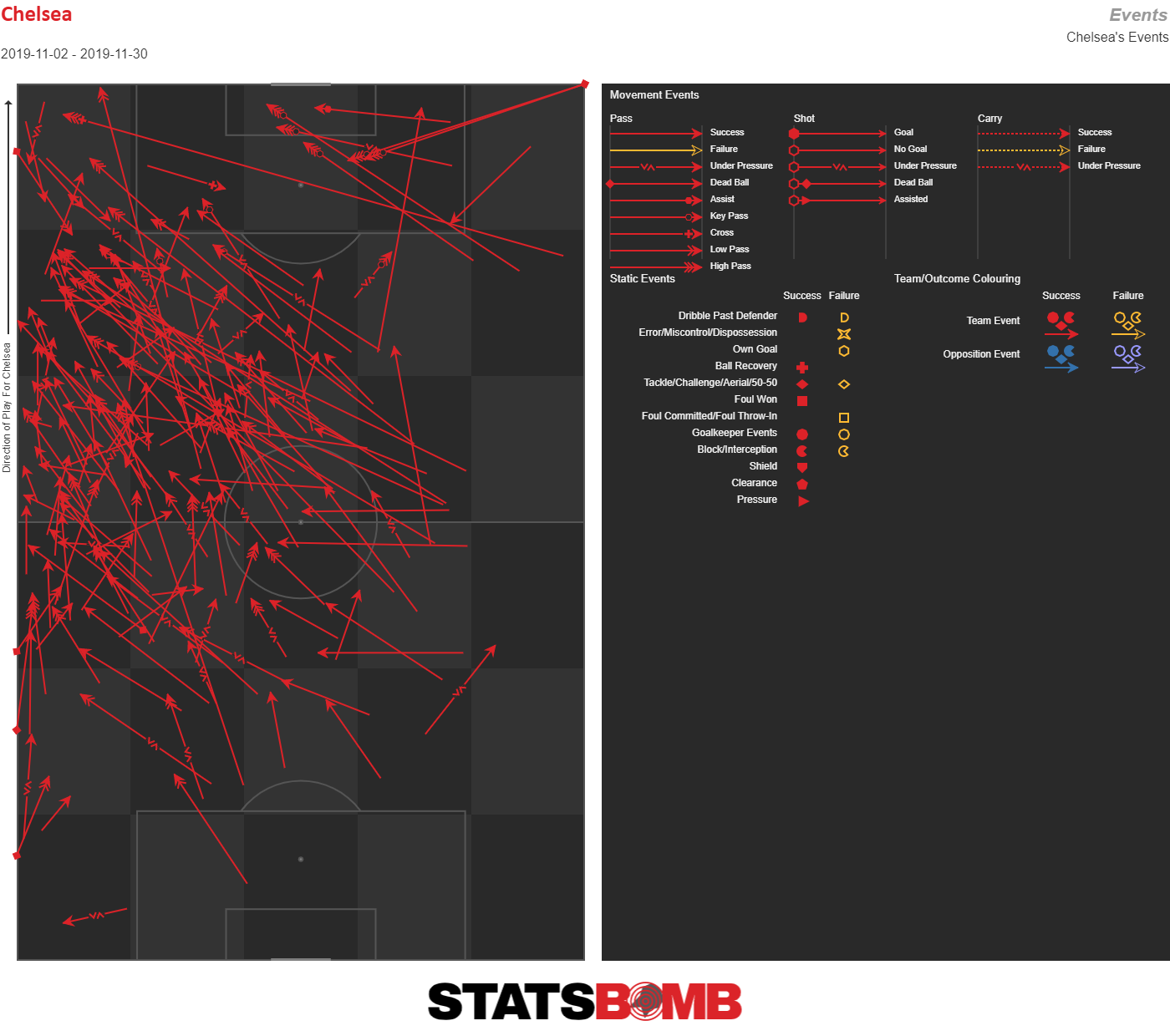 Once Pulisic enters the box, his quick feet and sense of anticipation enable him to unleash a series of high-quality shots. Few wingers post shot maps like this one.
Once Pulisic enters the box, his quick feet and sense of anticipation enable him to unleash a series of high-quality shots. Few wingers post shot maps like this one. 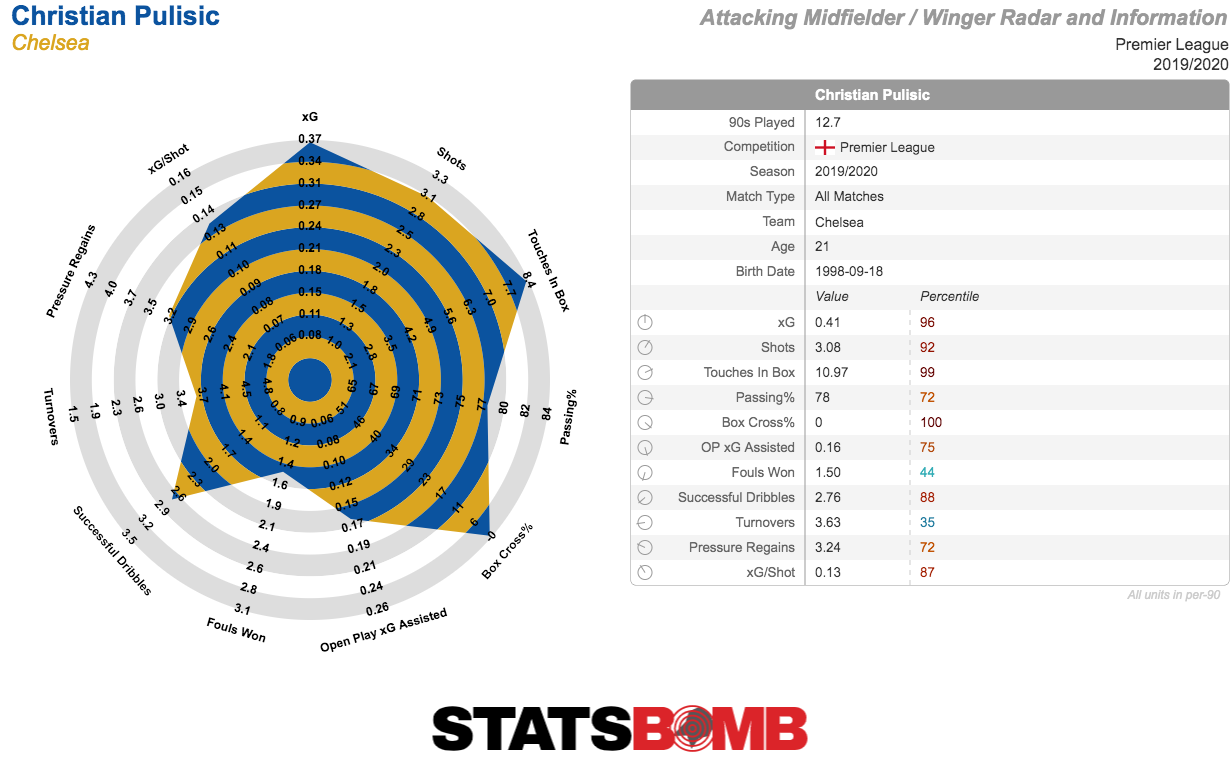 Where do these numbers put Pulisic among the players in the league? Among those who play regularly, he has the sixth-highest open-play xG per 90. The only winger ahead of him is Raheem Sterling. Pulisic is ahead of Mohamed Salah, Sadio Mané, Jamie Vardy, Pierre-Emerick Aubameyang and Son Heung-Min. Pulisic is also sixth in expected assists from open play, with 0.24 per 90. That gives him an expected goal involvement of 0.71 per 90, which is not bad at all for a winger who turned 21 a few months ago. Compare Pulisic with the most productive winger in the league over the last few years and the numbers are actually similar.
Where do these numbers put Pulisic among the players in the league? Among those who play regularly, he has the sixth-highest open-play xG per 90. The only winger ahead of him is Raheem Sterling. Pulisic is ahead of Mohamed Salah, Sadio Mané, Jamie Vardy, Pierre-Emerick Aubameyang and Son Heung-Min. Pulisic is also sixth in expected assists from open play, with 0.24 per 90. That gives him an expected goal involvement of 0.71 per 90, which is not bad at all for a winger who turned 21 a few months ago. Compare Pulisic with the most productive winger in the league over the last few years and the numbers are actually similar. 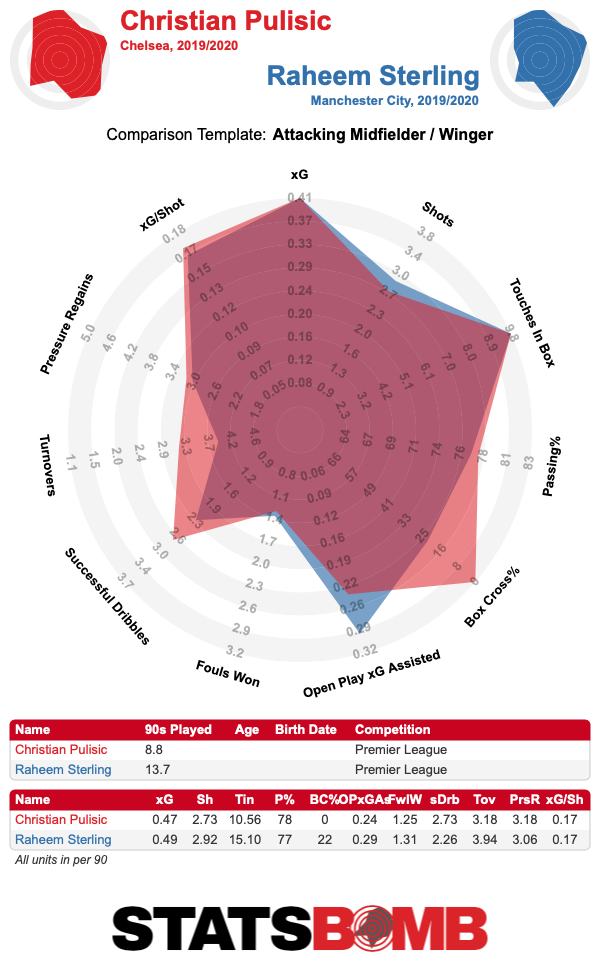 Pulisic enjoys a higher status at Chelsea now. He was one of few players who escaped rotation at home to West Ham after the taxing midweek clash at Valencia, and when Chelsea were chasing an equaliser on Saturday, Lampard replaced Olivier Giroud not with Michy Batshuayi, but with Hudson-Odoi, and moved Pulisic up front. He has now said that Pulisic might play as a striker if Tammy Abraham is out for long. If Lampard wants his most dangerous players as close to goal as possible, such a move would make sense.
Pulisic enjoys a higher status at Chelsea now. He was one of few players who escaped rotation at home to West Ham after the taxing midweek clash at Valencia, and when Chelsea were chasing an equaliser on Saturday, Lampard replaced Olivier Giroud not with Michy Batshuayi, but with Hudson-Odoi, and moved Pulisic up front. He has now said that Pulisic might play as a striker if Tammy Abraham is out for long. If Lampard wants his most dangerous players as close to goal as possible, such a move would make sense. 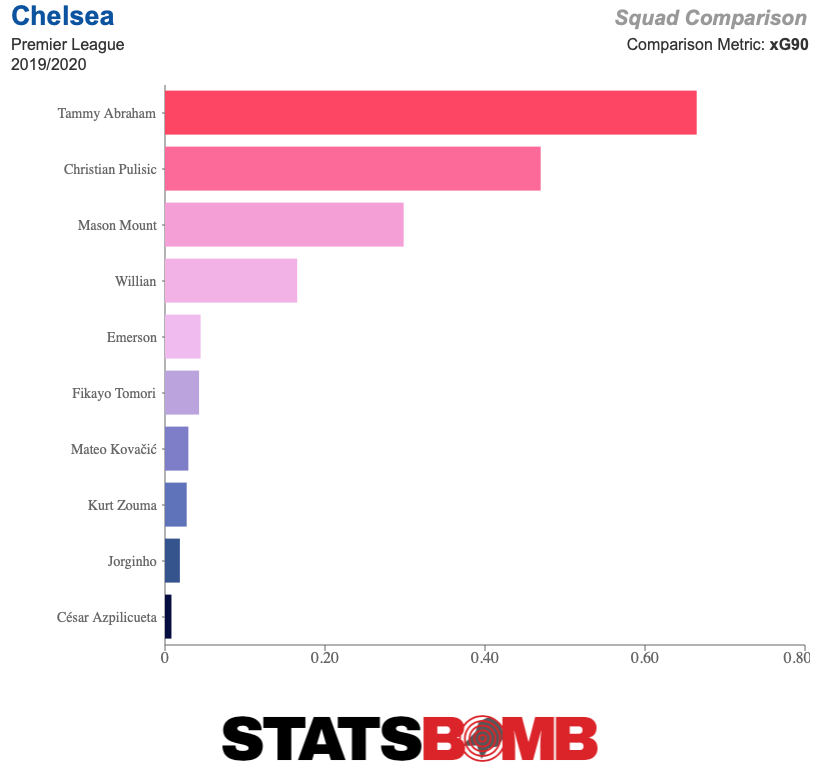 In any case Pulisic will surely not follow De Bruyne and Salah now. His form would need to decline significantly if he is to lose his place in the team, and he shows no signs of that. Whether he’ll ever be as good as those two remains to be seen, but what is certain is that he has continued his development at Dortmund in the Premier League. Having long been considered a player for the future, Pulisic is turning into a star for the present. Header image courtesy of the Press Association
In any case Pulisic will surely not follow De Bruyne and Salah now. His form would need to decline significantly if he is to lose his place in the team, and he shows no signs of that. Whether he’ll ever be as good as those two remains to be seen, but what is certain is that he has continued his development at Dortmund in the Premier League. Having long been considered a player for the future, Pulisic is turning into a star for the present. Header image courtesy of the Press Association
It was as shocking as it was decisive. Tottenham chairman Daniel Levy told Mauricio Pochettino to take his energía universal back to Argentina. In its place came an entirely different kind of energy, a unique electricity that surrounds José Mourinho. The change is indisputably a masterstroke, if the club's only concerns are drama and narrative. It certainly will bring about quite a culture shift in North London. But will it work to help Tottenham’s stated aim of winning more football matches? The most obvious thing to note is that Mourinho is not inheriting a side playing particularly well. Everyone is aware of this, but the problems at Spurs have persisted for longer than most realise. When looking at the expected goals trendlines, what’s obvious is that the side stopped being able to dominate in terms of creating and preventing good chances around April 2018. Pochettino’s side were able to outrun the xG for the best part of a year, but the results caught up with the numbers eventually. 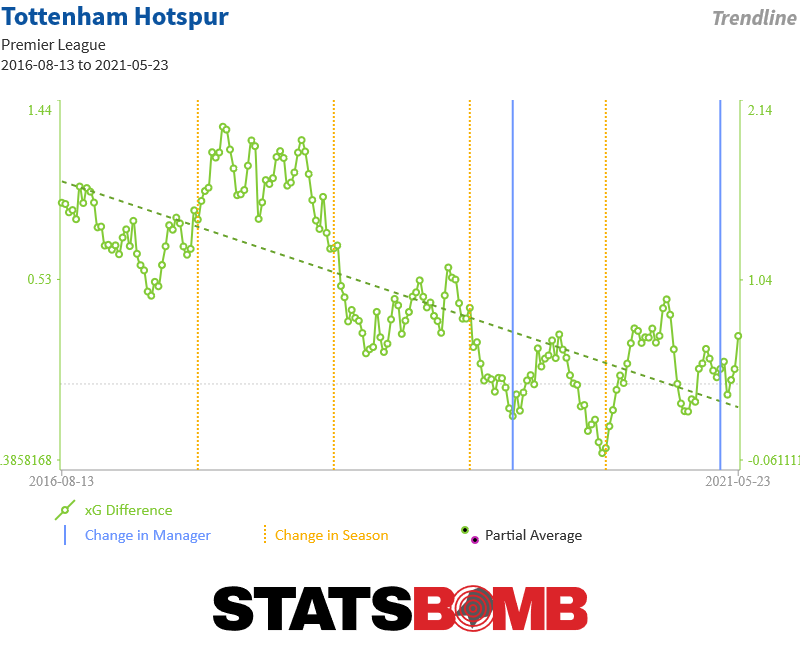 Another oft-noted factor is that Spurs aren’t able to press in the same way they once did, which is again visible in the numbers over a long period. The number of passes they allowed the opposition to make before attempting to win the ball back has gradually increased over this same period. They are no longer a pressing machine.
Another oft-noted factor is that Spurs aren’t able to press in the same way they once did, which is again visible in the numbers over a long period. The number of passes they allowed the opposition to make before attempting to win the ball back has gradually increased over this same period. They are no longer a pressing machine. 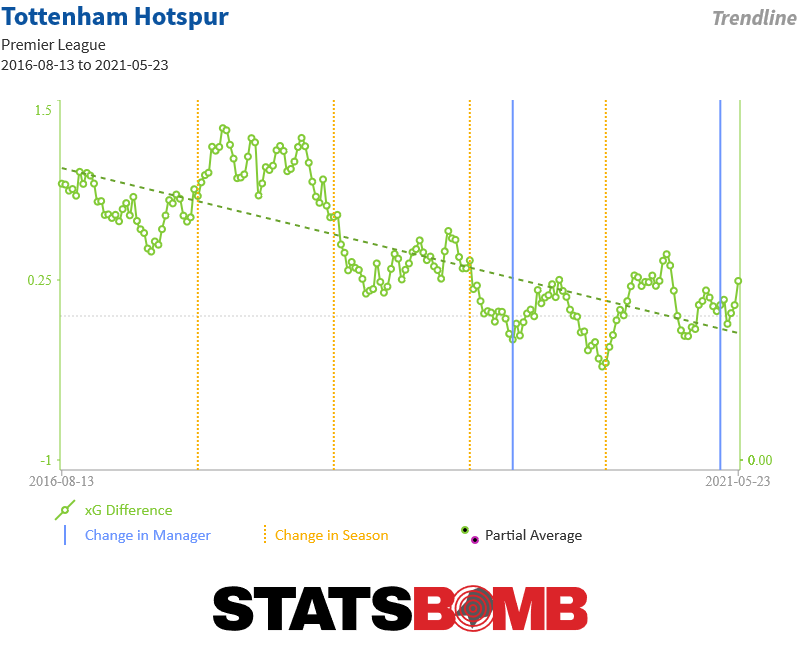 It feels unlikely this was a conscious choice Pochettino made, but that might be irrelevant now. The question is whether Mourinho sticks with this or turns a big dial that says “pressing” on it and looks back to the Tottenham Hotspur Stadium crowd for approval. The assumption from a basic reading of his career would be that he will not have this team press high, though he would argue this is unfair. He certainly perceives his own career as one in which he adapts his style to the talent available:
It feels unlikely this was a conscious choice Pochettino made, but that might be irrelevant now. The question is whether Mourinho sticks with this or turns a big dial that says “pressing” on it and looks back to the Tottenham Hotspur Stadium crowd for approval. The assumption from a basic reading of his career would be that he will not have this team press high, though he would argue this is unfair. He certainly perceives his own career as one in which he adapts his style to the talent available:
“You can compare my Porto team with Liverpool because the qualities of the players are there. It was my best team in defensive transition. We lose the ball, we bite like mad dogs and recover the ball after two seconds. In Real Madrid, I had my best team in direct counter attack because I had young [Ángel] Di María, young [Cristiano] Ronaldo, young [Gonzalo] Higuaín and young [Karim] Benzema. We killed everybody in offensive transitions. In Inter, I had my best team in a defensive low block. [With] people like [Marco] Materazzi, [Walter] Samuel, Lúcio, [Iván] Córdoba in the low block you can be there five hours and you don’t concede a goal. So players make teams play in certain ways.”
If we take Mourinho at his word, how will he adapt to these players? The intrigue begins with the centre backs. There are few doubts about the quality of Toby Alderweireld and Jan Vertonghen; the pair have been the best central defensive partnership in the Premier League in the last five years. What they are not are “low block” defenders of the type Mourinho had at Inter. With the odds of at least one of these two leaving in the summer, the new manager could conceivably reshape his defence around a centre back more adept at clearing the ball away in his own box, but for now, he must work with defenders accustomed to taking a higher line. Davinson Sánchez and Juan Foyth, the other options, are broadly of the same mould. This might mean we see a side closer to Porto than Inter, where Mourinho has the players available to play higher up the pitch. He generally likes to employ an aggressive pressing number ten; Dele Alli is natural fit. The Englishman led Spurs in pressures per 90 for the previous two seasons, while providing exactly the kind of dynamic runs into the box and ability to get goals that Mourinho wants in a number ten. Despite the number of problems that occurred during his time at Manchester United, Mourinho was able to really get the best out of Jesse Lingard, a player with a similar skillset but lesser ability than Alli. There is no reason to think this combination of player and manager won’t thrive. 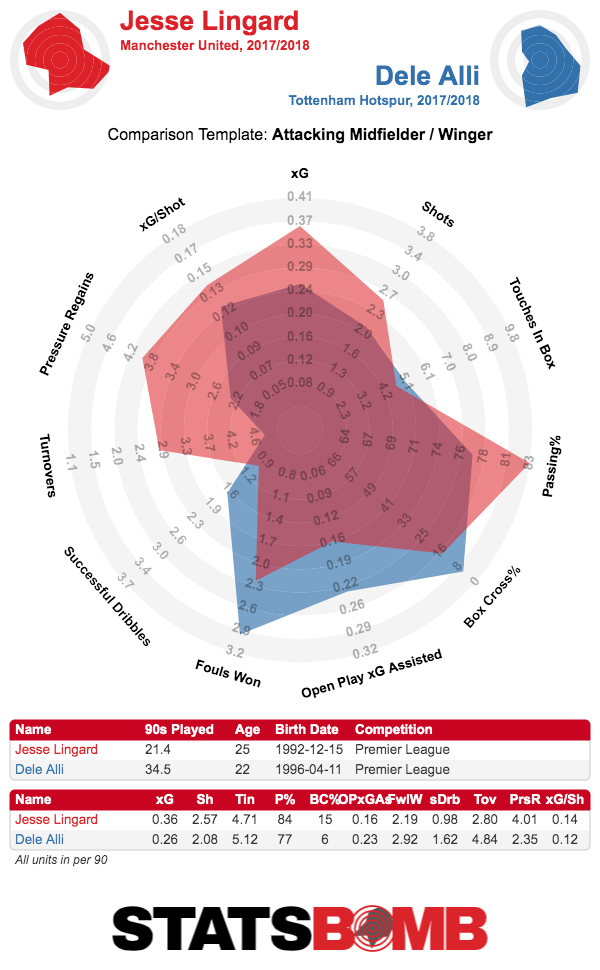 Of the two games Tottenham have played under Mourinho, there have been few surprises. Harry Kane is unsurprisingly leading the line, and appears to be taking up positions on the shoulder of the defence more frequently. He has been caught offside a few times, but this might be a case of adapting to a slightly different role and learning to time his runs better. He opened the Mourinho era with three goals from four open play shots in two games, which I don’t need to tell you is not going to be sustainable. Enough has been written on Kane’s declining shot volume of the later Pochettino era, and it will take a larger sample before we can reassess him under Mourinho. Mourinho has always valued speed, so it’s unsurprising that Lucas Moura has these games on the right. The manager has a penchant for converting previously flakey wide players into disciplined workhorses, so presumably he will attempt to turn Lucas into this team’s Willian. Erik Lamela might be a more natural fit here defensively, he doesn’t have quite the same burst of pace as Lucas and seems less suited to direct counter attacking than Pochettino’s press and possess approach. On the other side, while at Chelsea and Real Madrid, Mourinho preferred his left-sided attacker to push up high, and Son Heung-min should have no issue fulfilling this duty. He doesn’t have the same majestic creativity and dribbling skills as Eden Hazard, but if you wanted a budget version of circa 2012 Ronaldo, Son is a good fit. The midfield is somewhat less inspiring. Eric Dier and Harry Winks appear to be the preferred double pivot for the time being, which creates limitations. Winks is undoubtedly a calm passer in the mould of Michael Carrick or Gareth Barry, but he primarily passes to the player who really progresses the ball, not the ball progressor himself. This is all well and good, but less so when playing next to Dier who, to put it politely, has a few weaknesses. There is hope that Mourinho might shake the once-useful Dier back into action, but considering his public acknowledgment that health issues have contributed to his poor form, this isn’t an easy problem to fix. His best form, it shouldn’t be forgotten, came when he played alongside Mousa Dembélé, who could control games through an inhuman ability to resist the press. Winks does not provide such skills.
Of the two games Tottenham have played under Mourinho, there have been few surprises. Harry Kane is unsurprisingly leading the line, and appears to be taking up positions on the shoulder of the defence more frequently. He has been caught offside a few times, but this might be a case of adapting to a slightly different role and learning to time his runs better. He opened the Mourinho era with three goals from four open play shots in two games, which I don’t need to tell you is not going to be sustainable. Enough has been written on Kane’s declining shot volume of the later Pochettino era, and it will take a larger sample before we can reassess him under Mourinho. Mourinho has always valued speed, so it’s unsurprising that Lucas Moura has these games on the right. The manager has a penchant for converting previously flakey wide players into disciplined workhorses, so presumably he will attempt to turn Lucas into this team’s Willian. Erik Lamela might be a more natural fit here defensively, he doesn’t have quite the same burst of pace as Lucas and seems less suited to direct counter attacking than Pochettino’s press and possess approach. On the other side, while at Chelsea and Real Madrid, Mourinho preferred his left-sided attacker to push up high, and Son Heung-min should have no issue fulfilling this duty. He doesn’t have the same majestic creativity and dribbling skills as Eden Hazard, but if you wanted a budget version of circa 2012 Ronaldo, Son is a good fit. The midfield is somewhat less inspiring. Eric Dier and Harry Winks appear to be the preferred double pivot for the time being, which creates limitations. Winks is undoubtedly a calm passer in the mould of Michael Carrick or Gareth Barry, but he primarily passes to the player who really progresses the ball, not the ball progressor himself. This is all well and good, but less so when playing next to Dier who, to put it politely, has a few weaknesses. There is hope that Mourinho might shake the once-useful Dier back into action, but considering his public acknowledgment that health issues have contributed to his poor form, this isn’t an easy problem to fix. His best form, it shouldn’t be forgotten, came when he played alongside Mousa Dembélé, who could control games through an inhuman ability to resist the press. Winks does not provide such skills. 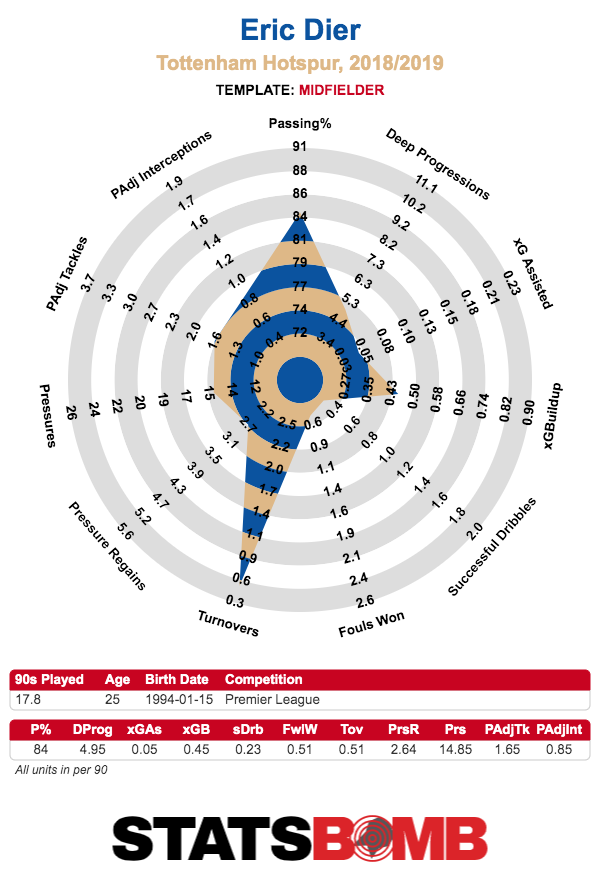 Thus the lack of creative passing in what seems to be Mourinho’s first-choice side could be a real problem. Tanguy Ndombele, Giovani Lo Celso and Christian Eriksen could fit into this side but have thus far been confined to appearances off the bench. As Mourinho cares most about attacking through fast transitions, he might worry that these players could slow the tempo of the game he wants to play (though Ndombele would argue against this). There's a real concern that Mourinho’s side will not have a clear idea in possession and will be unable to create freely. You get what you get from Mourinho. A higher defensive line, a higher pressing version of the kind of fast counter attacking football he generally deploys. There will be games where he takes an extremely negative approach, but they won't be the norm. The team might have trouble breaking down sides in possession, a typical issue in primarily reactive football. With all of this, it should be expected that things improve in the short term at an absolute minimum. The big picture questions won’t become clear for another year.
Thus the lack of creative passing in what seems to be Mourinho’s first-choice side could be a real problem. Tanguy Ndombele, Giovani Lo Celso and Christian Eriksen could fit into this side but have thus far been confined to appearances off the bench. As Mourinho cares most about attacking through fast transitions, he might worry that these players could slow the tempo of the game he wants to play (though Ndombele would argue against this). There's a real concern that Mourinho’s side will not have a clear idea in possession and will be unable to create freely. You get what you get from Mourinho. A higher defensive line, a higher pressing version of the kind of fast counter attacking football he generally deploys. There will be games where he takes an extremely negative approach, but they won't be the norm. The team might have trouble breaking down sides in possession, a typical issue in primarily reactive football. With all of this, it should be expected that things improve in the short term at an absolute minimum. The big picture questions won’t become clear for another year.
Stats of Interest
In Arsène Wenger's final season at the Emirates, 24% of Arsenal's passes into the box came from crosses, the lowest in the Premier League. In a stat that traditionally skews towards better sides (Pep Guardiola's Manchester City were a fraction behind), Arsenal came out top. This season, however, that figure is 32%. Not only is this a notable rise, but no other top-six team is relying on crosses to work the ball into the box as much as Unai Emery's. Arsenal just lack the imagination they once had in terms of moving the ball forward. 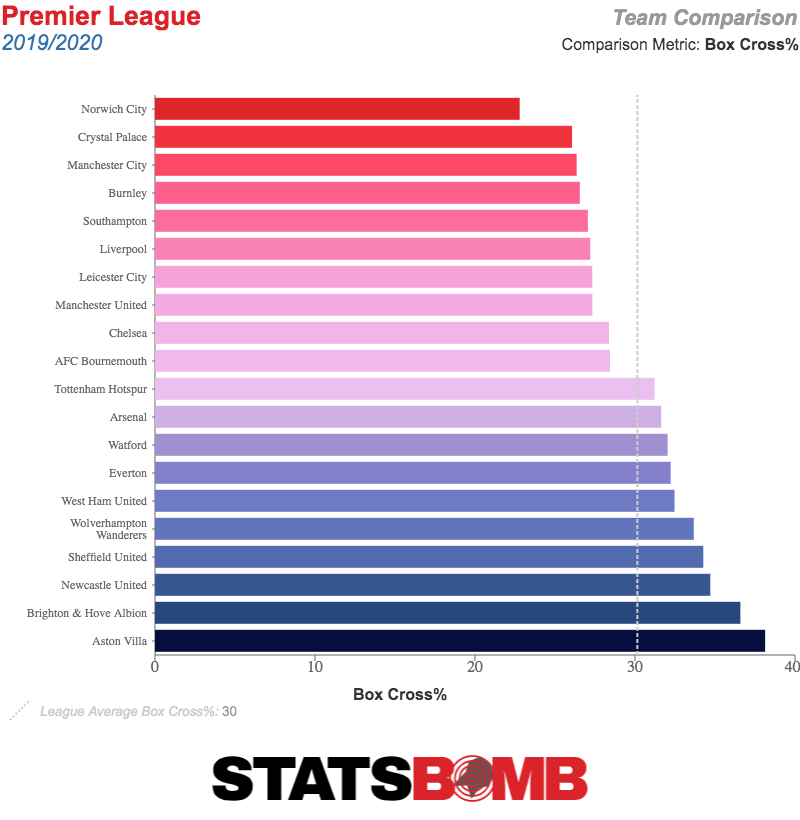 While some sides are embracing elaborate set-piece routines to find new edges, Chelsea isn't one of them. Frank Lampard's side have the lowest xG per set piece of any team in the league. Lampard admits that the Chelsea team he played in did not work on elaborate routines, believing just getting it into the area with players like Didier Drogba and John Terry was enough. Unfortunately, it doesn't look like that's enough now.
While some sides are embracing elaborate set-piece routines to find new edges, Chelsea isn't one of them. Frank Lampard's side have the lowest xG per set piece of any team in the league. Lampard admits that the Chelsea team he played in did not work on elaborate routines, believing just getting it into the area with players like Didier Drogba and John Terry was enough. Unfortunately, it doesn't look like that's enough now. 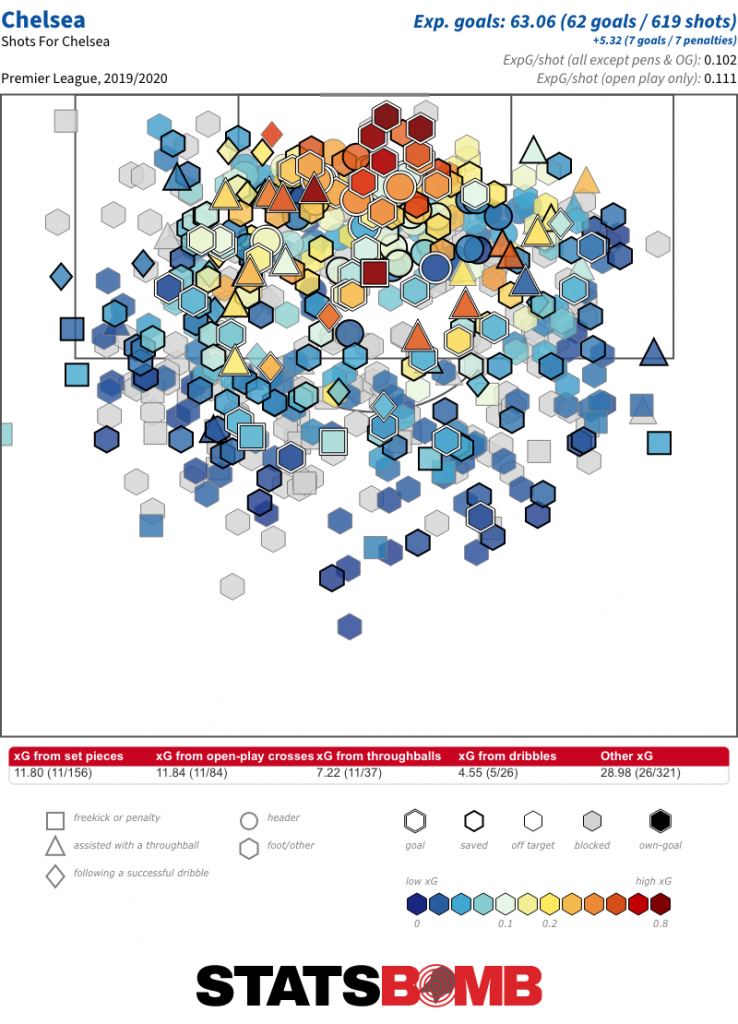 Jack Grealish is earning himself a fair bit of hype at the moment and the numbers indicate it's much deserved. Aston Villa's captain is completing the most open play passes into the box of any non-top-six player, while also winning more fouls than anyone else in the league. In Grealish, Villa have an excellent creator, whether he's playing on the left or in a central midfield role.
Jack Grealish is earning himself a fair bit of hype at the moment and the numbers indicate it's much deserved. Aston Villa's captain is completing the most open play passes into the box of any non-top-six player, while also winning more fouls than anyone else in the league. In Grealish, Villa have an excellent creator, whether he's playing on the left or in a central midfield role. 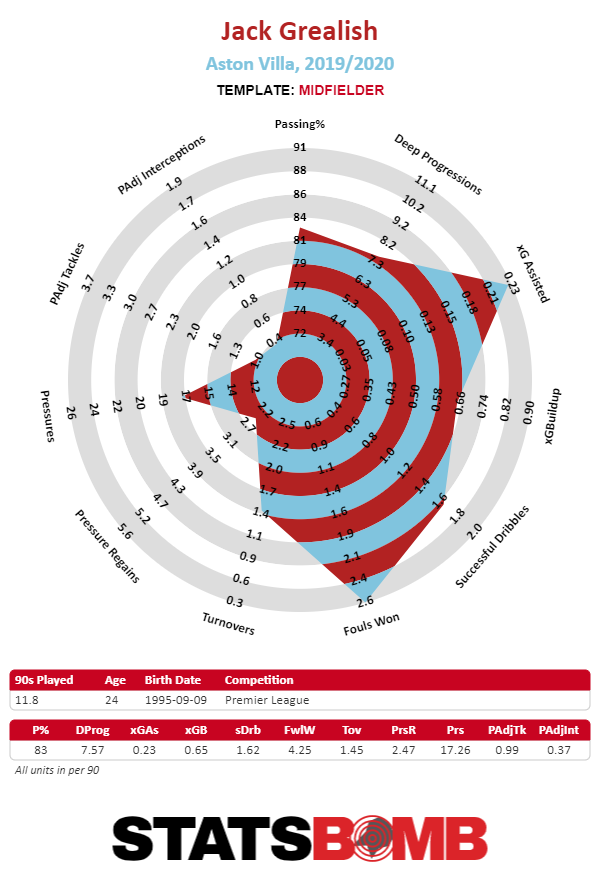
Yes, he has scored a lot of goals in Euro qualification, but there’s more to it than that. On 2nd November 2014, Harry Kane scored his first Premier League goal of Mauricio Pochettino's time at Spurs. Since then, the idea that the Tottenham academy graduate is the best English striker around has been as close to a universally held opinion as possible. 109 non-penalty goals in 178 league games is as much as one could reasonably ask. But as the years pass, concern about Kane's actual numbers has grown. Meanwhile, Tammy Abraham has emerged as a viable alternative. Let’s take a closer look at both players.
Kane Concerns
Before we dig into the problems, let’s remember what was probably the best period in Kane’s career, August 2017 to March 2018, during which he scored 22 non-penalty goals across 28.2 90s. 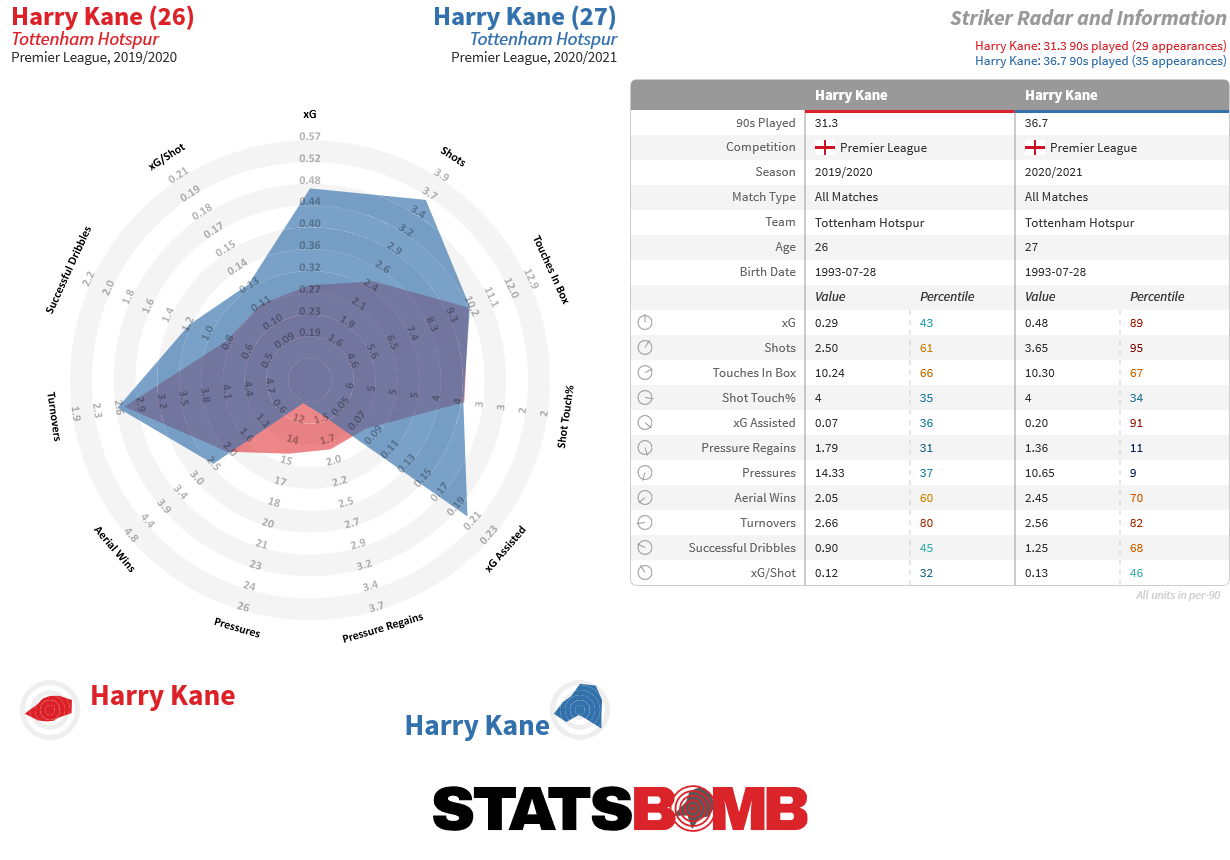 What that stands out visually is how much he prioritised getting shots and scoring goals over other parts of his game. As now-StatsBomb managing editor Mike L. Goodman noted at the time, “Harry Kane isn’t a complete forward. His job isn’t to facilitate play, or bring wingers into the game, or create holes in the defense for his teammates to take advantage of. Tottenham Hotspur’s star striker does one thing: He scores”. And boy did he score.
What that stands out visually is how much he prioritised getting shots and scoring goals over other parts of his game. As now-StatsBomb managing editor Mike L. Goodman noted at the time, “Harry Kane isn’t a complete forward. His job isn’t to facilitate play, or bring wingers into the game, or create holes in the defense for his teammates to take advantage of. Tottenham Hotspur’s star striker does one thing: He scores”. And boy did he score. 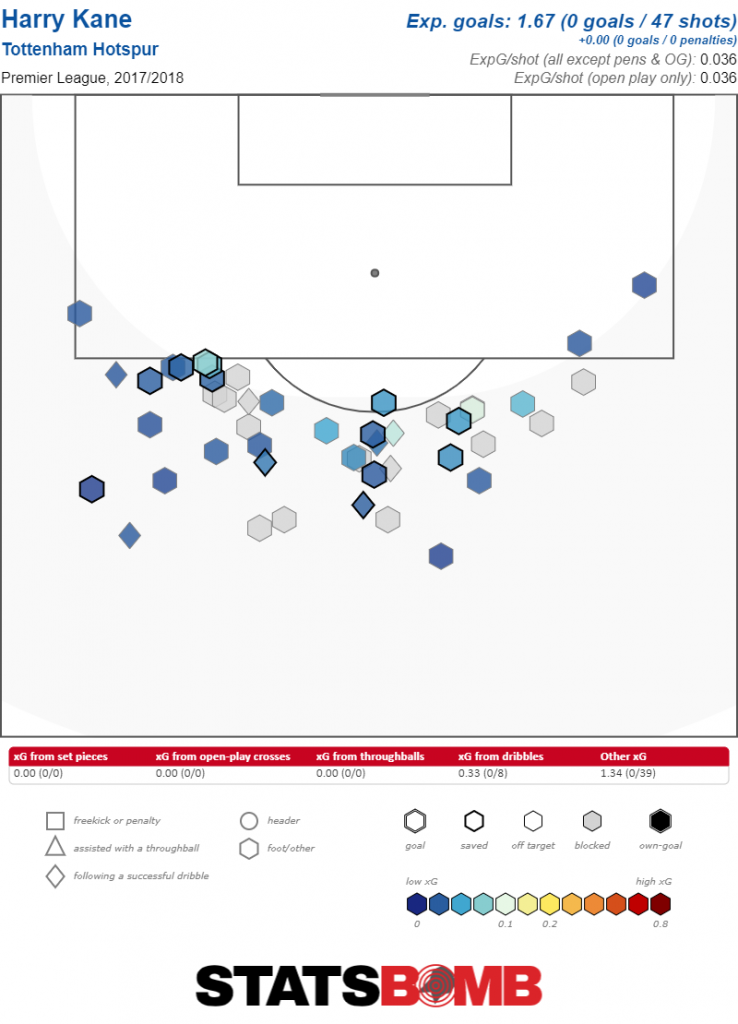 This wasn’t always the case. In previous years, Kane assumed a more well-rounded role, linking up play while sharing the goalscoring burden with Dele Alli and Son Heung-min. But when Kane’s form exploded, everything started to funnel toward him. Spurs were, as Pep Guardiola infamously described them, “the Harry Kane team”. What happened next was rather unfortunate. Kane picked up an ankle injury that kept him out of just two games, but when he returned, it was clear he wasn’t at 100%.
This wasn’t always the case. In previous years, Kane assumed a more well-rounded role, linking up play while sharing the goalscoring burden with Dele Alli and Son Heung-min. But when Kane’s form exploded, everything started to funnel toward him. Spurs were, as Pep Guardiola infamously described them, “the Harry Kane team”. What happened next was rather unfortunate. Kane picked up an ankle injury that kept him out of just two games, but when he returned, it was clear he wasn’t at 100%. 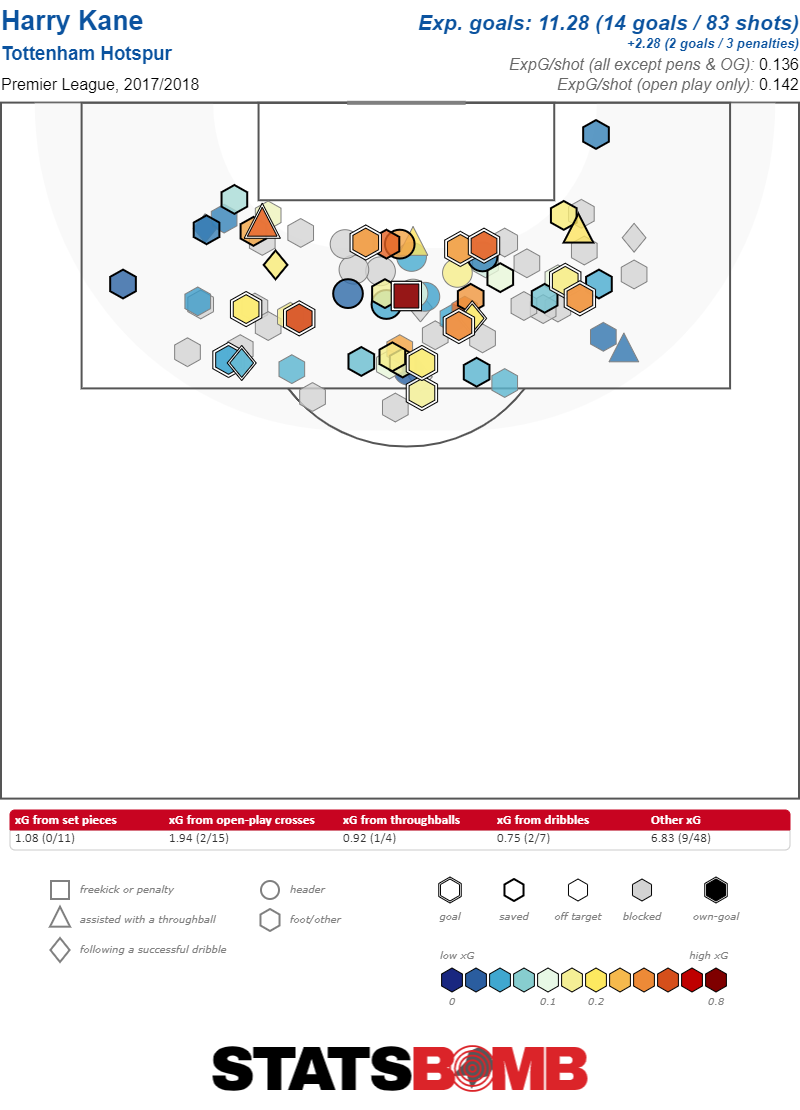 Things improved a touch in 2018-19, but we were still looking at a player performing well below his best.
Things improved a touch in 2018-19, but we were still looking at a player performing well below his best. 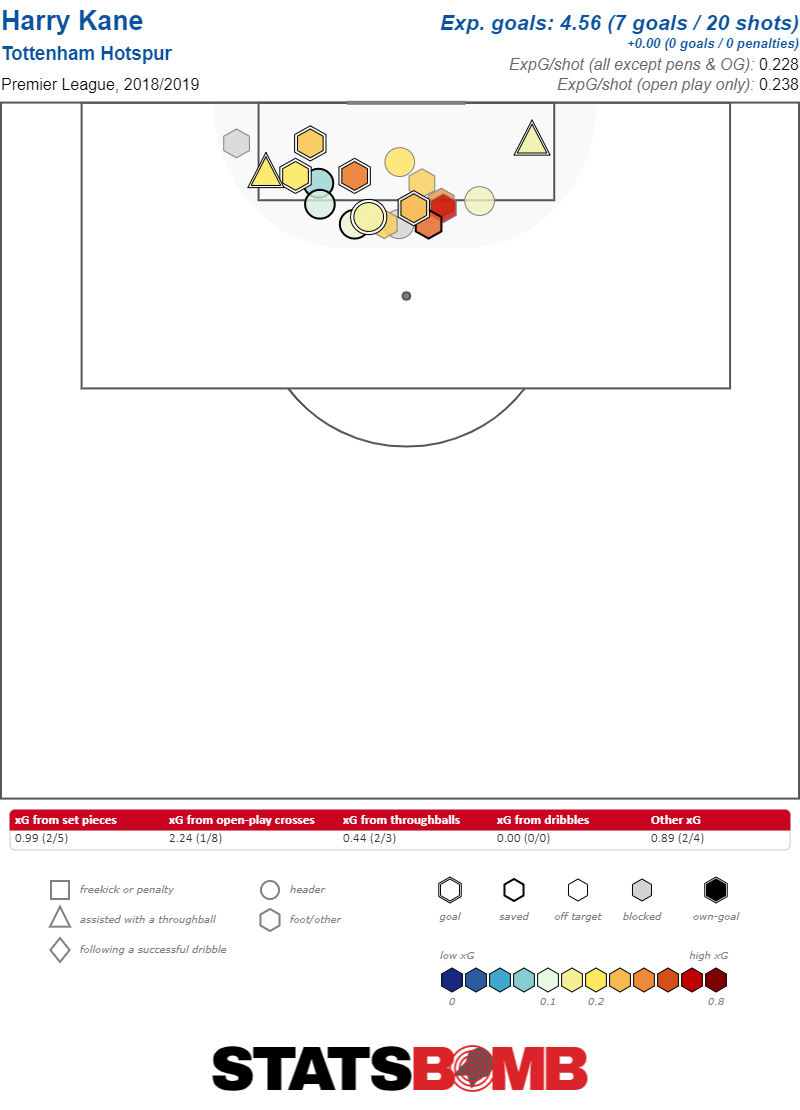 And then we arrive at this season, which just doesn’t look good at all.
And then we arrive at this season, which just doesn’t look good at all. 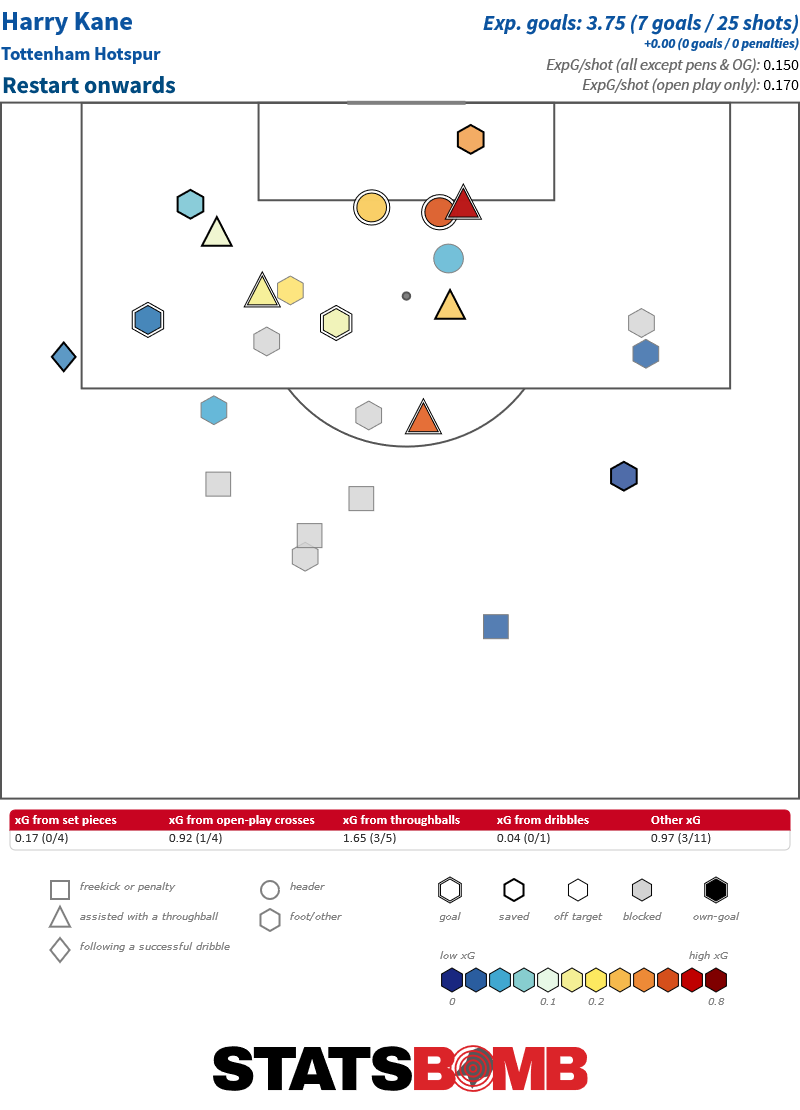 The obvious response is to mention Spurs’ deteriorating form which has now resulted in Pochettino’s departure. And it’s true that form a real factor; it doesn’t take StatsBomb data to tell you strikers benefit from playing in teams that create chances more easily. What we know is that Tottenham’s expected goals in attack have seen a 32.5% decrease this season compared to 2017–18, a sizeable decline to be sure. But Kane’s individual xG and xG assisted has fallen by 53.4% over the same period. The two numbers cannot be separated, but Kane’s attacking output has declined at a faster rate than Spurs overall. We should also note his touches in the box have risen, as he’s become much less efficient at turning them into good shots. It certainly can’t be claimed that this blame falls solely on him, and it definitely feels plausible that his numbers would look better in a stronger side, but it’s also hard to use stats to make a case that Kane is merely a victim of Spurs’ problems, rather than an active contributor to them. The other defence often noted is his England form, with many pointing to Gareth Southgate’s side as an environment where Kane is able to thrive due to the better service he receives. Nine non-penalty goals in just over 1200 minutes since the World Cup is a strong figure, even if it’s generally boosted in the headlines, which include the five penalties he's scored. There is less optimism regarding his shot volume. Unfortunately, we do not have expected goals data here, but we know Kane has taken fewer than three shots per 90 minutes since the 2018 World Cup. Again, we don’t have the xG numbers to back up what we've seen, but unless these shots are exceptionally better than those he generally takes for Tottenham, his goalscoring for England will not continue at this volume.
The obvious response is to mention Spurs’ deteriorating form which has now resulted in Pochettino’s departure. And it’s true that form a real factor; it doesn’t take StatsBomb data to tell you strikers benefit from playing in teams that create chances more easily. What we know is that Tottenham’s expected goals in attack have seen a 32.5% decrease this season compared to 2017–18, a sizeable decline to be sure. But Kane’s individual xG and xG assisted has fallen by 53.4% over the same period. The two numbers cannot be separated, but Kane’s attacking output has declined at a faster rate than Spurs overall. We should also note his touches in the box have risen, as he’s become much less efficient at turning them into good shots. It certainly can’t be claimed that this blame falls solely on him, and it definitely feels plausible that his numbers would look better in a stronger side, but it’s also hard to use stats to make a case that Kane is merely a victim of Spurs’ problems, rather than an active contributor to them. The other defence often noted is his England form, with many pointing to Gareth Southgate’s side as an environment where Kane is able to thrive due to the better service he receives. Nine non-penalty goals in just over 1200 minutes since the World Cup is a strong figure, even if it’s generally boosted in the headlines, which include the five penalties he's scored. There is less optimism regarding his shot volume. Unfortunately, we do not have expected goals data here, but we know Kane has taken fewer than three shots per 90 minutes since the 2018 World Cup. Again, we don’t have the xG numbers to back up what we've seen, but unless these shots are exceptionally better than those he generally takes for Tottenham, his goalscoring for England will not continue at this volume.
Tammy Abraham, the Kane Challenger
Not unlike a younger Kane, the path to the Chelsea first team hasn’t been the most straightforward for Abraham. Both men were sent out on loan at a young age, but while Kane found it difficult, the Chelsea striker thrived, scoring 21 non-penalty goals at the tender age of 19 for Bristol City in the Championship. This unsurprisingly earned him a move up to the Premier League, where things went rather less swimmingly. Six goals over the season is the number that haunts him, though we must consider the mitigating circumstances. Abraham arrived at Swansea after they sold their most obvious creator in Gylfi Sigurdsson, and brought in no one of an even vaguely similar skillset. The team had pure strikers in Abraham and Wilfried Bony but lacked the players to create chances for them. Manager Paul Clement’s dreary defensive football saw Abraham largely isolated upfront. Subsequent boss Carlos Carvalhal had different ideas, but this often involved eschewing a recognised striker altogether. Abraham still managed to put up the best xG per 90 of any under-21 player outside the top six that season, which was probably as much as could reasonably be expected. Someone at Chelsea apparently disagreed with this assessment, though, and decided that Abraham should be demoted back down to the Championship. He scored 20 non-penalty goals for Aston Villa and proved himself one of the better strikers in the division, but to those watching, it felt he wasn’t being really tested. 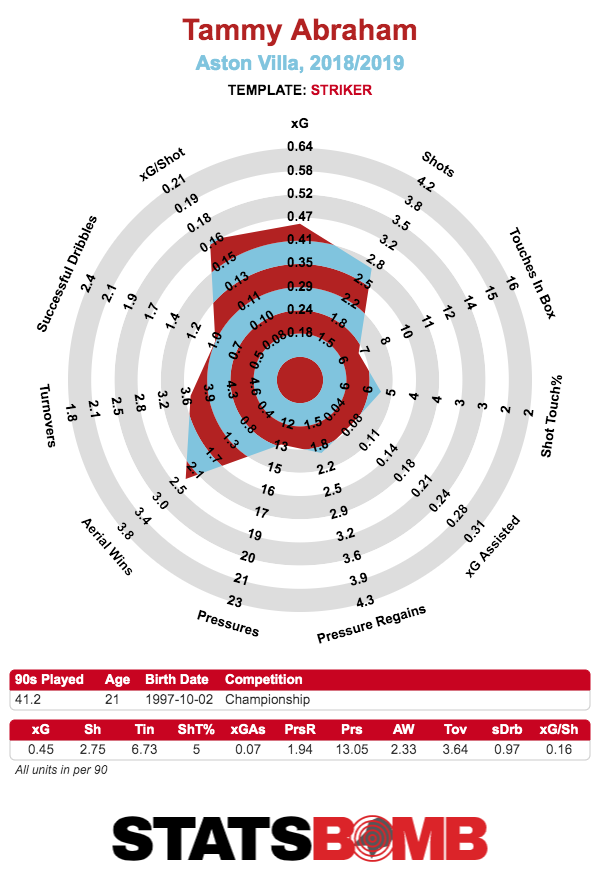 But even the most optimistic arguments in Abraham’s favour couldn’t quite have predicted this season. The goals are the biggest factor, and they’re backed up by plenty of good shots. Whatever questions that may have existed about his all-round game have been blown out of the water. This season, only Sergio Agüero has a bigger xG and xG assisted per 90 numbers in the Premier League.
But even the most optimistic arguments in Abraham’s favour couldn’t quite have predicted this season. The goals are the biggest factor, and they’re backed up by plenty of good shots. Whatever questions that may have existed about his all-round game have been blown out of the water. This season, only Sergio Agüero has a bigger xG and xG assisted per 90 numbers in the Premier League. 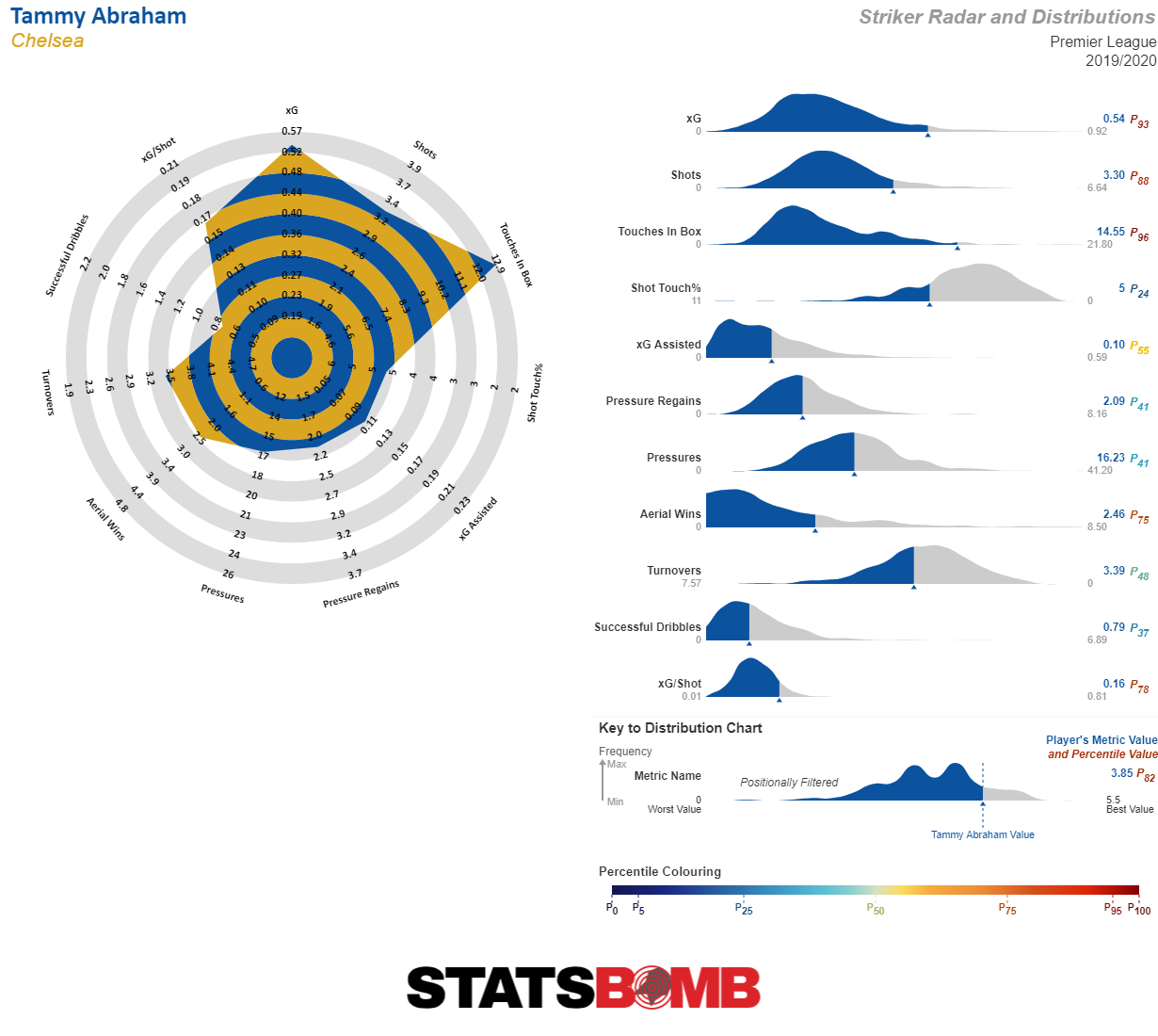 It’s an open question as to whether he can keep this kind of form up across the season. With xG focused analysis, there is a tendency to forget that generating shots is also subject to variance. Abraham’s recent form is above what he's shown in the past, and can be said to be inflated in a number of ways. The gap in the numbers right now is so vast, though, that it’s almost impossible to argue that Kane is currently playing better football than Abraham.
It’s an open question as to whether he can keep this kind of form up across the season. With xG focused analysis, there is a tendency to forget that generating shots is also subject to variance. Abraham’s recent form is above what he's shown in the past, and can be said to be inflated in a number of ways. The gap in the numbers right now is so vast, though, that it’s almost impossible to argue that Kane is currently playing better football than Abraham.
So What do England do?
England will kick off their Euro 2020 finals campaign at Wembley on 14 June and, if fit, it seems almost certain Southgate will select Kane up front. Other personnel questions remain, but several things seem to be clear in his mind: The default formation will be 4-3-3, and the core of the attack will be built around Kane dropping deeper into “false nine” positions to allow Rahee\ Sterling and another wide forward to exploit the space behind. As much as Kane’s form has become a significant talking point in the tiny bubble of the football analytics community, it hasn’t made much of a dent in the wider world, where the perception remains that the England captain is one of the undisputed best strikers around. There’s scant evidence that Southgate doesn’t share the more popular view. But should he change his mind? A tactical idea Frank Lampard is working on at Chelsea should give him pause. Increasingly, the Chelsea wingers run past Abraham into more explicit poaching zones right in front of goal. It had already been reported that Lampard was using none other than England star Sterling as a reference point for the runs he wants his wingers to make, and he as much as confirmed it himself, stating that “what Raheem Sterling’s made his own into the last couple of seasons is getting in [the six-yard box] and I love that Christian [Pulisic] goes all the way in there”. As Lampard prompts his wingers to take up more Sterling-esque positions, he seems to be encouraging Abraham to adapt, as (unusually) the striker has not yet taken a shot inside box, unlike his wide counterparts. If this trend continues, there’s no reason to think Abraham would not be able to thrive in an England system built around Sterling. Perception can be a curious thing in football. Through his good finishing, penalties and distribution of goals that has enabled him to avoid any prolonged “dry spells”, Kane has maintained an image as one of Europe’s elite strikers despite no longer having the numbers to back it up. This can’t last forever; eventually, Kane will need to close the gap in terms of taking good shots in order to avoid Abraham succeeding him as England’s best striker. Header image courtesy of the Press Association
Faced with the difficult task of surviving the Premier League with the same core of players who got them promoted last season, it initially looked like Norwich City had found a way to do it.
Two wins from the first five games isn’t a huge figure, but it included some genuinely eye-catching performances. Despite the scoreline, the Canaries showed genuine promise at Anfield, with one really good chance the only difference between the sides in terms of expected goals.
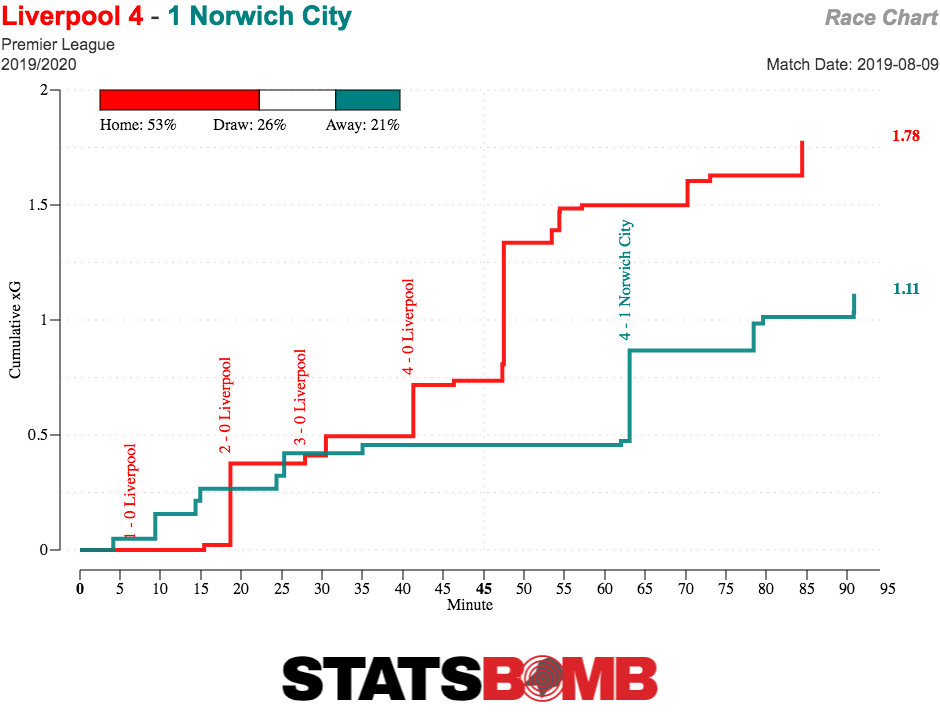
Of course, it’s the victory against Manchester City that got everyone talking. A 3-2 win against the champions while fielding an XI without a number of players nursing injuries isn’t supposed to happen. And while they had a hard time withstanding the sky blue onslaught in the last 20 minutes, they had already done enough good work to find themselves in a winning position, and kickstarted the narrative surrounding Man City’s defensive issues.
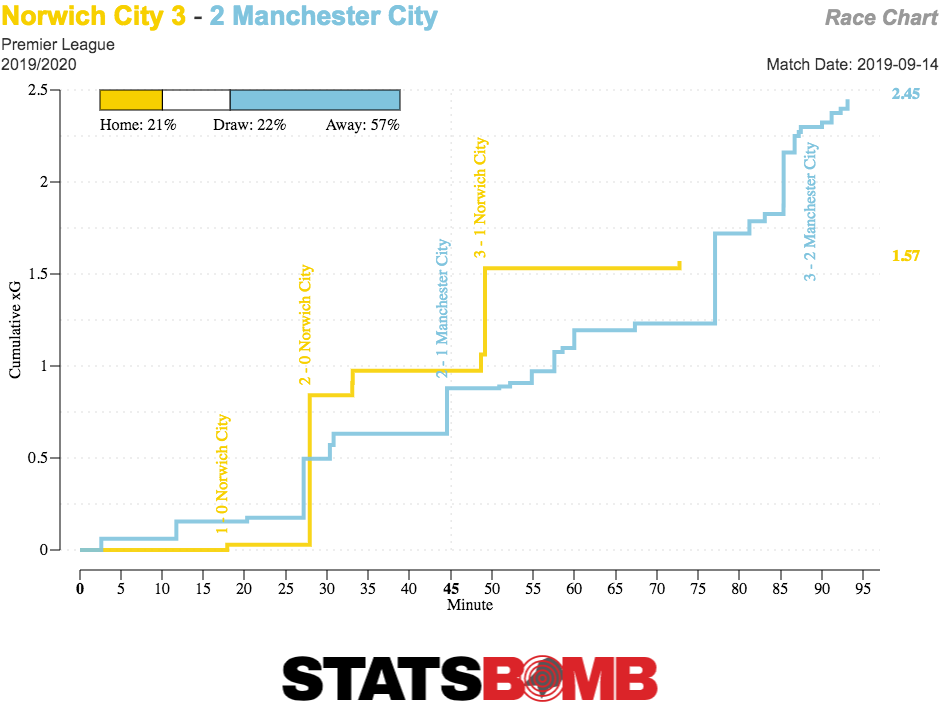
It’s good that Norwich fans have been able to hang on to that memory, because since then they've watched six defeats and one draw over seven games. The Canaries are now bottom of the table, four points from safety. It’s gone from exciting to very, very ugly in the blink of an eye. So what happened? Curiously, perhaps not what was expected. Across the first five fixtures, Norwich had an expected goal difference per game of -0.46, which has worsened to -0.52 since. A small decline, but those initial fixtures featured matches against Liverpool and Man City. A schedule-adjusted model would likely track Norwich as significantly worse after these games.
More curiously, Norwich have actually improved on the defensive side, though this was a very low bar to clear. They’ve gone from conceding an apocalyptically bad 19 shots per game to a merely very poor 15.71, and their increase in chance quality isn't enough to balance this out. They’re pressing higher and more aggressively, though it’s likely this was always the plan, just one that Norwich struggled to execute well.
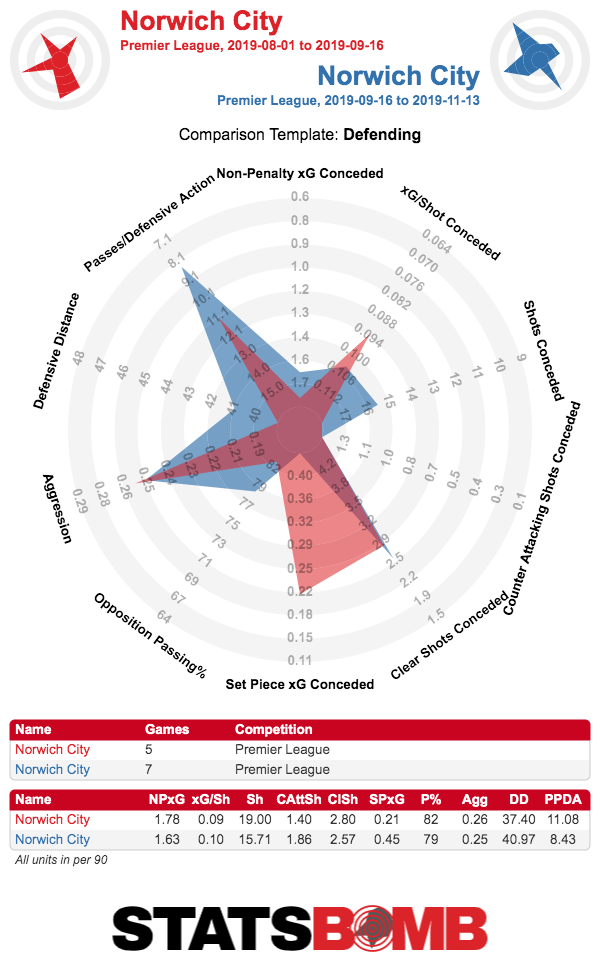
Overall, their xG conceded is close to the worst in the league. It’s better than their actual goals conceded, having let in 27 (plus one penalty scored) from an xG of 20.99, but it’s very difficult to put a positive spin on this.
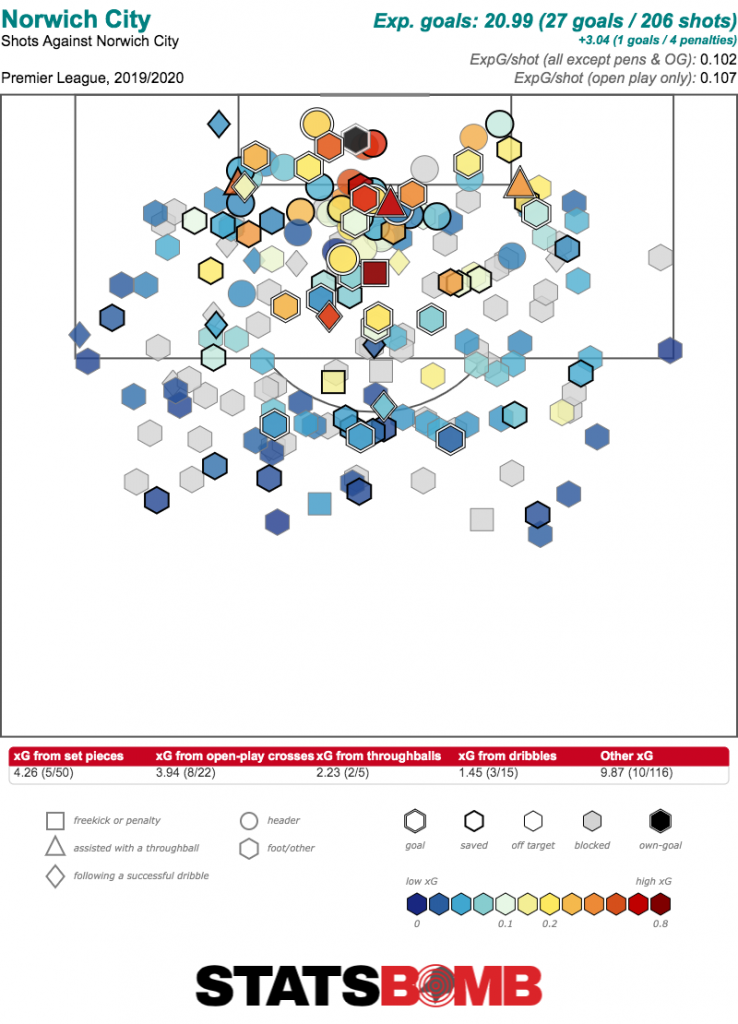
On the attacking end, the Canaries have again underperformed a touch, looking like a fairly middling Premier League team on this side of the ball.
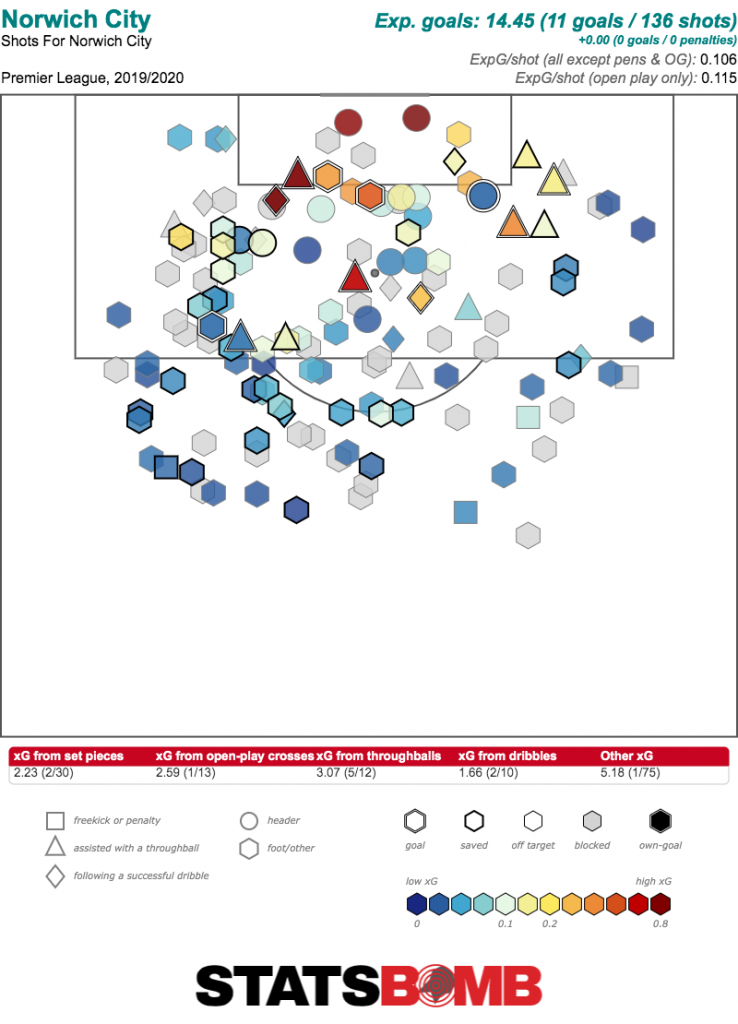
Put the two together and you have a team that might not be the very worst in the Premier League, but one that is certainly part of that conversation, and finds itself already at a points disadvantage.
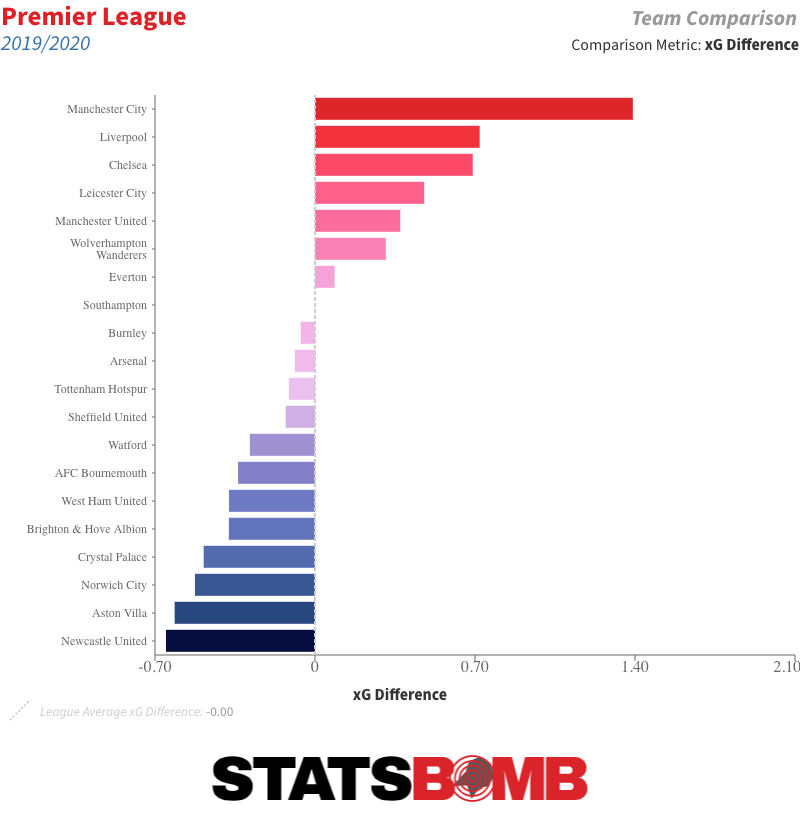
In attack, the biggest story is that Teemu Pukki’s goals have dried up. The temptation is to put this down to either a bad finishing run or an xG fall off, and the truth is both are involved. Pukki has generated 2.35 xG since mid-September without scoring a goal. But he’s also taking nearly a whole shot fewer per 90, and they’re of lesser quality than before. His touches inside the box have increased, but for whatever reason, he’s having a more difficult time turning those into good chances.

Emiliano Buendía is a slightly different case. Yes, his xG assisted, in particular, is down because he has been less of an attacking threat since mid-September. But his radar shows he's being tasked with more defensive work than before.

When looking at his passing sonars, it’s obvious a shift has taken place. In the more recent fixtures (right), he’s passing the ball in deeper areas more frequently, but still doing a good job of moving the ball forward. You might argue that this isn't what fans want him to be doing, but it doesn’t seem like the player is at fault.
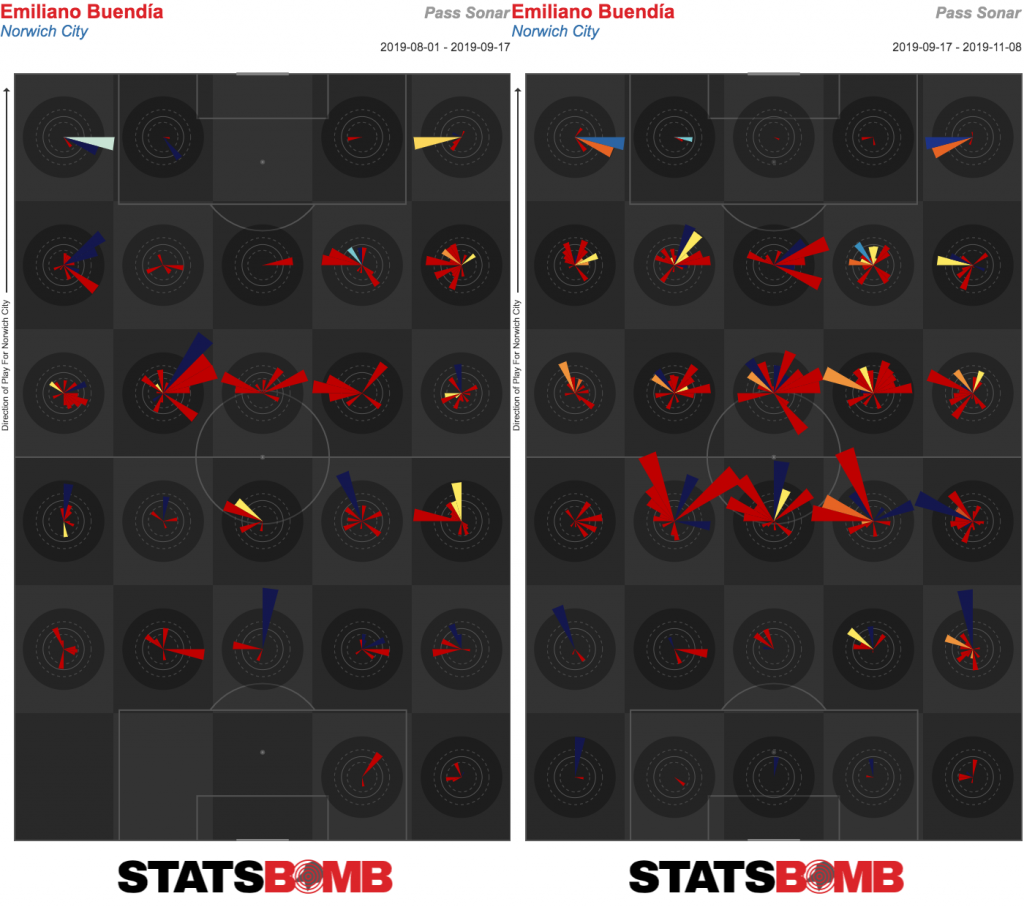
As for Todd Cantwell, the other attacking player who generated excitement, his fall off is rather more predictable. A not insignificant part of his early good form came from a ludicrously unsustainable xG per shot, which has since dropped. Yet Cantwell remains a positive contributor and there shouldn’t be too many concerns about him coming down to Earth a bit.
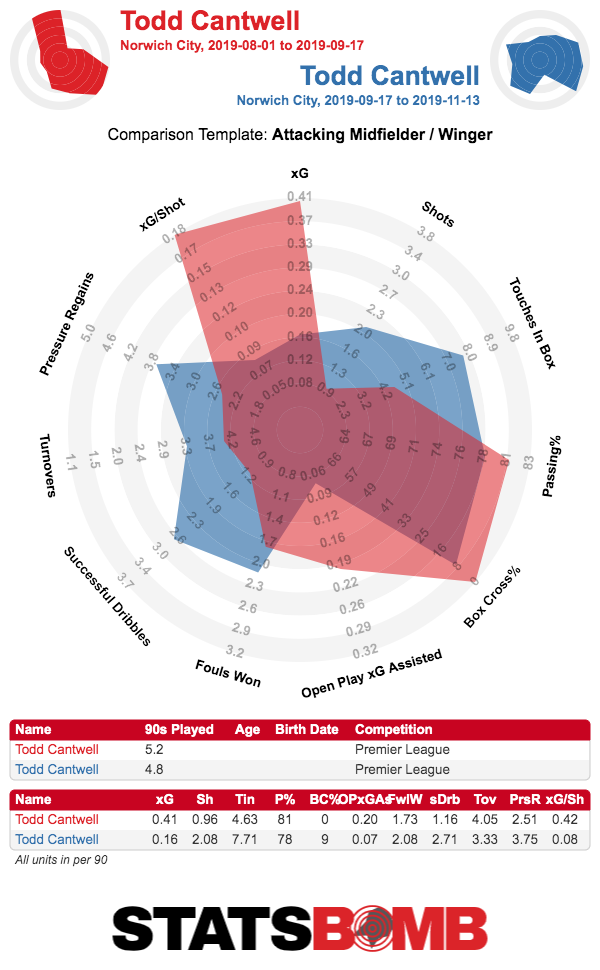
On the defensive end, things are confusing. Norwich are, in theory, a side that wants to press and control the game in the opposition half. But you can’t do that if you can’t get the ball over the halfway line. Their defensive activity map depicts a team constantly forced to defend in their own half.
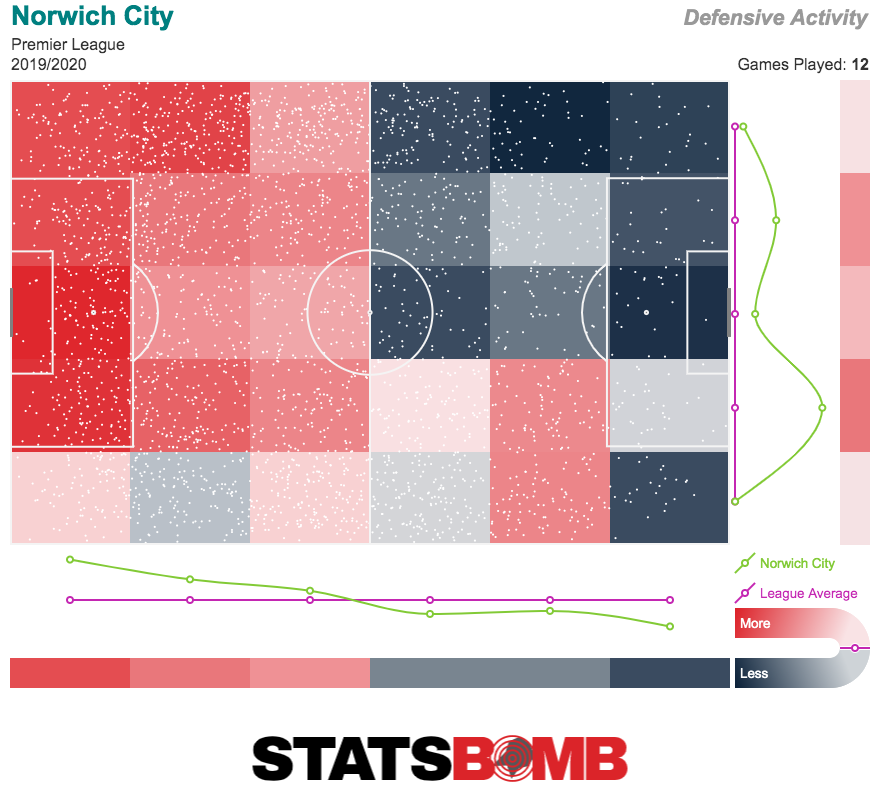
In fairness, they don’t do an awful job of keeping the ball out of their own box. Their 33 passes conceded inside the box is the 12th best in the league, rather better than their 18th best xG conceded. There are those who believe that Norwich’s defenders are not of the required ability for the Premier League, and while this is difficult to quantify, the degree to which teams seem to be able to turn situations in the box into good shots against the Canaries supports this.
Norwich might make a great case study showing the problems with playing possession football against generally superior opponents. A side like Man City are capable of penning teams into their own half as they work the ball into dangerous areas, with opponents often unable to counter because they just can’t get out. Norwich, on the other hand, attempt to play the same type of football, but have not been able to dictate their games in any meaningful way. Instead, what we see most frequently is the side in their own third, starting elaborate sequences to play out from the back. Norwich’s brightest moments have come from these passages of play, but if you’re constantly having to start play from your own third, you might start to question your methods.
The question is how much the club, from owners Delia Smith and Michael Wynn-Jones to Director of Football Stuart Webber, are wedded to this approach. If they are, then there shouldn’t be much doubt that manager Daniel Farke stays in the job. The Canaries appear to be a properly drilled side who understand what they’re being asked to do but are finding they’re not able to to it at the Premier League level. Considering how little the club spent this summer, it’s entirely reasonable to believe they plan to accept relegation and rebuild the squad with their parachute payments. Farke has shown enough in his time at Carrow Road that he’s a more-than-reasonable choice to continue this project and attempt to bring the side back up next season in the Championship.
However, if the Norwich hierarchy believes that avoiding relegation is the first, second and only priority, a change might need to be made. Considering Farke’s decent work, it would need to be someone who brings a very different style to the pitch. If one takes the view that the Canaries’ centre backs are well short of being good enough, then the new approach would have the squad play in a way that gives the defenders much more protection. The obvious risk is that if they still go down, they’d effectively be building a new project from scratch in the Championship next season, so don’t be shocked if Farke hangs on even if results do not improve.
Stats of Interest
Which player outside of Liverpool and Manchester City has the best open play xG assisted per 90 minutes this season? Why, it’s Andriy Yarmolenko, who appears to have been hooked to the rejuvenation machine.
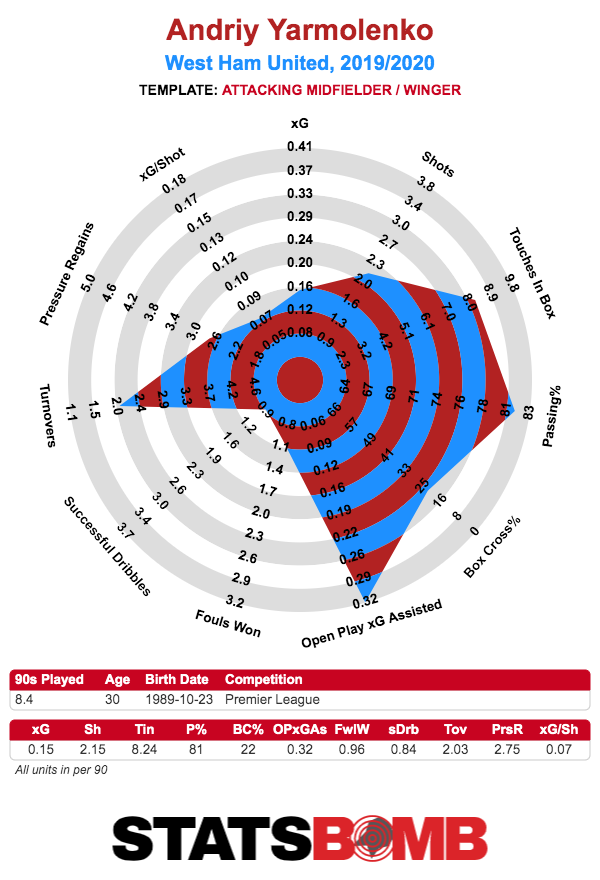
He is able to carve open teams to allow for some terrific chances from the right flank. Only one assist so far, but he could easily add to this in the coming weeks.
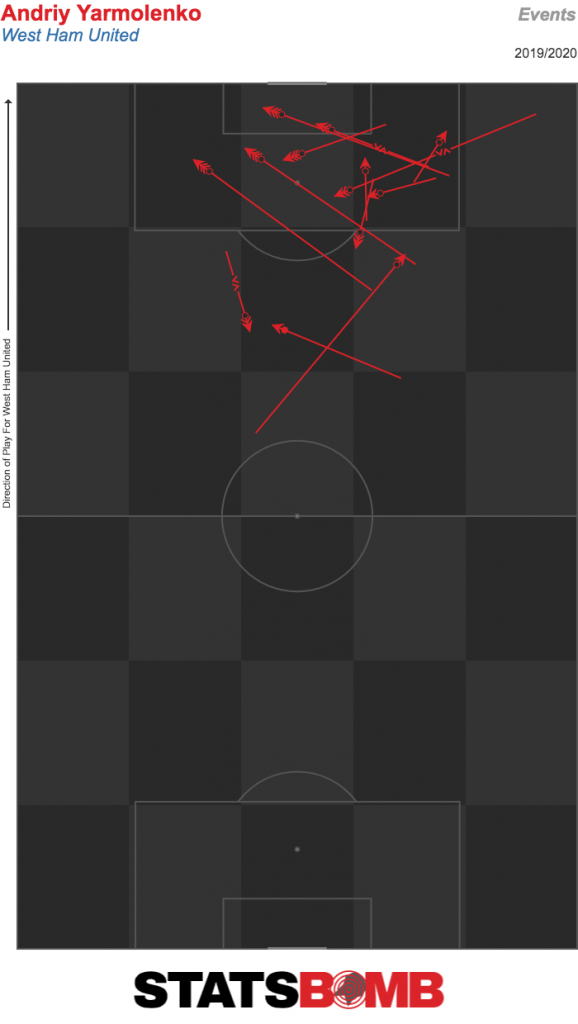
It was reported over the summer that Manchester City were recruiting a specialist set-piece coach, with former Brentford employee Nicholas Jover seemingly getting the job. On the attacking side, the impact is significant. Guardiola’s men have put up a higher xG per set piece than any other side in the Premier League. We’re dealing with a small sample size here, but something real might be happening.
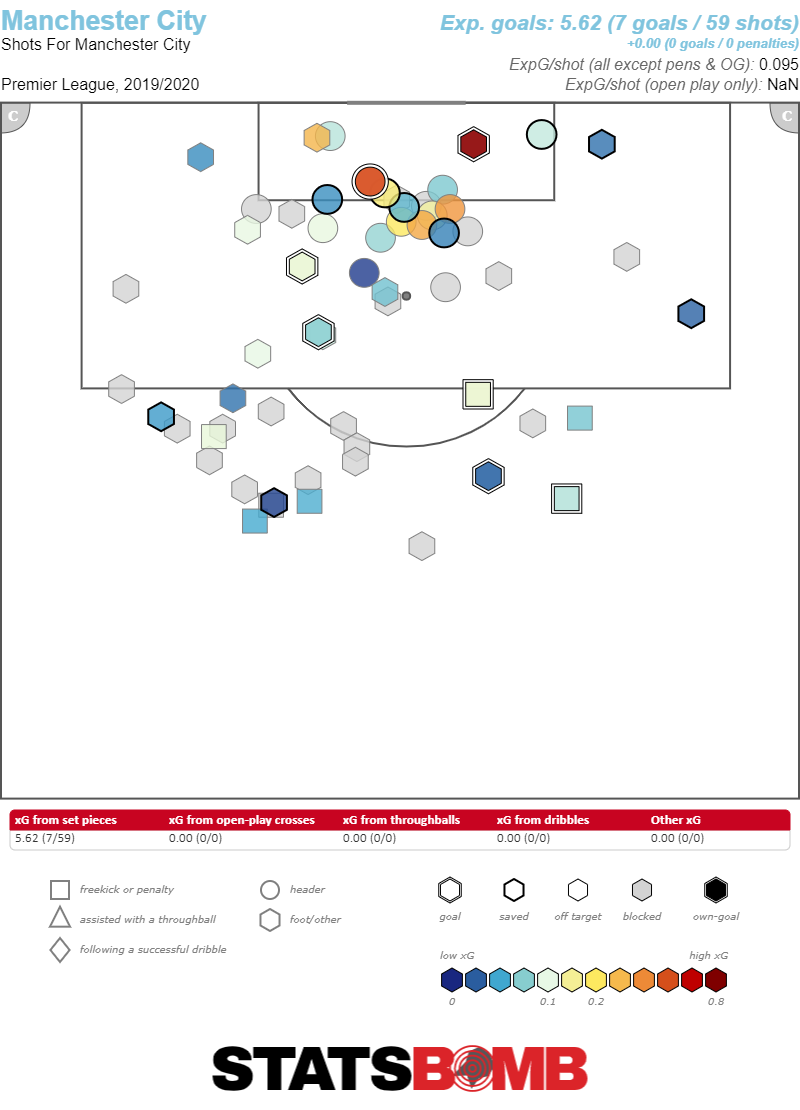
Jamie Vardy started the season on fire in front of goal, with the man himself claiming he’s in the form of his life. Sorry to ruin your fun, Jamie, but not so fast. Vardy’s xG per 90 is actually down from last season (0.34 compared to 0.43) and has been boosted by an astonishing finishing run. He should enjoy it now, because it’s very rare to go on a run of scoring 10 non-penalty goals from 25 shots.
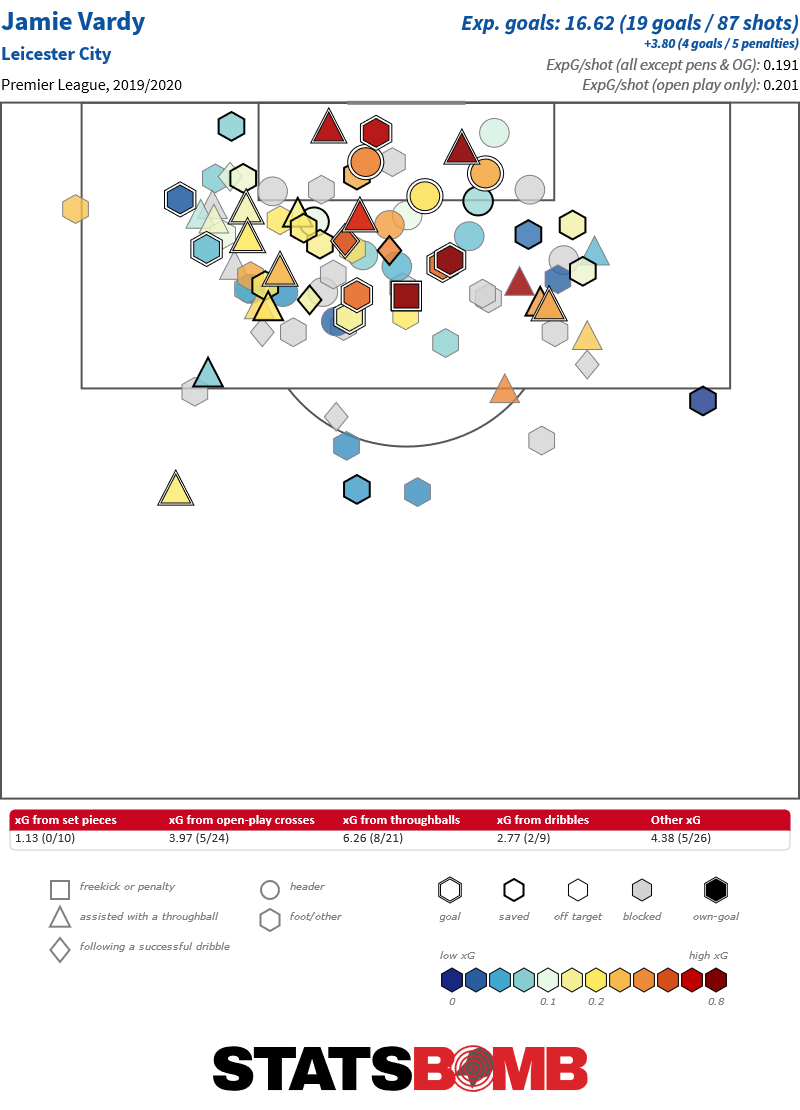
Header image courtesy of the Press Association
Everton are fine. There is, of course, considerable angst about their table position. They sit in 15th place after 12 games, which is certainly not ideal. However, even that perch is better than 17th, the spot they clung to before last weekend’s victory over Southampton. But, contrary to the well-worn phrase, position isn’t everything in life. Everton may be sitting in 15th but they've accumulated 14 points. That’s only three points behind fifth-place Sheffield United. The middle of the Premier League table is extremely congested this season. Two teams have 17 points, three have 16, four have 15 and Everton are accompanied by Tottenham Hotspur on 14. With the midtable brimming with respectable sides, how things look now are certainly not how things will look in a month or two, or even after the games resume in two weeks’ time. Should Everton start winning games, they're likely to fly up the table in a hurry. The real question is, will they start winning games? There’s good news on that front as well. Everton’s lack of points so far this season is not particularly reflective of their underlying performances. In fact, by expected goals, the Toffees seem more like a Europa League level side than a relegation battler. A quick look at their non-penalty xG difference shows they are the sixth most effective team in the Premier League. 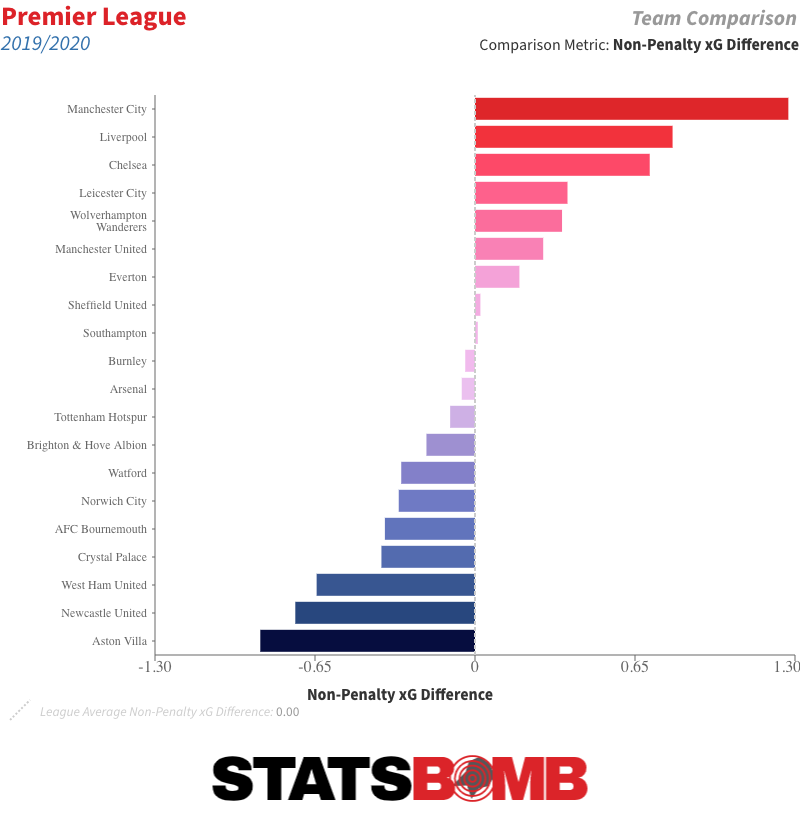 The underlying numbers, at least, show Everton are competent on both sides of the ball. They have the fifth-highest non-penalty xG in the Premier League at 1.32 per match, and the eighth-best non-penalty xG conceded mark at 1.10. These are the kinds of numbers you’d expect from a team competing for a Europa League spot, which at only two points off of seventh place, they technically are. Another way to interpret Everton’s start is to look at the trendlines over the last couple of years. A ten-game rolling average of their xG and xG conceded shows that after playing extremely well at the end of last season, Everton is struggling to keep up their on-fire form. Yet at the same time, there are no real long-term concerns, the trendlines are moving in the right direction, and by and large, Marco Silva has his squad getting the better of things, at least when it comes to expectations.
The underlying numbers, at least, show Everton are competent on both sides of the ball. They have the fifth-highest non-penalty xG in the Premier League at 1.32 per match, and the eighth-best non-penalty xG conceded mark at 1.10. These are the kinds of numbers you’d expect from a team competing for a Europa League spot, which at only two points off of seventh place, they technically are. Another way to interpret Everton’s start is to look at the trendlines over the last couple of years. A ten-game rolling average of their xG and xG conceded shows that after playing extremely well at the end of last season, Everton is struggling to keep up their on-fire form. Yet at the same time, there are no real long-term concerns, the trendlines are moving in the right direction, and by and large, Marco Silva has his squad getting the better of things, at least when it comes to expectations. 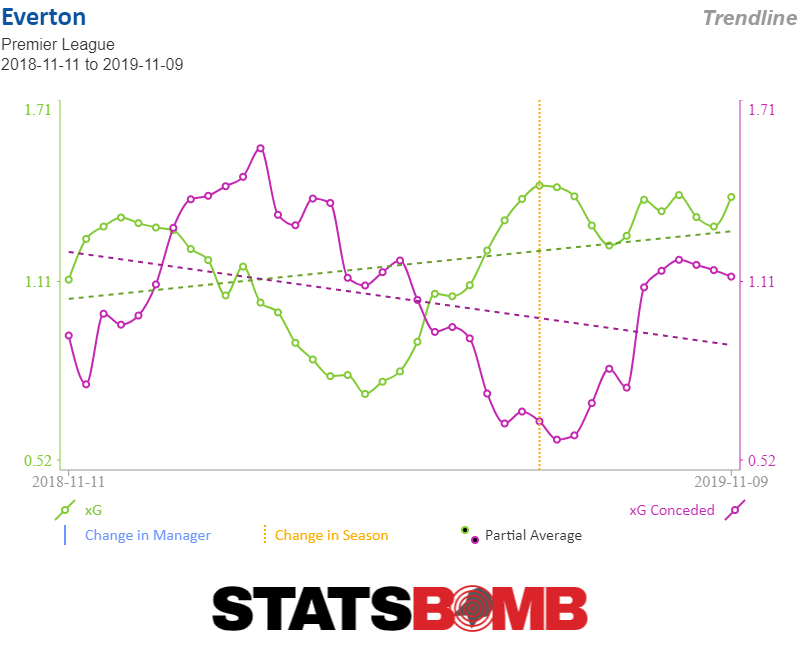 The real problem for Everton is that while their xG has drifted downward from its sky-high perch at the end of last season, their actual goal difference has plummeted. The team is playing somewhat worse, but they’re really getting kicked in the teeth by results. Some of Everton’s lacking point total really is just down to easily identifiable bad luck. There’s not much you can do about finding yourself on the wrong side of a VAR call against Brighton that the Premier League later acknowledged was incorrect. These things might even themselves out in the long run, but 12 games is certainly not the long run.
The real problem for Everton is that while their xG has drifted downward from its sky-high perch at the end of last season, their actual goal difference has plummeted. The team is playing somewhat worse, but they’re really getting kicked in the teeth by results. Some of Everton’s lacking point total really is just down to easily identifiable bad luck. There’s not much you can do about finding yourself on the wrong side of a VAR call against Brighton that the Premier League later acknowledged was incorrect. These things might even themselves out in the long run, but 12 games is certainly not the long run. 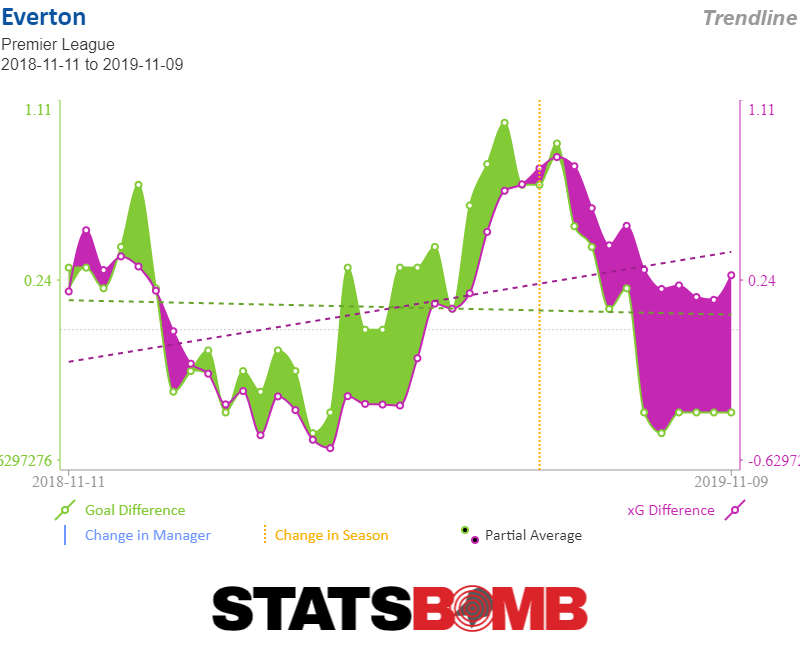 There are, of course, times when xG is misleading, when a fine-grained analysis of tactical choices and personnel decisions will reveal tangible reasons for a team’s actual goals diverging from their expected goals. This doesn’t appear to be one of those times. The team profiles as a fairly typical high pressing aggressive defense. They do most of their defending in the opposition half.
There are, of course, times when xG is misleading, when a fine-grained analysis of tactical choices and personnel decisions will reveal tangible reasons for a team’s actual goals diverging from their expected goals. This doesn’t appear to be one of those times. The team profiles as a fairly typical high pressing aggressive defense. They do most of their defending in the opposition half. 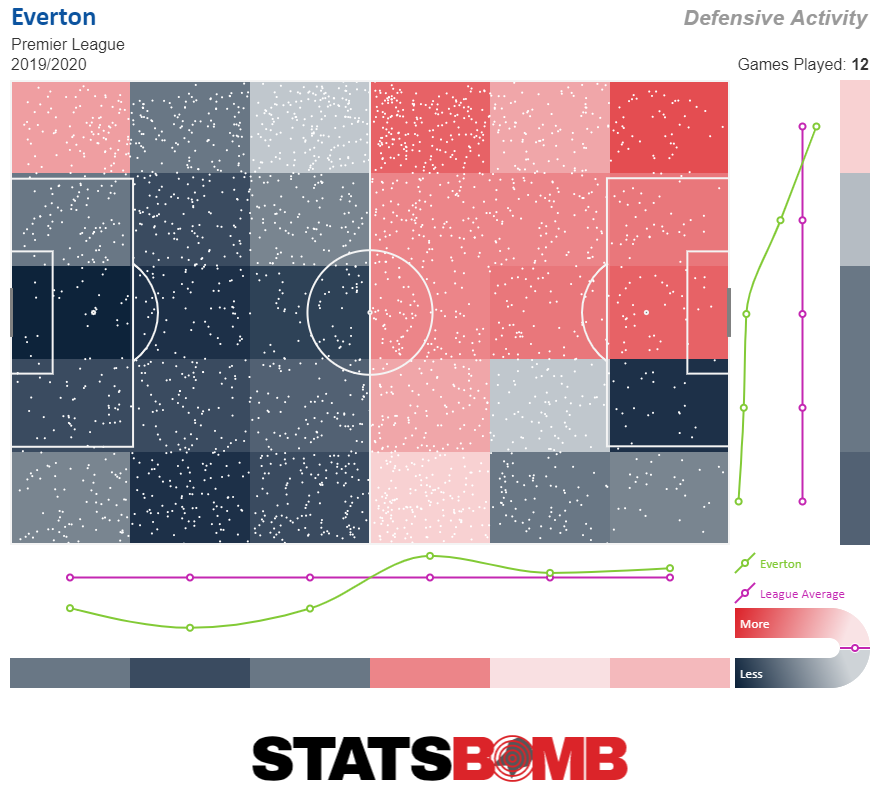 That high press is generally effective, and Everton concede very few shots. Only Manchester City’s 7.42 shots conceded per game ranks below Everton’s 8.42. But, as often happens with aggressive defenses, when the press is broken, Everton’s soft underbelly is exposed. Everton, on average, allow extremely high-quality shots through. Only two teams, Manchester City (again with the aggressive pressing sides) and West Ham, give up higher xG per shot conceded than Everton’s 0.13. Put all those numbers together and it comes out to 13.43 non-penalty xG conceded, but they’ve conceded 17.
That high press is generally effective, and Everton concede very few shots. Only Manchester City’s 7.42 shots conceded per game ranks below Everton’s 8.42. But, as often happens with aggressive defenses, when the press is broken, Everton’s soft underbelly is exposed. Everton, on average, allow extremely high-quality shots through. Only two teams, Manchester City (again with the aggressive pressing sides) and West Ham, give up higher xG per shot conceded than Everton’s 0.13. Put all those numbers together and it comes out to 13.43 non-penalty xG conceded, but they’ve conceded 17. 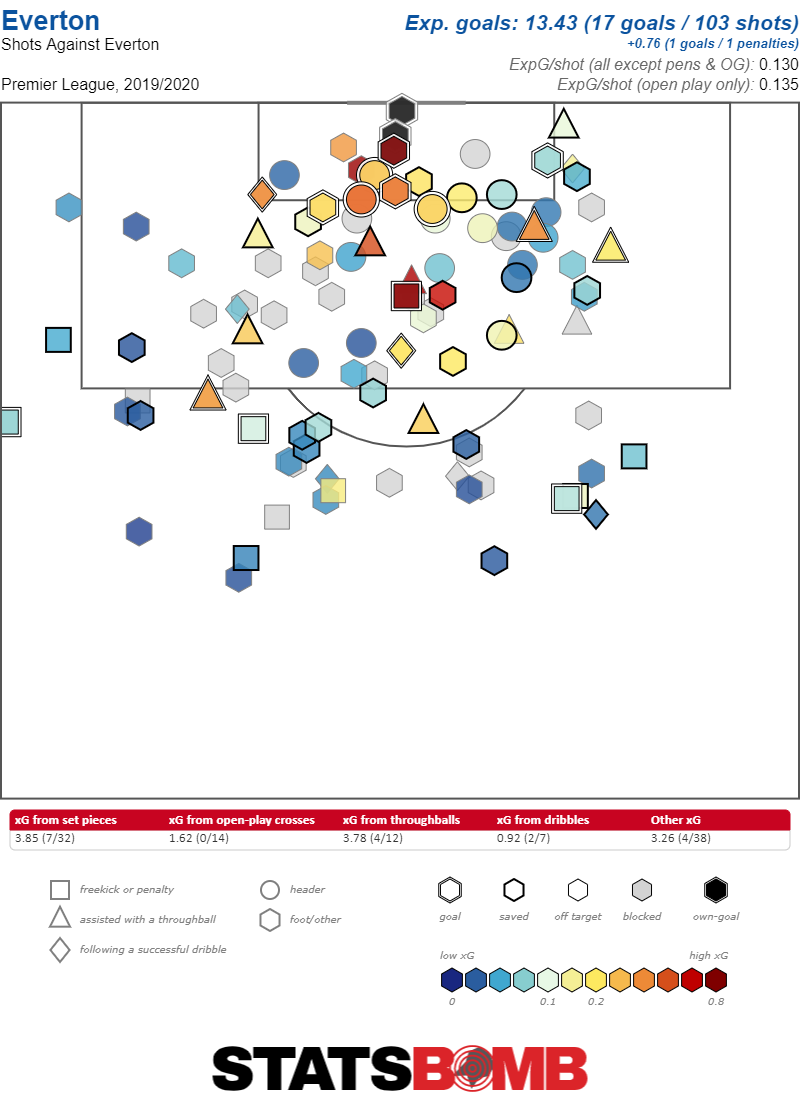 Part of the disconnect is that they’ve conceded two own goals. Own goals are not terribly predictive in and of themselves; even if it might be tempting to suggest they are more likely to happen to a team facing constant pressure, that’s simply not an argument that history supports. So, the fact that Everton have been the victims of two while benefiting from just one is the kind of thing that, again, will work itself out over time. The rest of the difference comes from the fact that Everton’s opponents have put good strikers on the ball. Their opponents have a post-shot xG that’s about a goal higher than their basic xG. Everton keeper Jordan Pickford has had to go flying around his net, where he’s been mostly average at keeping shots out. There’s not a whole lot a team can do when their opponents just keep hitting it sweetly, except, again, trust that the soccer gods are fickle and everybody’s luck turns eventually.
Part of the disconnect is that they’ve conceded two own goals. Own goals are not terribly predictive in and of themselves; even if it might be tempting to suggest they are more likely to happen to a team facing constant pressure, that’s simply not an argument that history supports. So, the fact that Everton have been the victims of two while benefiting from just one is the kind of thing that, again, will work itself out over time. The rest of the difference comes from the fact that Everton’s opponents have put good strikers on the ball. Their opponents have a post-shot xG that’s about a goal higher than their basic xG. Everton keeper Jordan Pickford has had to go flying around his net, where he’s been mostly average at keeping shots out. There’s not a whole lot a team can do when their opponents just keep hitting it sweetly, except, again, trust that the soccer gods are fickle and everybody’s luck turns eventually. 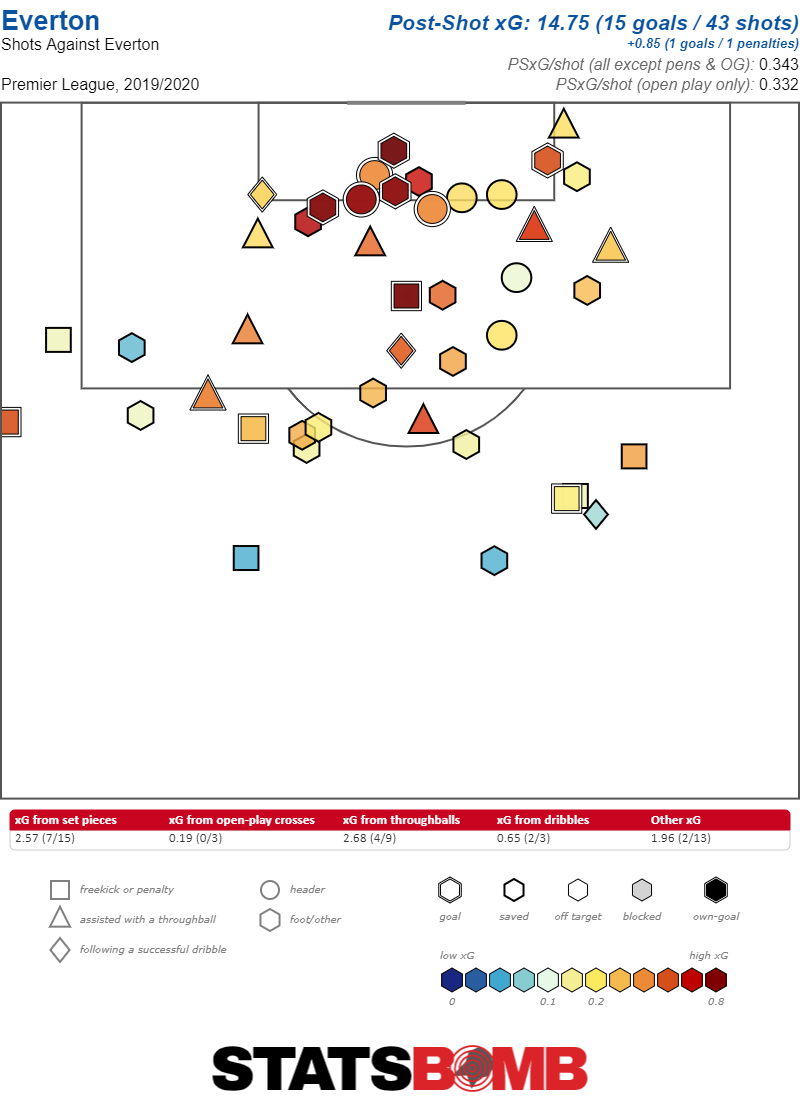 The story is similar on the attacking side of the ball. Everton have been playing well. They’ve created the sixth-most shots in the league, 13.42 per match, at a fairly average xG per shot rate of 0.10, tied for 13th in the Premier League. It’s not the most dynamic way to play, but piling up lots of average shots is a perfectly reasonable way to score goals. The problem is that, again, while the xG is good, 16.07, the actual goals, 13, lag behind. However, as on the defensive side of the ball, a closer examination shows that most of what’s gone wrong is simply that the strikers have run into a number of strong goalkeeper performances. Everton’s post-shot xG is virtually identical to their pre-shot xG, but they’ve only scored 12 goals. That’s as a clear a distillation of keeper performance as you’ll ever see. Everton’s opponents have made a handful of great saves and it’s cost the Toffees points.
The story is similar on the attacking side of the ball. Everton have been playing well. They’ve created the sixth-most shots in the league, 13.42 per match, at a fairly average xG per shot rate of 0.10, tied for 13th in the Premier League. It’s not the most dynamic way to play, but piling up lots of average shots is a perfectly reasonable way to score goals. The problem is that, again, while the xG is good, 16.07, the actual goals, 13, lag behind. However, as on the defensive side of the ball, a closer examination shows that most of what’s gone wrong is simply that the strikers have run into a number of strong goalkeeper performances. Everton’s post-shot xG is virtually identical to their pre-shot xG, but they’ve only scored 12 goals. That’s as a clear a distillation of keeper performance as you’ll ever see. Everton’s opponents have made a handful of great saves and it’s cost the Toffees points. 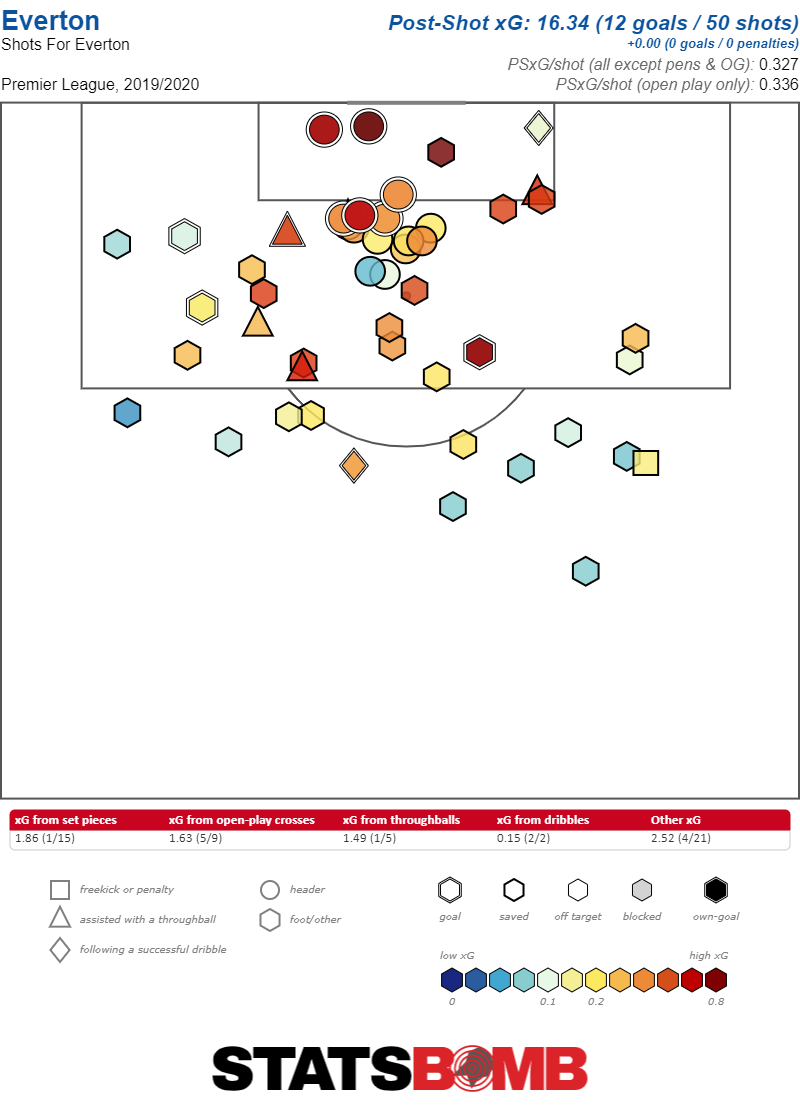 Through 12 games, Everton represent as clear an example of good process and bad results as you’re ever likely to find in the wild. If they keep doing what they’re doing, their results are almost certain to improve. Of course, that’s easier said than done. Playing well but losing is cold comfort, and the league doesn't hand out titles for best process. It is exceedingly difficult to watch your best-laid plans succeed for three months, find yourself nailed to the bottom third of the table, and remain steadfast in your faith that those plans did, in fact, succeed. Everton shouldn’t fire Silva, but they’d be far from the first team to lose faith in a manager after a string of poor results from fine performances. And Silva shouldn’t change the way he sets his team up, but again, better managers than him have reached for solutions to non-existent problems after results didn’t go their way. Up and down the organization, the numbers make it clear that now is the time for both management and the manager to show faith in the project. And that faith is going to be sorely tested, because when the international break ends, Everton get the gift of facing relegation-fodder Norwich City, and then it’s the murderer’s row of the current Premier League top three, with Leicester and Liverpool away followed by Chelsea at Goodison Park. The first 12 games of the season haven’t been an easy time for Everton, but the way forward is clear. As long as they keep playing like this, and their manager is able to keep the performances at the level they’ve been to date, things will improve. And as stern as the tests on the field over the next month will be, the most difficult exam will occur off the pitch. Will Everton be able to keep a steady hand and keep doing the right things, or will bad results ultimately prove too much for a good process to overcome? The answer to that question will define the Toffees' season. Header image courtesy of the Press Association
Through 12 games, Everton represent as clear an example of good process and bad results as you’re ever likely to find in the wild. If they keep doing what they’re doing, their results are almost certain to improve. Of course, that’s easier said than done. Playing well but losing is cold comfort, and the league doesn't hand out titles for best process. It is exceedingly difficult to watch your best-laid plans succeed for three months, find yourself nailed to the bottom third of the table, and remain steadfast in your faith that those plans did, in fact, succeed. Everton shouldn’t fire Silva, but they’d be far from the first team to lose faith in a manager after a string of poor results from fine performances. And Silva shouldn’t change the way he sets his team up, but again, better managers than him have reached for solutions to non-existent problems after results didn’t go their way. Up and down the organization, the numbers make it clear that now is the time for both management and the manager to show faith in the project. And that faith is going to be sorely tested, because when the international break ends, Everton get the gift of facing relegation-fodder Norwich City, and then it’s the murderer’s row of the current Premier League top three, with Leicester and Liverpool away followed by Chelsea at Goodison Park. The first 12 games of the season haven’t been an easy time for Everton, but the way forward is clear. As long as they keep playing like this, and their manager is able to keep the performances at the level they’ve been to date, things will improve. And as stern as the tests on the field over the next month will be, the most difficult exam will occur off the pitch. Will Everton be able to keep a steady hand and keep doing the right things, or will bad results ultimately prove too much for a good process to overcome? The answer to that question will define the Toffees' season. Header image courtesy of the Press Association
It’s the first top of the table clash of the season and, to the surprise of many, the reigning champions are behind. The results shaking out the way they have mean that Jürgen Klopp’s Liverpool enter the fixture six points ahead of Pep Guardiola’s Manchester City. Such is the strength of City that the bookmakers generally give Liverpool an implied probability of only 54-58% to win the title, with City expected to at least close the gap over the rest of the season. This is what makes this Sunday such a knife edge: a nine point deficit could easily be too much to bridge. So how did we get here? Well, perhaps not as one might assume. In terms of expected goals, City are still crushing the league. On the attacking side, they’re generating 60% more expected goals than Liverpool while only looking slightly worse on the defensive end. In xG difference, it’s Guardiola’s Premier League and we’re just living in it. 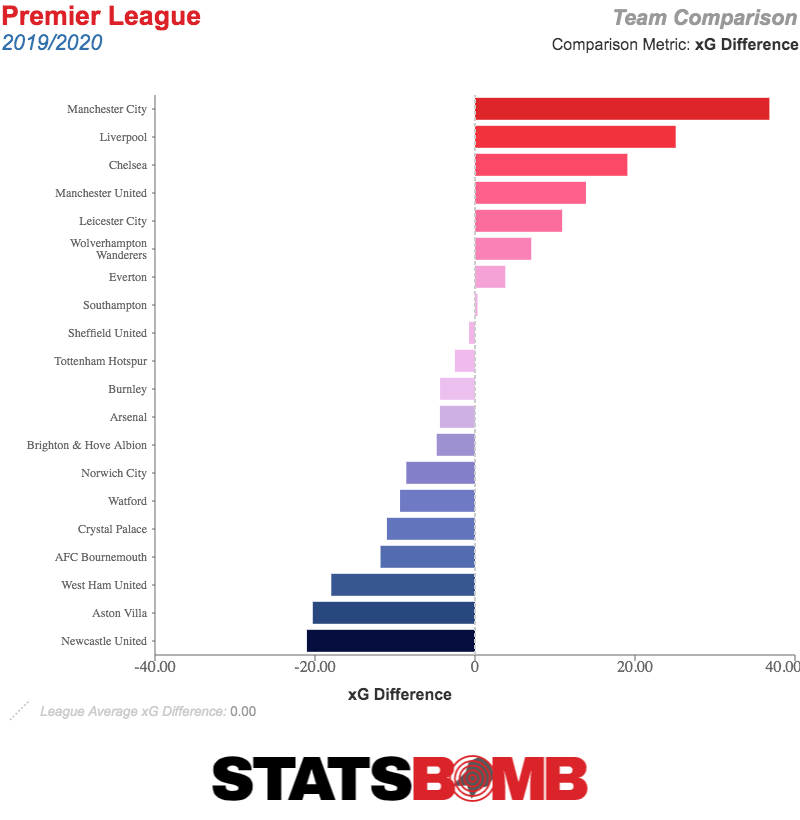 That shouldn’t imply that there are not real reasons why City have had a few wobbles, though. The defensive team radar comparing this season to last about sums up their struggles on that side of the ball: City are now a higher pressing side than ever, but at the same time are conceding chances of better quality than ever before, and have paid the price more than once.
That shouldn’t imply that there are not real reasons why City have had a few wobbles, though. The defensive team radar comparing this season to last about sums up their struggles on that side of the ball: City are now a higher pressing side than ever, but at the same time are conceding chances of better quality than ever before, and have paid the price more than once. 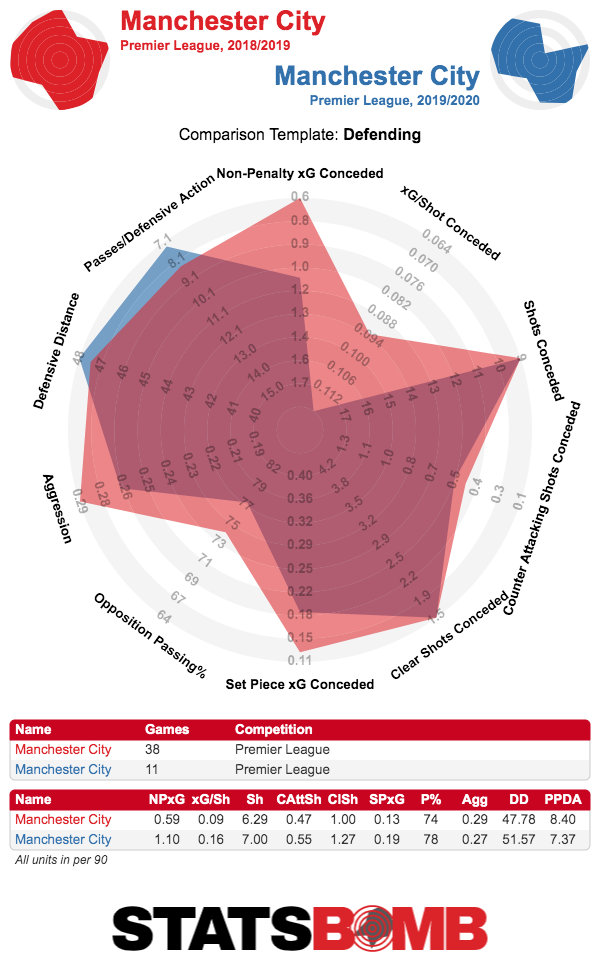 City’s central problem is that they’ve struggled to “cheat” the problems of a high press and prevent getting cut open in occasional moments when something goes wrong. I wrote about this in greater depth a month ago, but since then, Guardiola has tweaked things in hope of stopping the leak. The 4-4-2/4-2-3-1 shape he was experimenting with seems to have been shelved for now in favour of the tried and trusted 4-3-3, but this time with İlkay Gündoğan at the base of the midfield rather than Rodri (who now appears to be an option, at least in desperate times, at centre back). City have played three Premier League games since this switch, which is far too small a sample size to make huge conclusions, but the early evidence is good, even if they’re overperforming xG by quite a bit.
City’s central problem is that they’ve struggled to “cheat” the problems of a high press and prevent getting cut open in occasional moments when something goes wrong. I wrote about this in greater depth a month ago, but since then, Guardiola has tweaked things in hope of stopping the leak. The 4-4-2/4-2-3-1 shape he was experimenting with seems to have been shelved for now in favour of the tried and trusted 4-3-3, but this time with İlkay Gündoğan at the base of the midfield rather than Rodri (who now appears to be an option, at least in desperate times, at centre back). City have played three Premier League games since this switch, which is far too small a sample size to make huge conclusions, but the early evidence is good, even if they’re overperforming xG by quite a bit. 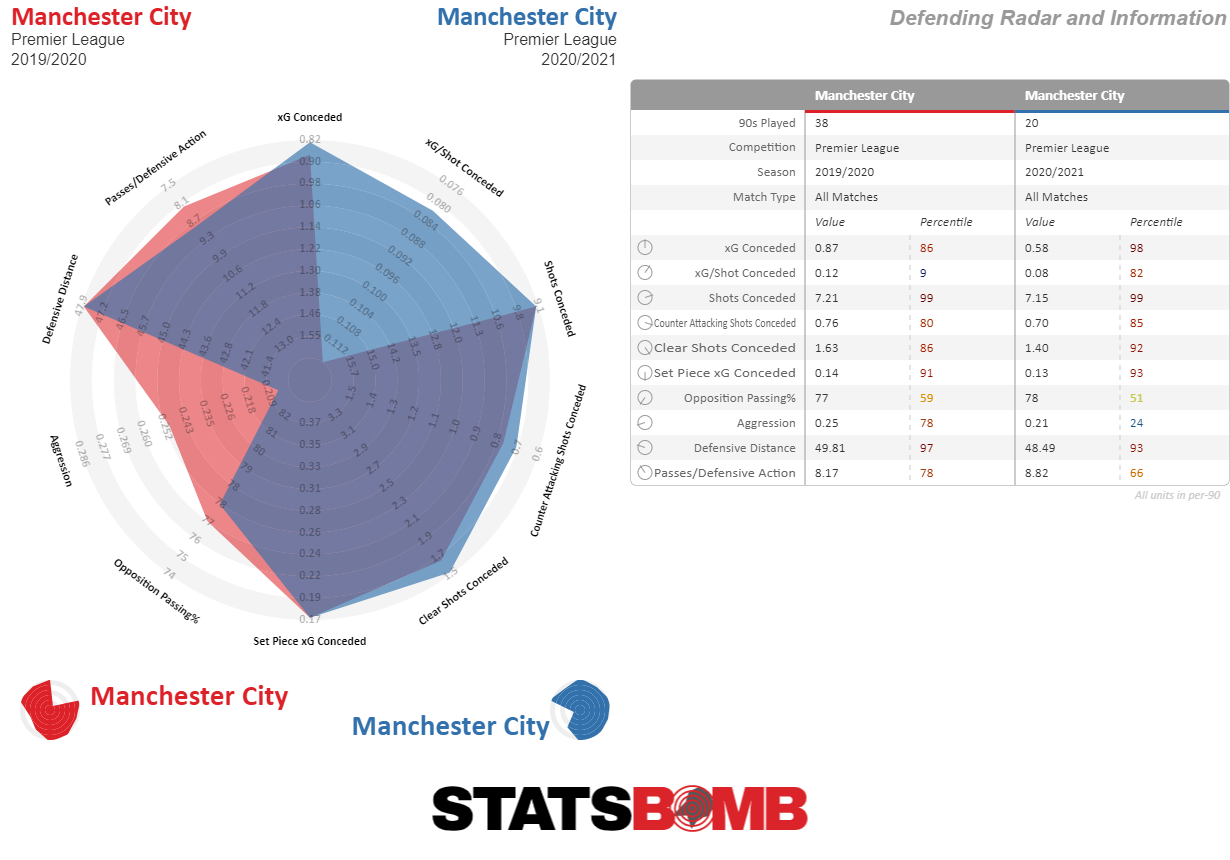 In this very small sample, the shots conceded per game has stayed consistent with what came before at seven, but the xG per shot conceded has fallen from 0.17 to a more manageable 0.13. To be very clear, we’re only talking a couple of shots being placed slightly differently here, so we shouldn't get ahead of ourselves, but it’s more the sort of stability that City had in the previous two seasons. If Gundogan is really to be the main defensive midfielder in this side rather than Rodri, then questions open up about his suitability in filling the role formerly held by Fernandinho. The Brazilian is often talked about for his genuine ability at tactical fouling, making around 1.6 fouls per 90 last season, but Gundogan has not generally managed anything like that rate in his career, failing to hit more than 1 per 90 in any of the seasons for which StatsBomb has collected data. He’s never been able to put in as many tackles and interceptions at the rate of Fernandinho. And for a role that in this particular system requires range and mobility, Gundogan’s injury record raises real concerns.
In this very small sample, the shots conceded per game has stayed consistent with what came before at seven, but the xG per shot conceded has fallen from 0.17 to a more manageable 0.13. To be very clear, we’re only talking a couple of shots being placed slightly differently here, so we shouldn't get ahead of ourselves, but it’s more the sort of stability that City had in the previous two seasons. If Gundogan is really to be the main defensive midfielder in this side rather than Rodri, then questions open up about his suitability in filling the role formerly held by Fernandinho. The Brazilian is often talked about for his genuine ability at tactical fouling, making around 1.6 fouls per 90 last season, but Gundogan has not generally managed anything like that rate in his career, failing to hit more than 1 per 90 in any of the seasons for which StatsBomb has collected data. He’s never been able to put in as many tackles and interceptions at the rate of Fernandinho. And for a role that in this particular system requires range and mobility, Gundogan’s injury record raises real concerns.  On the other side, the results just keep coming for Liverpool. An xG conceded per game of 0.96 is better than City’s, and only Leicester are outdoing it in the Premier League this season, but it’s still worse than last year’s 0.75. There’s better news beyond the xG. Liverpool are conceding fewer deep completions and fewer opposition passes inside the box than ever before. The passes inside the box tally is less than half the next best Premier League side or even the Liverpool of last season. It might just be that opposing attackers have been particularly adept at turning dangerous situations into shots. Liverpool might be as good as ever defensively, but it’s hard to say either way for sure.
On the other side, the results just keep coming for Liverpool. An xG conceded per game of 0.96 is better than City’s, and only Leicester are outdoing it in the Premier League this season, but it’s still worse than last year’s 0.75. There’s better news beyond the xG. Liverpool are conceding fewer deep completions and fewer opposition passes inside the box than ever before. The passes inside the box tally is less than half the next best Premier League side or even the Liverpool of last season. It might just be that opposing attackers have been particularly adept at turning dangerous situations into shots. Liverpool might be as good as ever defensively, but it’s hard to say either way for sure. 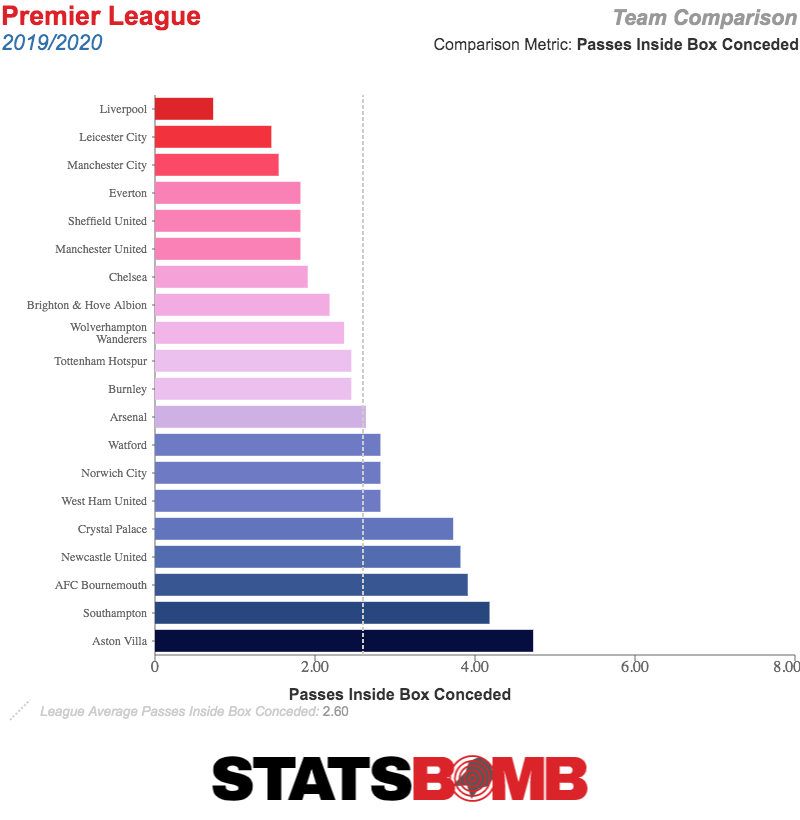 On the attacking side, Liverpool’s output looks largely consistent with last year, and it’s the way they do it that has drawn the most attention. The way Klopp instructs his side to attack is to move the ball from the fullbacks into the front three, ignoring almost any notion of creative passing through midfield. In terms of progressing the ball into the final third, the two fullbacks, Trent Alexander-Arnold and Andrew Robertson, lead the way along with Fabinho. When it comes to open passes into the box, it’s the fullbacks again with Sadio Mane. The two number eights, Gini Wijnaldum and Jordan Henderson, just don’t play important parts in moving the ball forward for Liverpool. Alexander-Arnold in particular is really becoming the side’s most important playmaker, putting up a monster 0.36 xG assisted per 90 (albeit including set pieces). Liverpool are able to play this way because their fullbacks are so useful in possession, and the defensive end stays solid because the midfielders are given so little freedom. The template for Liverpool vs Manchester City games has been well established at this point. City play their usual intricate football of working the ball through the midfield, into the “free eights” and to the wide players to attempt create their exquisite chances, while Liverpool engage in a counter-press, attempt to win the ball and attack when City are in a poor shape counterattack down the half spaces. It’s a tactical rhythm that feels predictable now, and if the game pans out this way, both sides should have a fair few chances with the magic of finishing to perhaps be the deciding factor. There are two games between the sides in recent seasons that didn’t fall into that pattern, however. The first was City’s 5-0 drubbing of Liverpool at the Etihad in September 2017. The most important moment of that match was Mane’s first half sending off, which forced Liverpool to retreat and largely just defend their own goal, which they did poorly. Barring any unexpected reckless challenges, it doesn’t seem like that game is hugely relevant to this one. The other fixture, though, was last season’s October 0-0 draw at Anfield. This one was very unusual in that Guardiola seemed content with taking a point. The two sides combined for all of 12 non-penalty shots, none of them particularly good chances, and every neutral went home disappointed. It might be that the Catalan feels six points is too big a gap to take a draw, but this scenario is entirely on the table and could lead to another underwhelming encounter. The case for City settling for the point, for trusting that they can bridge the six point gap over the season, is in the numbers. City have been playing better football than Liverpool first and foremost, yes, but they’ve also been playing more attacking football. A more expansive game should, in theory, be the more effective way of picking up a huge points total when facing teams of lower ability than themselves. Liverpool’s much less expansive approach relies on keeping it tighter and wearing down the opposition as things go on, with lower scoring fixtures. City’s approach should be capable of overpowering just about everyone. Even in situations where they concede, it’s a question of how many goals you need to score to get a point against City. The case that they need the win here is in the fixture list. Liverpool have already faced Chelsea, Tottenham, Manchester United and, if we’re expanding the scope of the elite club to seven, Leicester. This game will complete the set of fixtures against the “big teams” for Klopp’s side in the first half of the season. City, by comparison, have only faced Tottenham of this group so far. The fixture list gets real across November and December, and City will need to be near perfect in these games if Liverpool do not provide serious slip ups. It’s well within their capability to do so (especially taking into account that performances so far this season raise serious questions about just how elite various members of the elite group of seven are), but Guardiola wouldn’t be making life easy for himself if he didn’t close the gap to three points on Sunday. If Liverpool were to win, a gap of nine points would certainly create a different dynamic. Klopp’s team could conceivably ease off a touch and still have a very good chance of winning the title. City could play their best football and still fail to lift the trophy in May. It is for that reason that playing it safe is on the cards for Guardiola. Header image courtesy of the Press Association
On the attacking side, Liverpool’s output looks largely consistent with last year, and it’s the way they do it that has drawn the most attention. The way Klopp instructs his side to attack is to move the ball from the fullbacks into the front three, ignoring almost any notion of creative passing through midfield. In terms of progressing the ball into the final third, the two fullbacks, Trent Alexander-Arnold and Andrew Robertson, lead the way along with Fabinho. When it comes to open passes into the box, it’s the fullbacks again with Sadio Mane. The two number eights, Gini Wijnaldum and Jordan Henderson, just don’t play important parts in moving the ball forward for Liverpool. Alexander-Arnold in particular is really becoming the side’s most important playmaker, putting up a monster 0.36 xG assisted per 90 (albeit including set pieces). Liverpool are able to play this way because their fullbacks are so useful in possession, and the defensive end stays solid because the midfielders are given so little freedom. The template for Liverpool vs Manchester City games has been well established at this point. City play their usual intricate football of working the ball through the midfield, into the “free eights” and to the wide players to attempt create their exquisite chances, while Liverpool engage in a counter-press, attempt to win the ball and attack when City are in a poor shape counterattack down the half spaces. It’s a tactical rhythm that feels predictable now, and if the game pans out this way, both sides should have a fair few chances with the magic of finishing to perhaps be the deciding factor. There are two games between the sides in recent seasons that didn’t fall into that pattern, however. The first was City’s 5-0 drubbing of Liverpool at the Etihad in September 2017. The most important moment of that match was Mane’s first half sending off, which forced Liverpool to retreat and largely just defend their own goal, which they did poorly. Barring any unexpected reckless challenges, it doesn’t seem like that game is hugely relevant to this one. The other fixture, though, was last season’s October 0-0 draw at Anfield. This one was very unusual in that Guardiola seemed content with taking a point. The two sides combined for all of 12 non-penalty shots, none of them particularly good chances, and every neutral went home disappointed. It might be that the Catalan feels six points is too big a gap to take a draw, but this scenario is entirely on the table and could lead to another underwhelming encounter. The case for City settling for the point, for trusting that they can bridge the six point gap over the season, is in the numbers. City have been playing better football than Liverpool first and foremost, yes, but they’ve also been playing more attacking football. A more expansive game should, in theory, be the more effective way of picking up a huge points total when facing teams of lower ability than themselves. Liverpool’s much less expansive approach relies on keeping it tighter and wearing down the opposition as things go on, with lower scoring fixtures. City’s approach should be capable of overpowering just about everyone. Even in situations where they concede, it’s a question of how many goals you need to score to get a point against City. The case that they need the win here is in the fixture list. Liverpool have already faced Chelsea, Tottenham, Manchester United and, if we’re expanding the scope of the elite club to seven, Leicester. This game will complete the set of fixtures against the “big teams” for Klopp’s side in the first half of the season. City, by comparison, have only faced Tottenham of this group so far. The fixture list gets real across November and December, and City will need to be near perfect in these games if Liverpool do not provide serious slip ups. It’s well within their capability to do so (especially taking into account that performances so far this season raise serious questions about just how elite various members of the elite group of seven are), but Guardiola wouldn’t be making life easy for himself if he didn’t close the gap to three points on Sunday. If Liverpool were to win, a gap of nine points would certainly create a different dynamic. Klopp’s team could conceivably ease off a touch and still have a very good chance of winning the title. City could play their best football and still fail to lift the trophy in May. It is for that reason that playing it safe is on the cards for Guardiola. Header image courtesy of the Press Association
The top of the Premier League’s individual expected goals per 90 table is full of all the usual suspects. Exactly half of the top ten (among players with at least 600 minutes on the pitch) are players you’d guess on the first try. Sergio Aguero is still better at scoring goals than everybody. Everybody knows by now that Tammy Abraham is having a star making season. Raheem Sterling, Mohammed Salah, and Sadio Mané are all elite scorers from the wing. They’re all there. But, mixed in are another five players, players who might surprise and amaze you. These are their stories.
Danny Ings: The xG paper tiger
Every year Danny Ings spends part of the season popping up as a surprisingly formidable attacking player. And seemingly every year he squanders his chances, then gets hurt then everybody forgets about him until he starts the next year off in a similarly promising fashion. Ings is once again rocking the attacking production. He’s averaging 0.53 non-penalty xG per 90 minutes. That’s third in the league. He’s doing it by averaging a bunch of shots, 2.94, the ninth highest total in the league and making sure they’re good ones, among players who hit the minutes cutoff and take at least a shot per 90 his 0.18 xG is eight. Imagine Tammy Abraham, take away roughly one shot per match, and that’s what Danny Ings’s numbers look like. As per usual with Ings there’s the caveat that while he’s played the requisite number of minutes, he’s still been used intermittently and has seen less playing time than anybody else in the top ten. 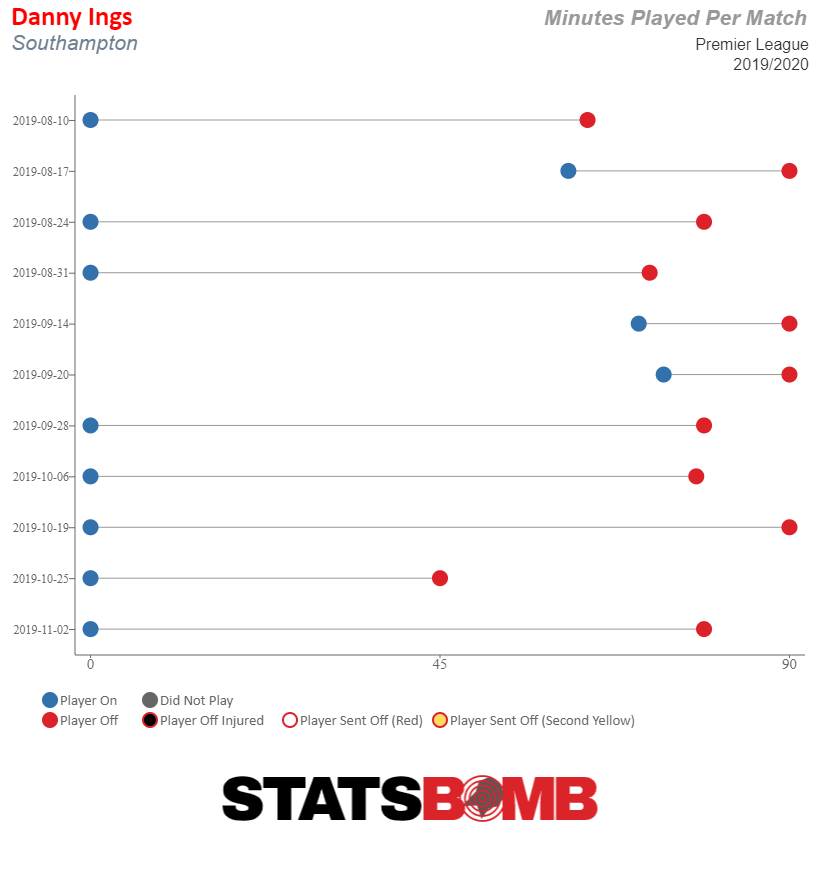 That means we’re only talking about a little over 4 xG and 23 total shots. Still, though, they’re really good shots.
That means we’re only talking about a little over 4 xG and 23 total shots. Still, though, they’re really good shots.
 Chris Wood and Ashley Barnes: The dynamic duo
Chris Wood and Ashley Barnes: The dynamic duo
If you’re looking for pairs of elite scorers Manchester City has them all. Aguero and Sterling top the list. After them it’s Aguero and Bernardo Silva, followed by Aguero and David Silva. Then it’s Sterling and Silva, and Sterling and the other Silva. City have the top five pairs. Then, its Salah and Mané who combine for 0.91 xG per 90. But just behind those two. It’s who comes next that’s stunning. Burnley’s set of, apparently world beating strikers, Chris Wood and Ashley Barnes clock in at a combined 0.90 are barely outscored by Liverpool's wingers. The two of them are well matched. Wood shoots less frequently, only 2.00 times per match, the third least frequent shooter of any in the top 20 of xG per 90, but his 0.23 xG per shot is extraordinary. 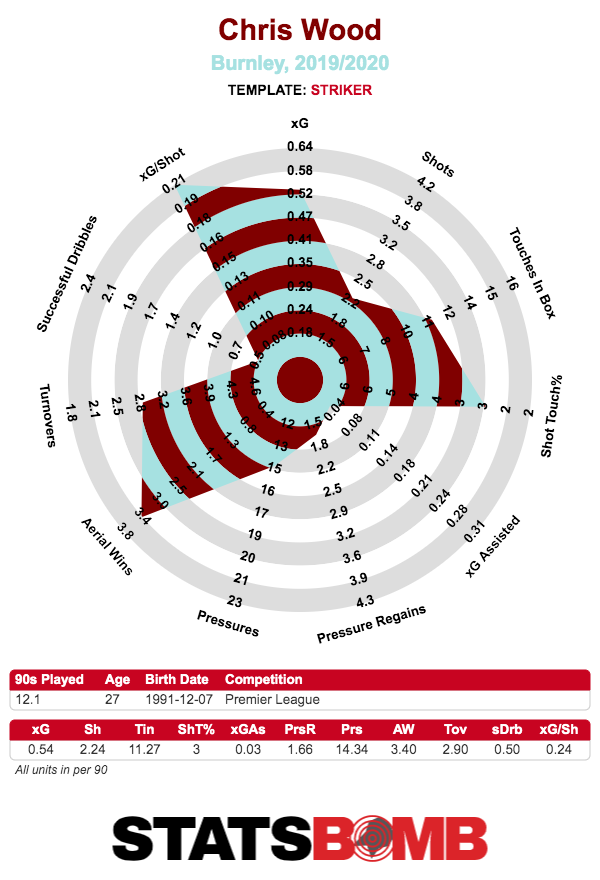 Barnes on the other hand both shoots more, and from somewhat more varied positions, with 3.23 shots per 90 and a still respectfully robust 0.14 xG per shot.
Barnes on the other hand both shoots more, and from somewhat more varied positions, with 3.23 shots per 90 and a still respectfully robust 0.14 xG per shot. 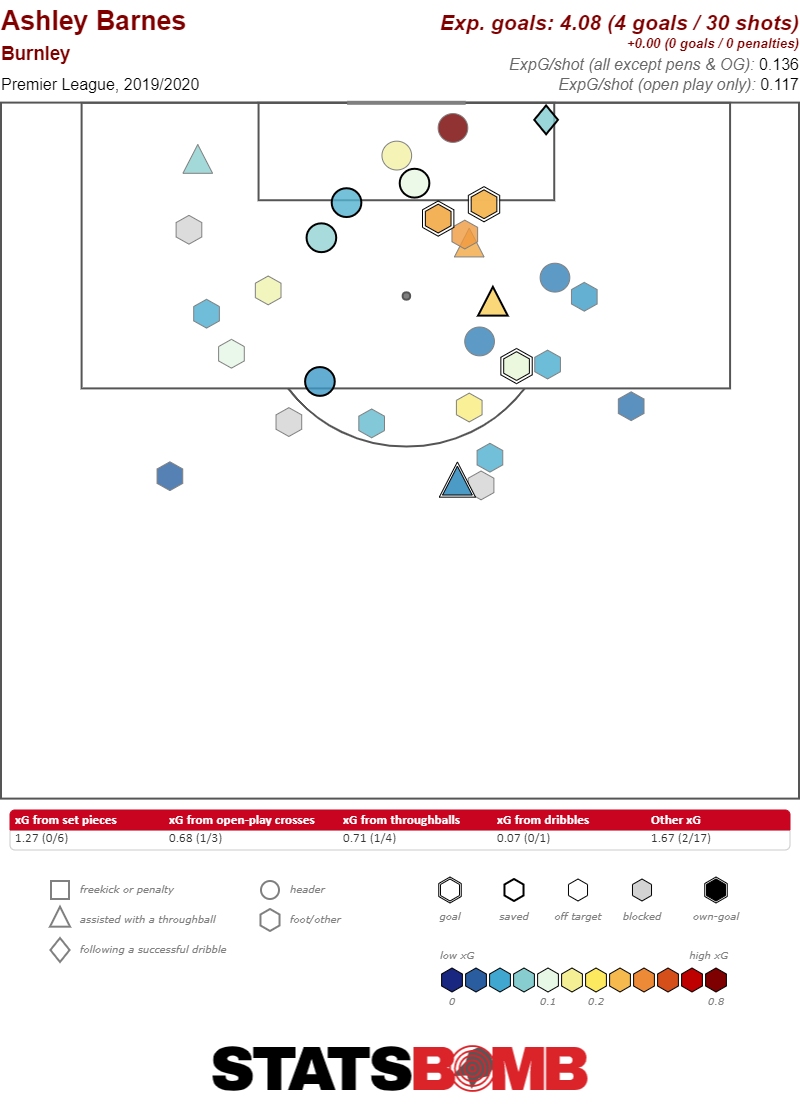 What really makes the Barnes and Wood show so incredible is that Burnley only averages 1.14 xG total per match. It’s really just the two of them holding down the attacking fort.
What really makes the Barnes and Wood show so incredible is that Burnley only averages 1.14 xG total per match. It’s really just the two of them holding down the attacking fort. 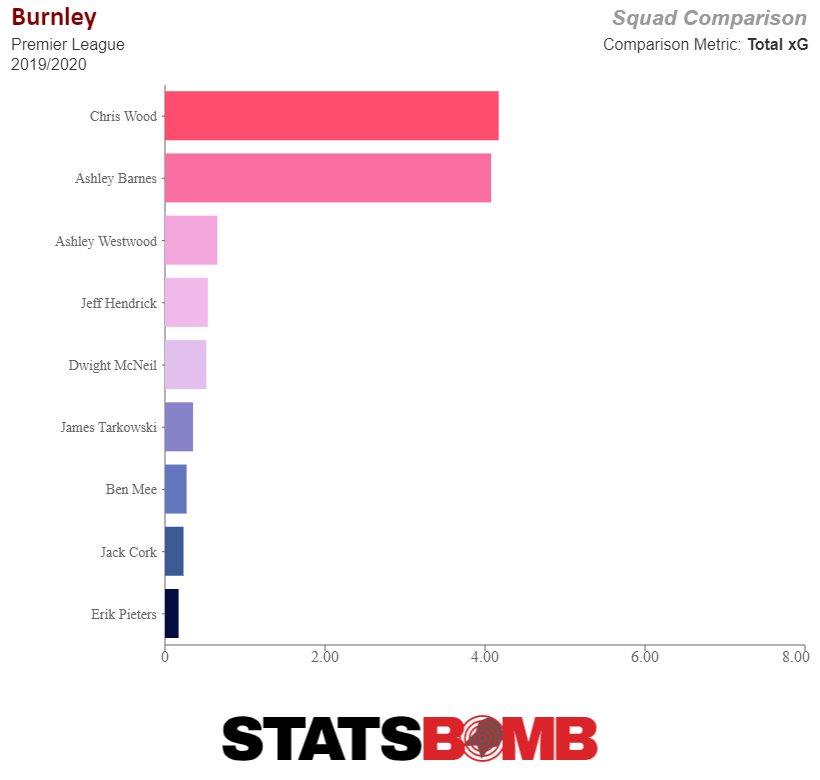 Obviously, City, who have four different players appearing in the top five two-man combinations, aren’t nearly as narrowly reliant, and neither are Liverpool. Here’s how their top two stack up with everybody else. Unsurprisingly Liverpool’s big three are in fact a big three and they have help from the fullbacks.
Obviously, City, who have four different players appearing in the top five two-man combinations, aren’t nearly as narrowly reliant, and neither are Liverpool. Here’s how their top two stack up with everybody else. Unsurprisingly Liverpool’s big three are in fact a big three and they have help from the fullbacks. 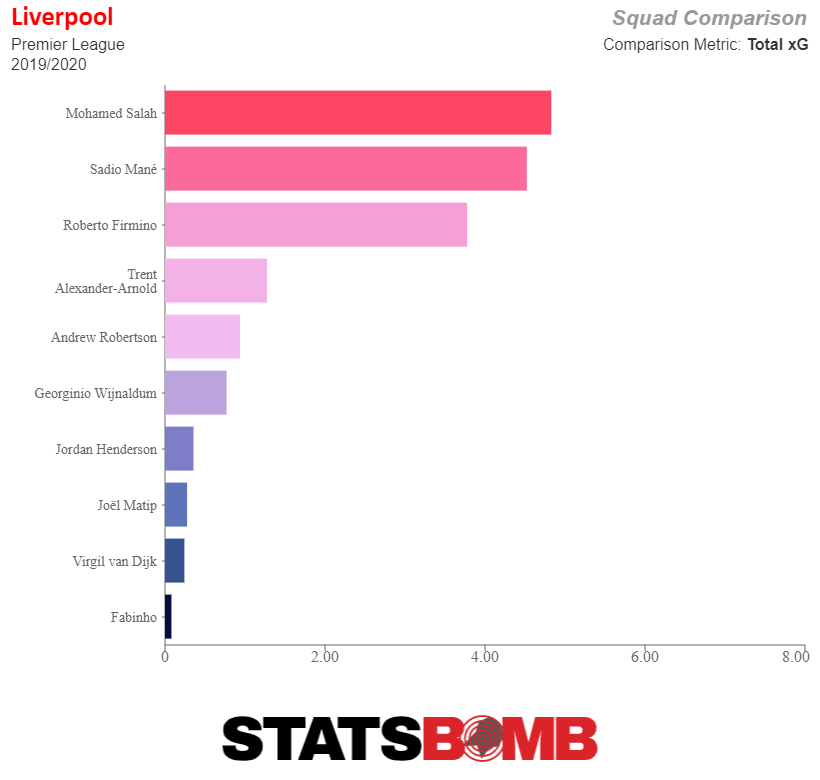 Burnley are a two-man attacking show, and so far this season those two men have been among the best in the league.
Burnley are a two-man attacking show, and so far this season those two men have been among the best in the league.
Neal Maupay: Making the leap at Brighton
It’s easy to miss just how strong Neal Maupay’s start to life at the Premier League level has been. Among the top twenty in xG per 90 only one other player is underperforming their xG total by as much as Maupay who is averaging 0.32 non-penalty goals per 90 against 0.46 xG (though what this means practically given the limited minutes is that he has three goals as opposed to 4.26 xG). He’s in good company though, since the other player significantly under their xG total is Salah. As Brighton’s featured attacker, Maupay shoot a lot, 3.45 times per 90 is fourth most frequent in the Premier League, and while his shot chart can get a little ugly, he keeps the xG per shot at 0.13 which is respectable enough (it is, again, right in line with Salah). 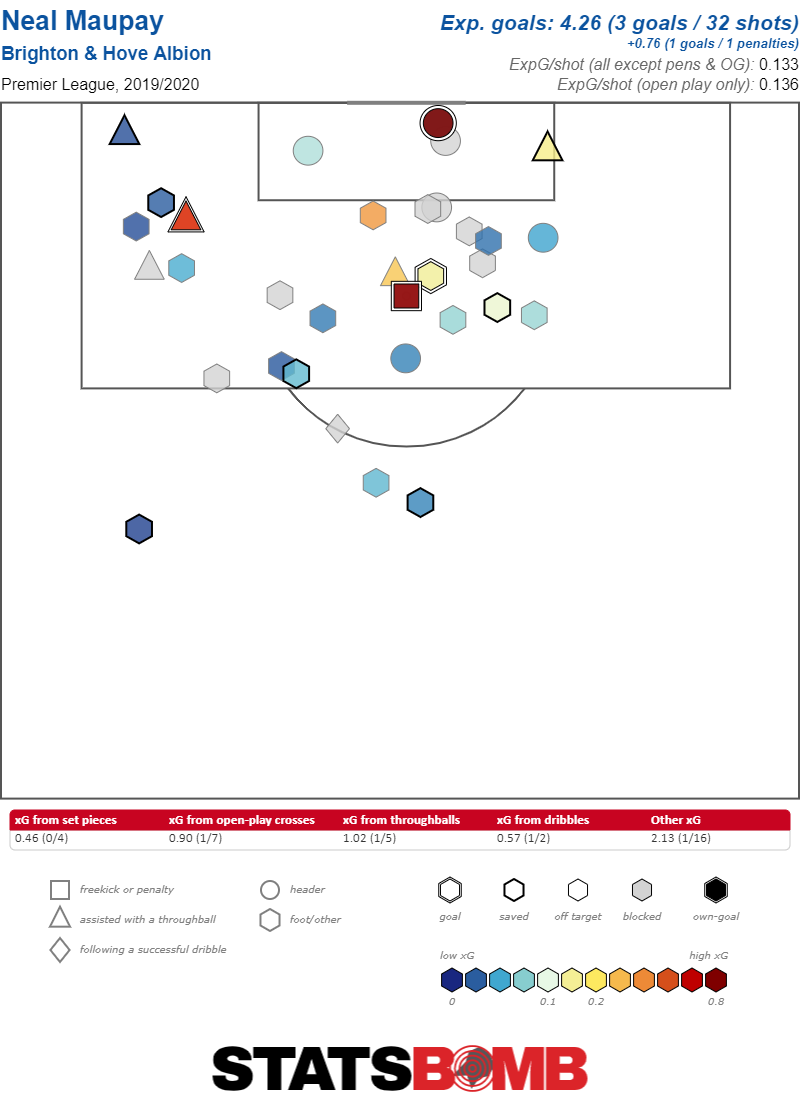 Notably Maupay isn’t just a goal scorer. He’s an acceptable passer, and a defensive contributor as well. It’s still early, of course, but so far he looks like one of the most successful and impactful new signings of the Premier League season.
Notably Maupay isn’t just a goal scorer. He’s an acceptable passer, and a defensive contributor as well. It’s still early, of course, but so far he looks like one of the most successful and impactful new signings of the Premier League season. 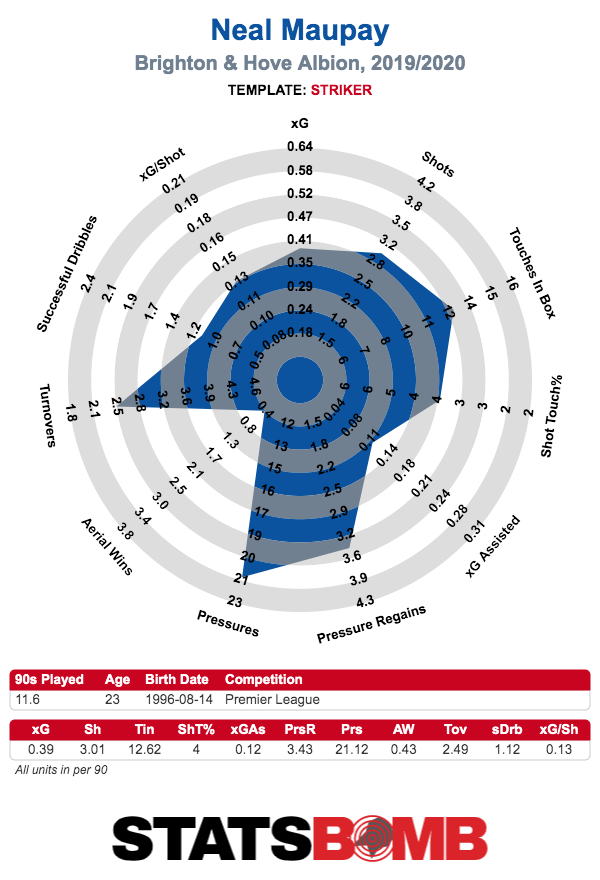
Callum Wilson: Bournemouth’s old reliable
And finally, there’s Callum Wilson. You don’t have to shoot much if when you do shoot, you shot from where Wilson shoots from. The man has five goals from 17 shots, and that’s exactly what xG would predict. Not too shabby. 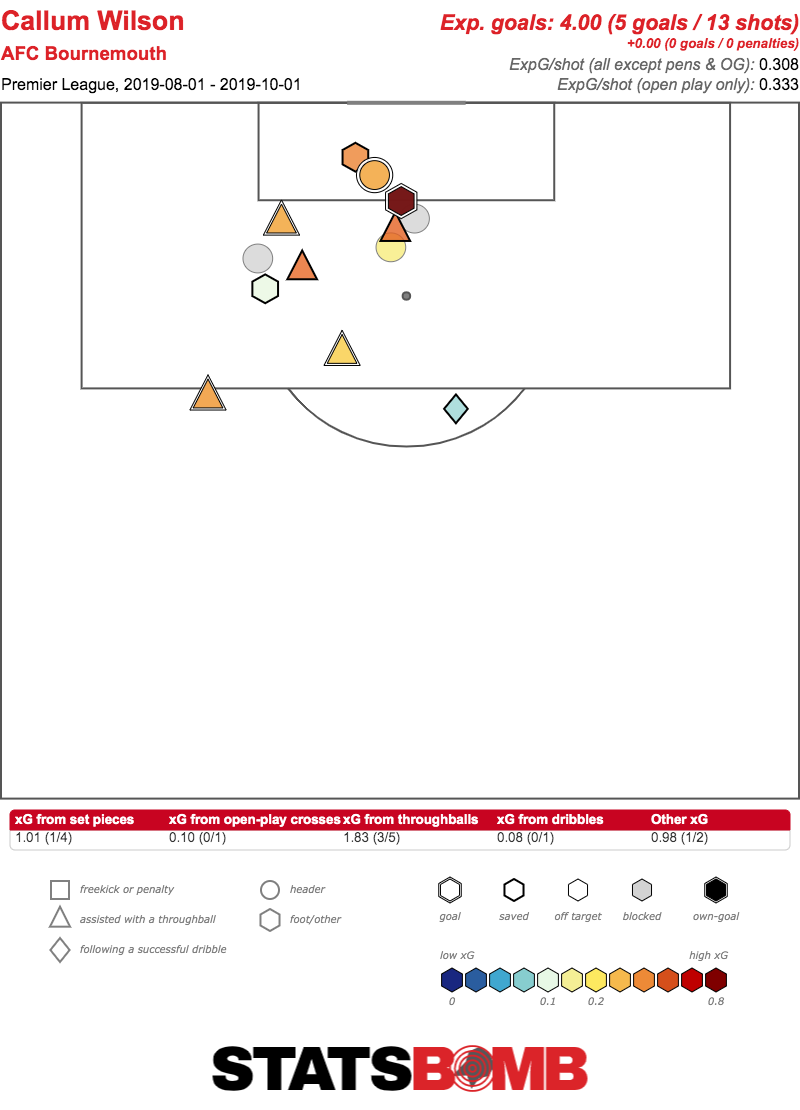
Looking at the table is supposed to provide clarity, right? The Premier League seems to be in a strange place right now. Fifth placed Arsenal (16 points) are closer to Watford at the bottom of the table (5 points) to Liverpool at the top (28). It’s all a big mess and none of it seems to make much sense. So let’s see if we can find some answers in the mulch.
The title race is on?
Liverpool sit six points clear of Manchester City at the top of the table. The main way this has been done is by having a slightly stodgier defence, as the Reds have conceded 9.71 expected goals to City’s 11.35. It hasn’t yet mattered so much that Pep Guardiola’s team have a far stronger attack, generating 27.58 xG to Liverpool’s 16.85. Thus their xG difference looks a whole lot better, despite not translating this into points at quite the same rate.  This doesn’t seem to correlate with what we know about football. City are playing a more open, more high scoring at both ends style than Liverpool. Those kind of games should theoretically lead to the better team winning more frequently. Football’s status as a low scoring sport leads to frequent occasions where the best side does not win, and increasing the scoring should decrease the frequency with which that happens. We haven’t seen it yet. It’s definitely something to watch out for as the season goes on, particularly if Liverpool’s cagier style ever starts producing more draws. Chelsea are hot on the heels of the big two. By xG difference they look only a shade behind Liverpool, though there are still perhaps some ways in which this side is incomplete. The Blues complete relatively few deep completions into the final third, with their 36 so far being below average in the Premier League. They have then turned this into just 21 passes inside the opponent’s box, also below average. The attack has been incredibly effective at turning this lack of passing in dangerous areas into good shots, and it remains to be seen whether this approach can be sustainable.
This doesn’t seem to correlate with what we know about football. City are playing a more open, more high scoring at both ends style than Liverpool. Those kind of games should theoretically lead to the better team winning more frequently. Football’s status as a low scoring sport leads to frequent occasions where the best side does not win, and increasing the scoring should decrease the frequency with which that happens. We haven’t seen it yet. It’s definitely something to watch out for as the season goes on, particularly if Liverpool’s cagier style ever starts producing more draws. Chelsea are hot on the heels of the big two. By xG difference they look only a shade behind Liverpool, though there are still perhaps some ways in which this side is incomplete. The Blues complete relatively few deep completions into the final third, with their 36 so far being below average in the Premier League. They have then turned this into just 21 passes inside the opponent’s box, also below average. The attack has been incredibly effective at turning this lack of passing in dangerous areas into good shots, and it remains to be seen whether this approach can be sustainable.
Can Leicester do a Leicester?
The record equalling 9-0 win at Southampton marks the highlight of a so far very enjoyable season for Foxes fans. In third place with 20 points, and considering the general mediocrity of much of the rest of the league (more on that later), Brendan Rodgers’ team look well in the mix for a top four spot. This is mostly through a mean defence (third best in the league by xG) counting more than a middling attack. But there’s an important asterisk here: Leicester have had two games this season featuring first half red cards to the opposition. In both these matches, the Foxes then went on to demolish their opponents (Southampton and Newcastle). In the time spent just eleven against eleven, Leicester’s xG difference is at -0.38, or -0.04 on a per 90 minute basis. The attack is particularly worrying here, generating just under an expected goal per 90. They have the points in hand, which puts them ahead of the mulch, but the position in the table looks kind right now.
What of Manchester United, Arsenal and Tottenham?
Leicester’s good start has looked all the brighter due to the dimming of half the so-called top six. Arsenal are, somehow, currently the best of these sides in terms of points. In recent weeks they’ve been able to get the shots conceded under control a little more, but this is still just not an interesting team. They’re moderately above average, they don’t have many exciting players, they don’t play a distinct style of football. They’re just there, and could finish anywhere from the top four to midtable in May. Things are looking a little better for Manchester United after they got a moral victory (read: a draw) against Liverpool and a comfortable win at Norwich. And things never looked as bad in the numbers as the results. United have the best xG conceded in the league, combining both a low volume of shots against with a low quality of those chances. The problem is that the pairing of this with the 12th best attack makes them deathly boring at times. It looks as though Paul Pogba’s fitness problems are set to continue, which isn’t good news for anyone who likes football teams with players who can pass the ball forward. As for Tottenham, well, they’re just not very good. The xG trendline of the past few seasons describes it better than I can. This side has had problems for some time, but now it’s really getting ugly. 
The Mulch
The best of this lot might be, surprisingly, Burnley. It used to be that Sean Dyche’s ability to get results defied all metrics, that they could put up terrible numbers and the Englishman was such a warlock that it wouldn’t matter. But right now, the numbers actually look good. The main thing that stands out is that they have the lowest xG per shot conceded in the league by a fair margin. The shot map shows it: even when you work the ball into dangerous areas against Burnley, your shots end up as cheap headers or situations with a lot of bodies in the way. 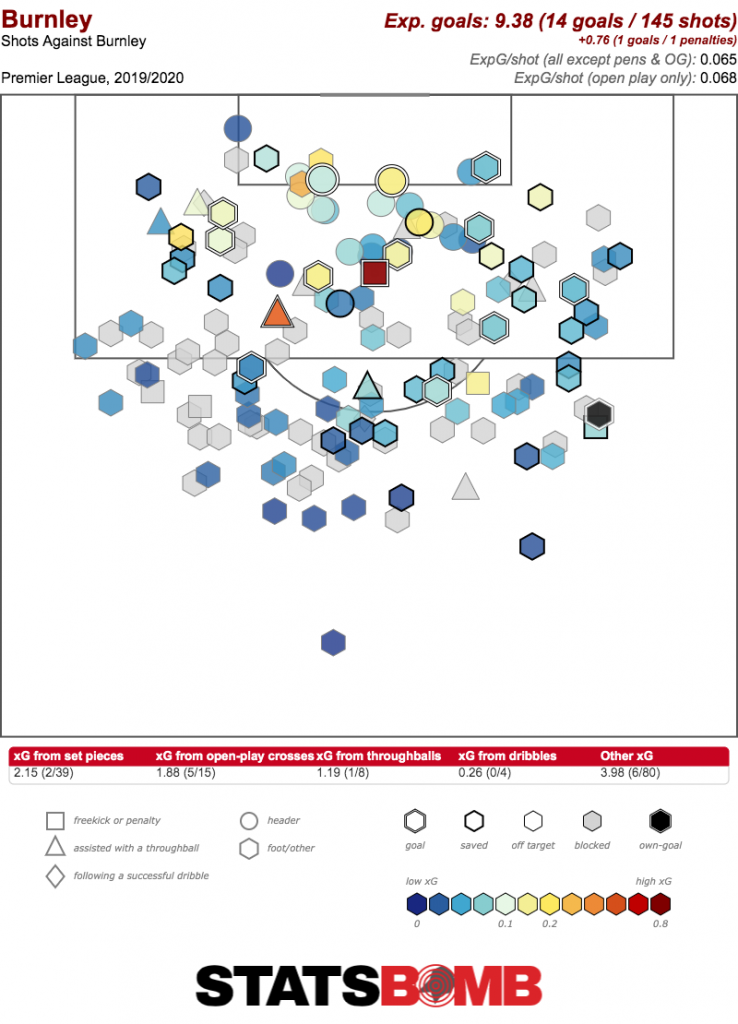 And then there’s the rest. Really you can throw some of the above teams in there as well. Save for the top two, Chelsea (and maybe Manchester United, but that’s a whole article), and some things going on right at the bottom, everyone else falls into a state of nothingness. 12 teams fall into an xG difference range of +2 to -4, including Leicester, Arsenal and Tottenham. At this point a team like Crystal Palace is surely favoured to finish above, say, Southampton just through having amassed more points, not by playing better football. Considering most are in the range of 10-13 points, though, any have the possibility of either pushing on and challenging for a European place or getting sucked into the relegation fight. It’s really something that we’ll have a better sense of in the new year. But there could well be a team with perfectly decent metrics who end up kicking off in the Championship come August 2020.
And then there’s the rest. Really you can throw some of the above teams in there as well. Save for the top two, Chelsea (and maybe Manchester United, but that’s a whole article), and some things going on right at the bottom, everyone else falls into a state of nothingness. 12 teams fall into an xG difference range of +2 to -4, including Leicester, Arsenal and Tottenham. At this point a team like Crystal Palace is surely favoured to finish above, say, Southampton just through having amassed more points, not by playing better football. Considering most are in the range of 10-13 points, though, any have the possibility of either pushing on and challenging for a European place or getting sucked into the relegation fight. It’s really something that we’ll have a better sense of in the new year. But there could well be a team with perfectly decent metrics who end up kicking off in the Championship come August 2020.
So who looks really bad?
By xG difference, we’re looking at Norwich, Brighton, West Ham and Newcastle as the poorest sides. Brighton are the flip side of Leicester in that they’ve suffered two early red cards themselves. Strip those minutes out of the numbers and they look like a side well within the mulch, as their points tally would suggest. Norwich look around what anyone who has watched them would expect: a respectable league average attack met with the second worst defence. That kind of high variance style isn’t typically the way to stay in the Premier League, though if it leads to fewer draws, that might be the trick. We’re still talking something of a hurdle, granted. West Ham look fine by the table, but their numbers are so completely atrocious that they could easily drift down into a relegation fight if something doesn’t change. And there’s Newcastle. Unfortunately, I don’t think anyone in Tyneside needs me to tell them that it’s just not good right now. Steve Bruce has coached a nearly nonexistent attack paired with a below average defence. Big money signing Joelinton remains an able striker when it comes to winning balls in the air, pressuring opponents and linking up well, but he seems like a terrible fit for a side who just want to punt it long to a target man, despite his size. He’s getting less than two shots per 90 and most of them poor quality headers.  The new midfield pairing of brothers Sean and Matty Longstaff looks like it’s ready to challenge West Ham’s double pivot in prioritising passion and loving the club over things that help you win football matches. Sean seems to have a more varied game and offers more in possession while Matty, if we’re completely honest, would probably benefit in his development by staying at Newcastle if they play in the Championship next season. These two are both young enough that they could develop into real players, but for now, this is not a serious Premier League midfield.
The new midfield pairing of brothers Sean and Matty Longstaff looks like it’s ready to challenge West Ham’s double pivot in prioritising passion and loving the club over things that help you win football matches. Sean seems to have a more varied game and offers more in possession while Matty, if we’re completely honest, would probably benefit in his development by staying at Newcastle if they play in the Championship next season. These two are both young enough that they could develop into real players, but for now, this is not a serious Premier League midfield. 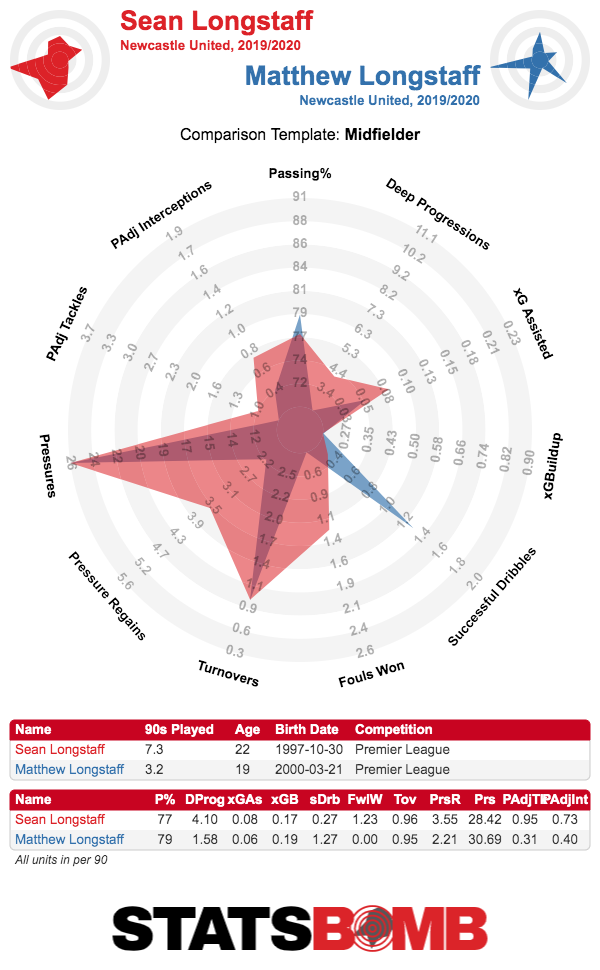 But what, you say, of the team that’s actually bottom of the table? Where are Watford in all of this? Well, in pure numbers terms, they look fine. An apocalyptically bad finishing run in attack sees them in this position. Just on points, they’ve dug themselves a hole that it could take a long time to work their way out of. But they can be fine if they trust in what they’re doing. It’s a strange sport. Header image courtesy of the Press Association
But what, you say, of the team that’s actually bottom of the table? Where are Watford in all of this? Well, in pure numbers terms, they look fine. An apocalyptically bad finishing run in attack sees them in this position. Just on points, they’ve dug themselves a hole that it could take a long time to work their way out of. But they can be fine if they trust in what they’re doing. It’s a strange sport. Header image courtesy of the Press Association
Before the start of the season, many had West Ham in the upper tier of midtable sides that could potentially break the top six hegemony. It didn’t seem like an unreasonable suggestion. While Manuel Pellegrini’s side had finished tenth the previous season, this was on the same number of points as fellow “best of the rest” hopefuls Leicester and only two behind Everton. And the Hammers had signed some interesting players. Sébastien Haller had all the attributes one would look for in a striker to lead the line, while Pablo Fornals was one of the more interesting attacking midfielders in La Liga last season. There were real questions in the midfield and defence, but still, this was an interesting set of talent under a manager with a strong track record. There were, however, reasons to doubt this project. West Ham’s metrics did not look especially exciting. Their 44.62 expected goals last season was around midtable, while their 56.51 xG conceded was third worst in the league. It took a miracle of a season from Łukasz Fabiański to keep things relatively secure. StatsBomb’s shot stopping model estimates that he saved West Ham a fairly astonishing 13.75 goals against the average ‘keeper. It’s the kind of miracle that does not typically happen twice.  West Ham certainly added firepower to the attack this summer, but did almost nothing to the defensive side. With a 32 year old Mark Noble still expected to play serious minutes in midfield, it looked like there was going to be real space for teams to attack the Hammers. The optimistic case for West Ham was that they could hold things together, with Declan Rice maturing into a more dominant defensive midfielder, just enough for the potentially very exciting attack to blow sides in the bottom half of the table away. The more pessimistic view was that they’d concede so frequently that the attack would have to be amazing, and anything less would be a disaster. As it is, the attack remains middling, with their 1.24 xG for only the tenth best in the top flight. Haller has settled into life at the London Stadium quickly, getting 35% of the side’s xG himself, but Fornals has not yet got going and production doesn’t look hugely different from last season.
West Ham certainly added firepower to the attack this summer, but did almost nothing to the defensive side. With a 32 year old Mark Noble still expected to play serious minutes in midfield, it looked like there was going to be real space for teams to attack the Hammers. The optimistic case for West Ham was that they could hold things together, with Declan Rice maturing into a more dominant defensive midfielder, just enough for the potentially very exciting attack to blow sides in the bottom half of the table away. The more pessimistic view was that they’d concede so frequently that the attack would have to be amazing, and anything less would be a disaster. As it is, the attack remains middling, with their 1.24 xG for only the tenth best in the top flight. Haller has settled into life at the London Stadium quickly, getting 35% of the side’s xG himself, but Fornals has not yet got going and production doesn’t look hugely different from last season. 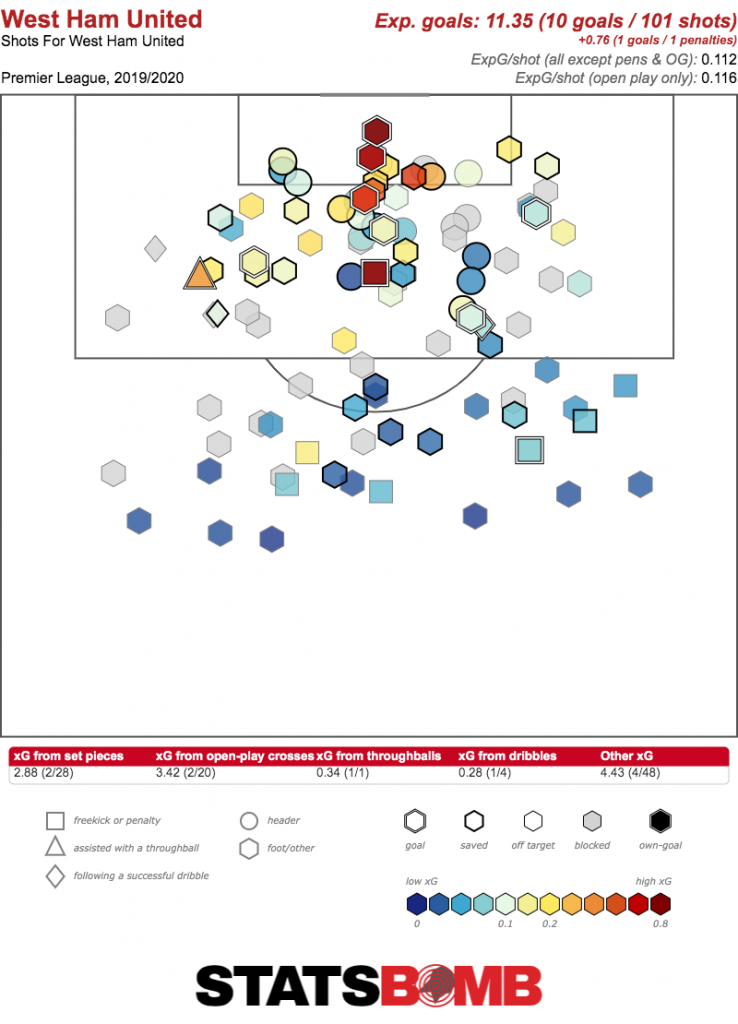 But it’s the defence where things get dicey. The xG isn’t just bad. Bad would be tolerable at this point. It’s worst-in-the-league bad. The opposition haven’t found the back of the net as frequently as the chances would suggest, but West Ham are certainly being carved open.
But it’s the defence where things get dicey. The xG isn’t just bad. Bad would be tolerable at this point. It’s worst-in-the-league bad. The opposition haven’t found the back of the net as frequently as the chances would suggest, but West Ham are certainly being carved open. 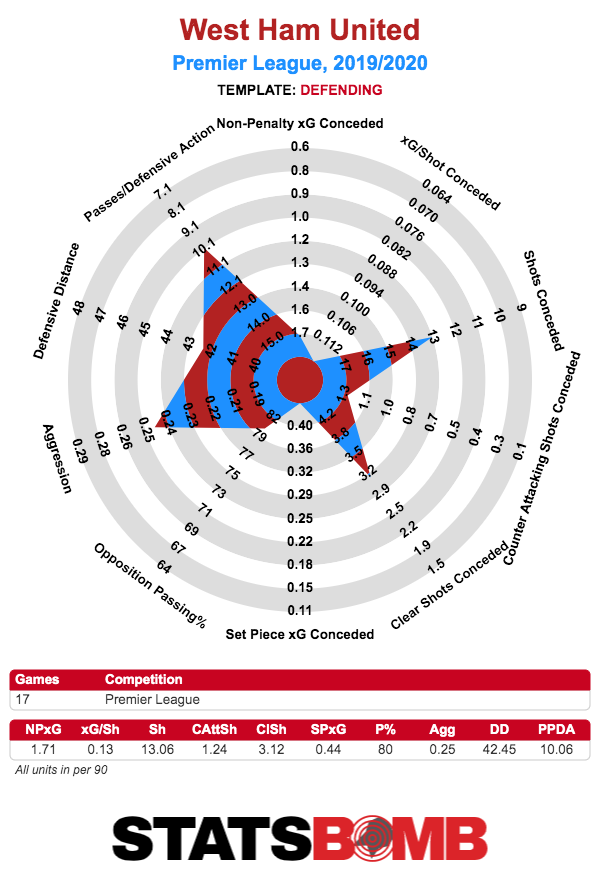 The curious thing is that the difference hasn’t really been down to good goalkeeping. On the post-shot model, West Ham’s xG conceded falls to 12.36. The biggest factor in this seems to be opposing players just outright missing the target on a few really good shots. It goes without saying that you do not want to be relying on your opposition to have bad finishing days to bail you out. This all gives us a side with the second worst xG difference in the league. It’s not exactly the recipe for challenging the top six.
The curious thing is that the difference hasn’t really been down to good goalkeeping. On the post-shot model, West Ham’s xG conceded falls to 12.36. The biggest factor in this seems to be opposing players just outright missing the target on a few really good shots. It goes without saying that you do not want to be relying on your opposition to have bad finishing days to bail you out. This all gives us a side with the second worst xG difference in the league. It’s not exactly the recipe for challenging the top six.  Defending, of course, starts from the front. In Haller, West Ham have a hard working forward, and behind him have been generally three of Felipe Anderson, Andriy Yarmolenko, Manuel Lanzini and Fornals. None of these players could be accused of laziness. All but Yarmolenko are at over 20 pressures per 90, and the Ukrainian still puts up a reasonable 15. But a high volume of pressures doesn’t necessarily equal an effective co-ordinated pressing effort. Despite such excellent pressing attackers, West Ham are still one of the deeper defending sides in the league, with the fifth lowest defensive distance. Whatever these forward players are doing in their hard work, the defensive activity map suggests that it doesn’t seem to be making life easier for those behind them.
Defending, of course, starts from the front. In Haller, West Ham have a hard working forward, and behind him have been generally three of Felipe Anderson, Andriy Yarmolenko, Manuel Lanzini and Fornals. None of these players could be accused of laziness. All but Yarmolenko are at over 20 pressures per 90, and the Ukrainian still puts up a reasonable 15. But a high volume of pressures doesn’t necessarily equal an effective co-ordinated pressing effort. Despite such excellent pressing attackers, West Ham are still one of the deeper defending sides in the league, with the fifth lowest defensive distance. Whatever these forward players are doing in their hard work, the defensive activity map suggests that it doesn’t seem to be making life easier for those behind them. 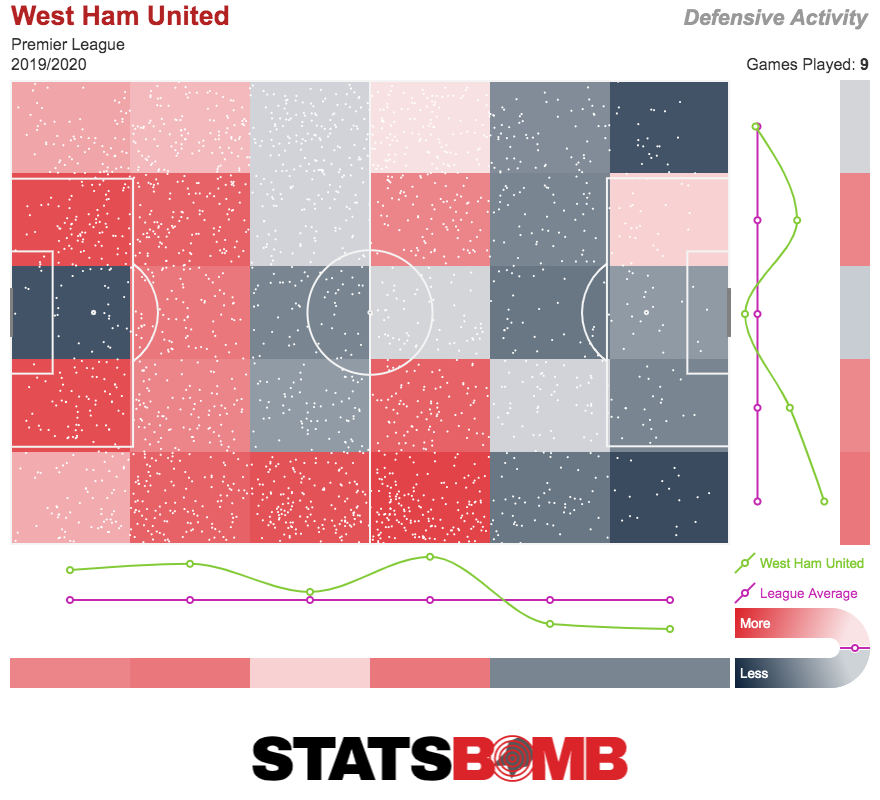 And behind them is the best midfield in the country, if the only aim of a midfield is to love the club and show loads of passion. Unfortunately, it isn’t. There are things to like about Declan Rice as a player. He recycles the ball well while being a reasonable contributor defensively, all at age 20. This suggests he’s well on the way to maturing into a very good midfielder. What he isn’t, and will likely never be, is a firefighter who can fix the defensive issues of a team, N’Golo Kanté style.
And behind them is the best midfield in the country, if the only aim of a midfield is to love the club and show loads of passion. Unfortunately, it isn’t. There are things to like about Declan Rice as a player. He recycles the ball well while being a reasonable contributor defensively, all at age 20. This suggests he’s well on the way to maturing into a very good midfielder. What he isn’t, and will likely never be, is a firefighter who can fix the defensive issues of a team, N’Golo Kanté style. 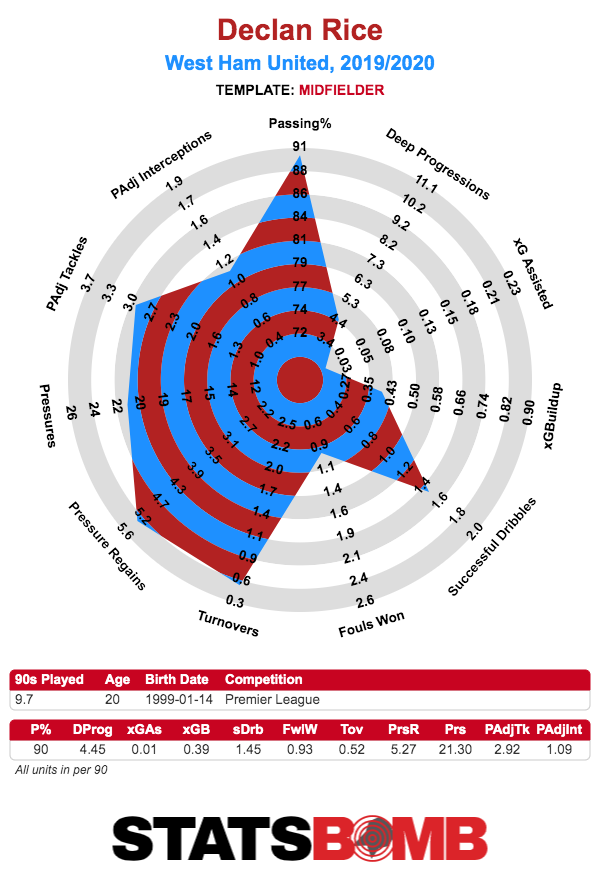 What he needs is a decent ball winner alongside him. With Jack Wilshere being the injury ravaged limited player he’s ended up being, Pellegrini has generally opted for Rice at the base of the midfield behind one of the more creative players and Mr. West Ham himself, Noble. However people may have felt about the Englishman in the past, it’s obvious that his best years are behind him. He’s still reasonable in possession, but he just doesn’t really win the ball back much at all. Rice is thus being asked to do a lot more work than he is capable of.
What he needs is a decent ball winner alongside him. With Jack Wilshere being the injury ravaged limited player he’s ended up being, Pellegrini has generally opted for Rice at the base of the midfield behind one of the more creative players and Mr. West Ham himself, Noble. However people may have felt about the Englishman in the past, it’s obvious that his best years are behind him. He’s still reasonable in possession, but he just doesn’t really win the ball back much at all. Rice is thus being asked to do a lot more work than he is capable of.  Ryan Fredericks has established himself as the regular right back and this is interesting because of how much he gets forward. As previously found, there aren’t many players in the Premier League attempting more passes inside the box than Fredericks. This is great if you want to be doing a lot of attacking through your fullbacks, but is that really how West Ham should be operating? On the other flank, Arthur Masuaku and Aaron Cresswell have been job sharing, and while both are adequate, neither could really call themselves the all conquering defender the system requires. As for the centre backs, Mark Thompson thinks they’re broadly fine, and no one publicly knows more about evaluating centre backs than him. But fine isn’t enough when the side is being battered like this. Despite a somewhat mediocre reputation in the UK, Pellegrini is certainly a talented coach. He’s someone who places a lot of emphasis on letting the talent of the attacking individuals shine, and it worked to great effect in La Liga, while working well enough to win a Premier League title at Manchester City. He’s assembled himself something of a budget version of that talent at the London Stadium, and that might be the problem. It’s one thing for a club like Manchester City to play Pellegrini’s very open, high variance football. The side with better players is inevitably favoured in those kinds of games, and City had more talent than almost anyone else. Meanwhile Vincent Kompany did an exemplary job of holding a mess of a defence together, along with Fernandinho’s defensive midfield qualities that only recently have become properly appreciated. At West Ham, he’s trying the same trick with not that much more than league average talent. They’re playing high variance football without being the dominant side that thrives in those situations. The effects are what one would expect them to be. Is this something that can be fixed? The most straightforward solution is to just buy a really good defensive midfielder in January. It should have been a priority in the summer, but let’s assume West Ham either cannot afford to splash out or just can’t find someone in the role they really like. Can this group of players play a more conservative style of football? Can Pellegrini coach something that isn’t all action, all the time? The balance is wrong right now. But would a more defensive move guarantee better results? It’s not obvious. But West Ham need to answer these questions very soon or things could start to get concerning. Header image courtesy of the Press Association
Ryan Fredericks has established himself as the regular right back and this is interesting because of how much he gets forward. As previously found, there aren’t many players in the Premier League attempting more passes inside the box than Fredericks. This is great if you want to be doing a lot of attacking through your fullbacks, but is that really how West Ham should be operating? On the other flank, Arthur Masuaku and Aaron Cresswell have been job sharing, and while both are adequate, neither could really call themselves the all conquering defender the system requires. As for the centre backs, Mark Thompson thinks they’re broadly fine, and no one publicly knows more about evaluating centre backs than him. But fine isn’t enough when the side is being battered like this. Despite a somewhat mediocre reputation in the UK, Pellegrini is certainly a talented coach. He’s someone who places a lot of emphasis on letting the talent of the attacking individuals shine, and it worked to great effect in La Liga, while working well enough to win a Premier League title at Manchester City. He’s assembled himself something of a budget version of that talent at the London Stadium, and that might be the problem. It’s one thing for a club like Manchester City to play Pellegrini’s very open, high variance football. The side with better players is inevitably favoured in those kinds of games, and City had more talent than almost anyone else. Meanwhile Vincent Kompany did an exemplary job of holding a mess of a defence together, along with Fernandinho’s defensive midfield qualities that only recently have become properly appreciated. At West Ham, he’s trying the same trick with not that much more than league average talent. They’re playing high variance football without being the dominant side that thrives in those situations. The effects are what one would expect them to be. Is this something that can be fixed? The most straightforward solution is to just buy a really good defensive midfielder in January. It should have been a priority in the summer, but let’s assume West Ham either cannot afford to splash out or just can’t find someone in the role they really like. Can this group of players play a more conservative style of football? Can Pellegrini coach something that isn’t all action, all the time? The balance is wrong right now. But would a more defensive move guarantee better results? It’s not obvious. But West Ham need to answer these questions very soon or things could start to get concerning. Header image courtesy of the Press Association
It took some time, but Everton got exactly the manager they wanted. It’s fair to say Farhad Moshiri didn’t entirely know what he was doing when he bought the Blues. Transforming things from the kind of old fashioned outfit Bill Kenwright ran to a thoroughly modern football club was obviously the aim, but it was tough to figure out where to start that transition. Perhaps lacking in good advice, he went straight in for Ronald Koeman, with Steve Walsh brought in as director of football, a position he had no real experience in. After significant investment in the first team, it became apparent that Koeman was not the man for the job, and he got the boot. Walsh eventually got his preferred coach in Sam Allardyce, but the mere fact that this was his preference showed his unsuitability for the role at Everton, and both were kicked out before too long. Throughout most of this, there was a certain Portuguese sparkle in Moshiri’s eye. Marco Silva was who the owner craved. He had to wait, but eventually Moshiri got his man. Alongside actual director of football Marcel Brands, Silva was deemed the person to build the kind of football, and results, Moshiri felt was befitting of his considerable investment in the club. It took some time, but this was the Everton he had envisioned. All plain sailing from there, right? Well, not exactly. Everton currently sit in the relegation zone in the Premier League table, having picked up just 7 points from 8 games and lost all of the last 4. It was in October 2017 when the club sacked Koeman with the side in the bottom three, so it’s hardly a surprise to see the vultures circling at Goodison Park again. But should they be? A basic glance at the expected goals at least paints a better picture than the league table. On the attacking side, Everton have created 10.39 expected goals, ninth best in the league, but found the back of the net just six times. It’s much the same story at the back. Everton’s 10.55 xG conceded is a hair above league average, but chances have been finished at a better than usual rate and the Toffees find themselves having conceded 13. So the xG suggests Everton have performed like a midtable side so far. This is obviously better than results, and Silva’s job presumably wouldn’t be in such danger if the club were sitting in tenth. But at the same time, it’s still short of what the club have been aiming and spending for in recent years. xG isn’t going to save Silva’s job, so we’ll have to look a little deeper for redemption. The main thing Everton do in the numbers is press. The Blues allow the opponents to have fewer passes before attempting to win the ball back than any team other than Leicester. StatsBomb contributor Paul Riley’s personal research found Everton to be the highest pressing side in the league in his own numbers. Their defensive distance, how high up the pitch they attempt to win the ball back, is only fifth best, but some of that is likely because they are not able to pen teams into their own half the way Liverpool and Manchester City do. Everton certainly set out to press early and press often. The main aim of this, at least in a defensive sense, is to suppress shots, and Everton are successful in this. Their 9.63 shots per game conceded is the fourth best in the league. 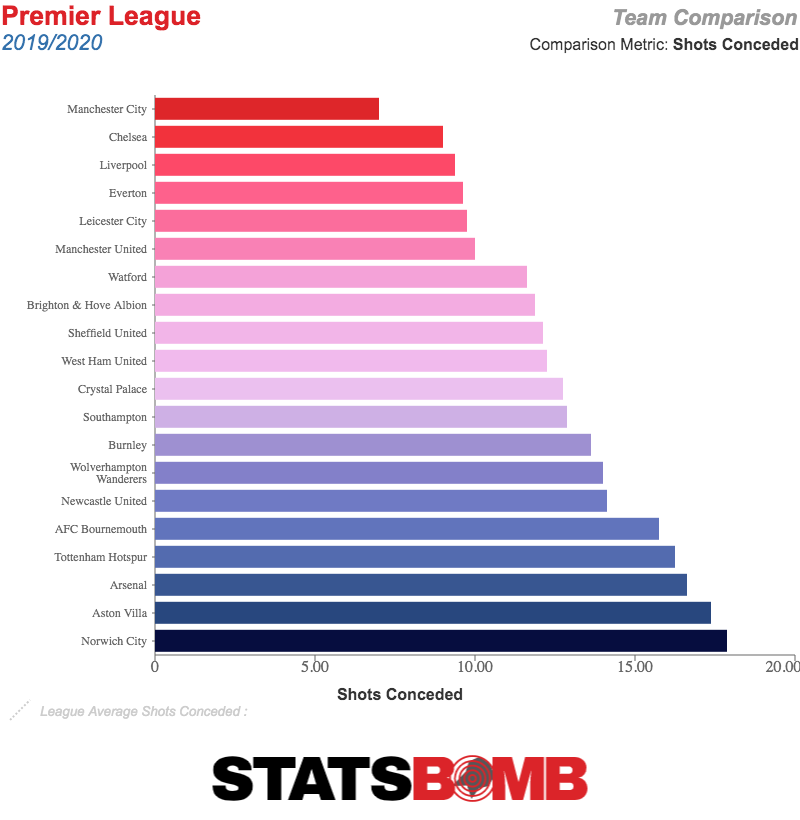 The trick, of course, is to make sure the shots you do concede aren’t horrific ones. If teams are able to break through the high press, they might find plenty of space in behind to really cut you open. And it does look like Everton are finding it difficult here. Their xG per shot conceded of 0.13 is fourth worst in the league and 30% worse than last season. When you look at the shot map, what stands out is the number of chances against that come from throughballs. Teams are able to play incisive passes through Everton’s defence and produce some very good scoring opportunities from it.
The trick, of course, is to make sure the shots you do concede aren’t horrific ones. If teams are able to break through the high press, they might find plenty of space in behind to really cut you open. And it does look like Everton are finding it difficult here. Their xG per shot conceded of 0.13 is fourth worst in the league and 30% worse than last season. When you look at the shot map, what stands out is the number of chances against that come from throughballs. Teams are able to play incisive passes through Everton’s defence and produce some very good scoring opportunities from it. 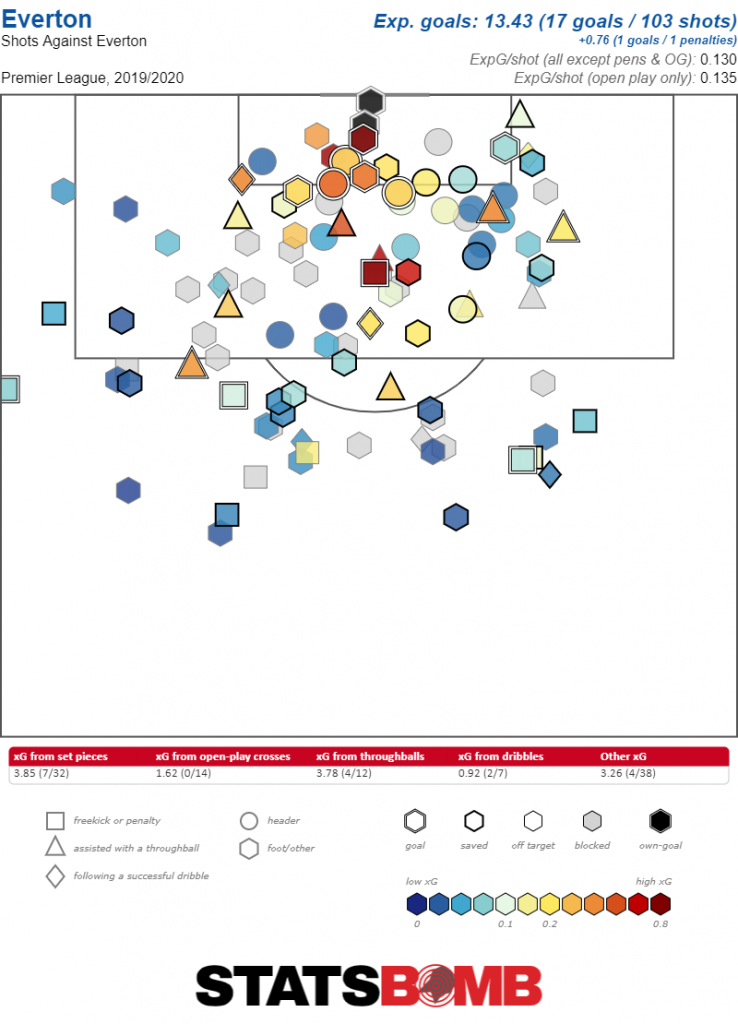 In terms of what has changed, it’s hard not to point towards the sale of Idrissa Gueye. The Senegal international was one of the better ball winning midfielders in the league without costing Everton too much on the ball. Injuries and perhaps genuine questions over personnel have meant that Everton haven’t quite had an obvious first choice midfield pair this season. The past four games have seen Fabian Delph and Morgan Schneiderlin selected to less than ideal results. Schneiderlin has never been able to recreate his aggressive defensive output from his Southampton years at Goodison and his limits are fairly well known at this point. With Jean-Philippe Gbamin’s injury, Delph has really been asked to take up the role as the Gueye replacement. Delph has shown a lot of tactical intelligence and flexibility throughout his career, particularly in his ability to seamlessly adapt from a box to box shuttler to an inverted left back under Pep Guardiola. He can be an excellent utility option, but he’s not a specialist for the defensive midfield role. Looking at his radar, it’s obvious that he just doesn’t actively involve himself in defending the way Gueye does.
In terms of what has changed, it’s hard not to point towards the sale of Idrissa Gueye. The Senegal international was one of the better ball winning midfielders in the league without costing Everton too much on the ball. Injuries and perhaps genuine questions over personnel have meant that Everton haven’t quite had an obvious first choice midfield pair this season. The past four games have seen Fabian Delph and Morgan Schneiderlin selected to less than ideal results. Schneiderlin has never been able to recreate his aggressive defensive output from his Southampton years at Goodison and his limits are fairly well known at this point. With Jean-Philippe Gbamin’s injury, Delph has really been asked to take up the role as the Gueye replacement. Delph has shown a lot of tactical intelligence and flexibility throughout his career, particularly in his ability to seamlessly adapt from a box to box shuttler to an inverted left back under Pep Guardiola. He can be an excellent utility option, but he’s not a specialist for the defensive midfield role. Looking at his radar, it’s obvious that he just doesn’t actively involve himself in defending the way Gueye does. 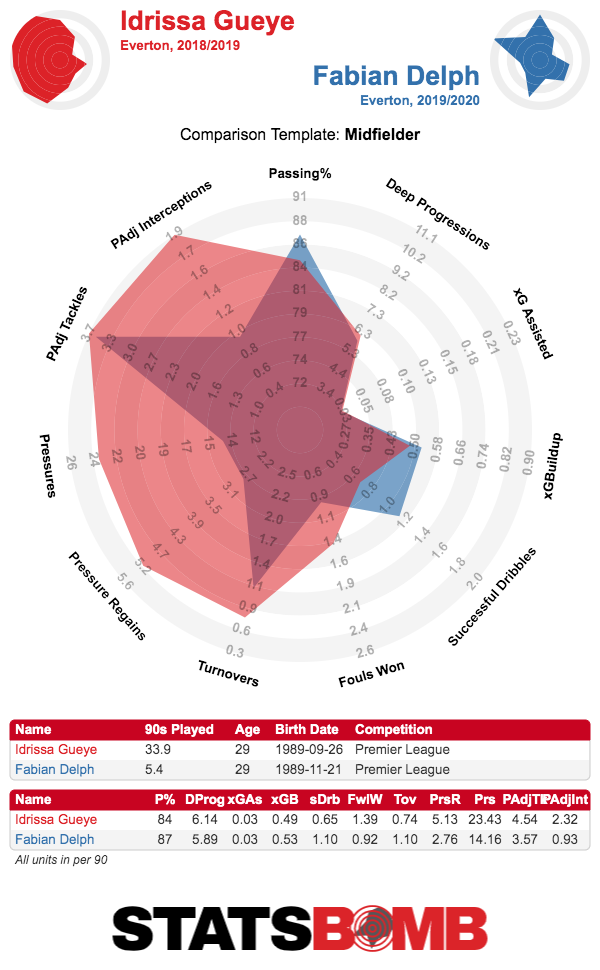 There’s not much that’s particularly special about Everton’s midfielders when they have the ball, either. Recently injured Andre Gomes is the player expected to really progress the ball in central areas, but he’s never really shown much in that regard through the numbers. He’s not moving the ball into the final third at a notably better rate than Schneiderlin or Delph. What this does is put more pressure on the fullbacks, with Seamus Coleman leading this stat. To be the side’s leading ball progressor without significant protection from the midfield is something of an impossible task, so it’s not shocking that there are some frustrations here.
There’s not much that’s particularly special about Everton’s midfielders when they have the ball, either. Recently injured Andre Gomes is the player expected to really progress the ball in central areas, but he’s never really shown much in that regard through the numbers. He’s not moving the ball into the final third at a notably better rate than Schneiderlin or Delph. What this does is put more pressure on the fullbacks, with Seamus Coleman leading this stat. To be the side’s leading ball progressor without significant protection from the midfield is something of an impossible task, so it’s not shocking that there are some frustrations here.  Everton don’t have a clearly defined plan once they get the ball into the final third either. The two ever presents here are Gylfi Sigurdsson and Richarlison. Both press well and take shots of questionable quality, but offer little in terms of really moving the ball into dangerous areas. In terms of offering creative passing, it seems to be a competition between Bernard and Alex Iwobi to fill that role. Bernard offers virtually nothing in terms of goal and assist threat, so it seems likely that Iwobi should take over in due course. A combination of Iwobi, Sigurdsson and Richarlison behind either Dominic Calvert-Lewin or Moise Kean depending on the opposition could potentially be a flexible and fluid attack, but we’ve yet to see any real evidence of it. It’s not really clear what this Everton squad is built to be doing. Silva wants to play a high line, aggressive pressing style, but this requires fast centre backs capable of covering a lot of ground, while Michael Keane is a regular fixture at centre back. The midfield contains a selection of players who offer flexibility and a solid range of skills, but no one who is truly outstanding at anything. The attack has various different options, but no clear hierarchy. Perhaps this shouldn’t be a surprise after four different managers and two directors of football in the last two years. The most important job for Everton, ahead of dealing with the manager question, is for Brands to move towards a coherent squad where everyone is suited to playing the same kind of football. Considering he has a seat on the board, his job is almost certainly safe for the foreseeable future, so this will be a squad very much shaped by the Dutchman. If the club truly believe in Silva, the squad certainly needs more overhauling to fit his “press high and play nice football or death” approach. But there’s also not a lot of evidence that this would be an especially good idea. Silva is at his third Premier League club and at no point has he coached a particularly solid defence. He can make excuses in terms of the players he had available, but there’s slim evidence that he’s more Mauricio Pochettino than Roberto Martinez. Changing the manager has its obvious risks, and would require serious thought in terms of what Everton’s long term strategy should be. The priority, though, is ensuring that there is a plan, with or without Silva. Header image courtesy of the Press Association
Everton don’t have a clearly defined plan once they get the ball into the final third either. The two ever presents here are Gylfi Sigurdsson and Richarlison. Both press well and take shots of questionable quality, but offer little in terms of really moving the ball into dangerous areas. In terms of offering creative passing, it seems to be a competition between Bernard and Alex Iwobi to fill that role. Bernard offers virtually nothing in terms of goal and assist threat, so it seems likely that Iwobi should take over in due course. A combination of Iwobi, Sigurdsson and Richarlison behind either Dominic Calvert-Lewin or Moise Kean depending on the opposition could potentially be a flexible and fluid attack, but we’ve yet to see any real evidence of it. It’s not really clear what this Everton squad is built to be doing. Silva wants to play a high line, aggressive pressing style, but this requires fast centre backs capable of covering a lot of ground, while Michael Keane is a regular fixture at centre back. The midfield contains a selection of players who offer flexibility and a solid range of skills, but no one who is truly outstanding at anything. The attack has various different options, but no clear hierarchy. Perhaps this shouldn’t be a surprise after four different managers and two directors of football in the last two years. The most important job for Everton, ahead of dealing with the manager question, is for Brands to move towards a coherent squad where everyone is suited to playing the same kind of football. Considering he has a seat on the board, his job is almost certainly safe for the foreseeable future, so this will be a squad very much shaped by the Dutchman. If the club truly believe in Silva, the squad certainly needs more overhauling to fit his “press high and play nice football or death” approach. But there’s also not a lot of evidence that this would be an especially good idea. Silva is at his third Premier League club and at no point has he coached a particularly solid defence. He can make excuses in terms of the players he had available, but there’s slim evidence that he’s more Mauricio Pochettino than Roberto Martinez. Changing the manager has its obvious risks, and would require serious thought in terms of what Everton’s long term strategy should be. The priority, though, is ensuring that there is a plan, with or without Silva. Header image courtesy of the Press Association
There is no right back controversy at Arsenal. Internet boyfriend Héctor Bellerín, who recently returned from a long-term injury, is the starter. Academy product Ainsley Maitland-Niles is once again his backup. This formulation — a starter and his young understudy — flattens the difference between the two players. It suggests that Maitland-Niles is simply a lesser player. While possibly true, that is not a good way to understand either player. Maitland-Niles isn’t a copy of a copy of Bellerín. Arsenal just so happens to have two young, interesting and very different right backs in its squad. 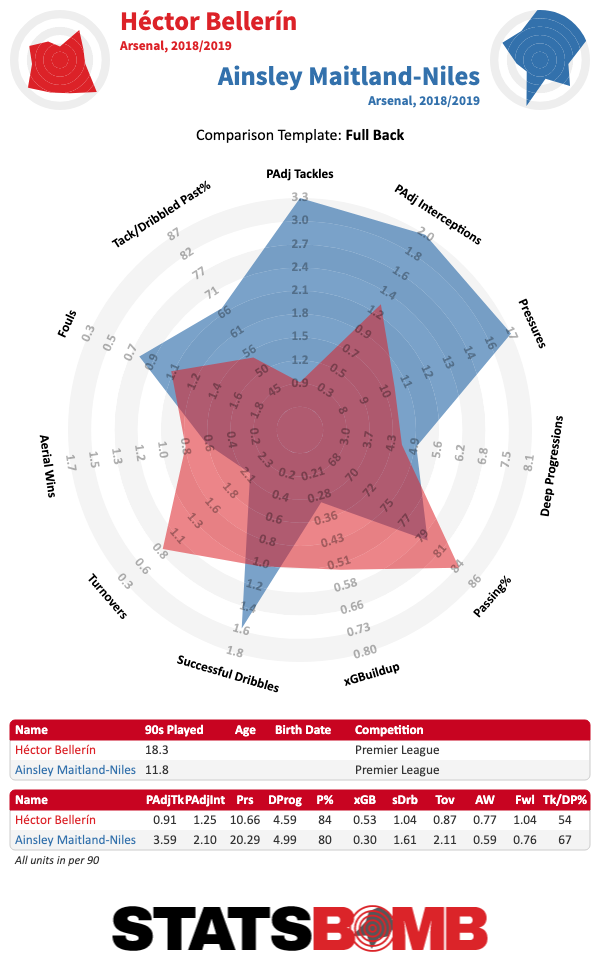 This was not the plan — at least not exactly. The point of Bellerín has never been a mystery: He offers a mix of speed and good passing with just enough defence to justify his presence on the pitch. In Arsène Wenger’s final season, when he was last healthy, Bellerín was a passable defender: his tackles and interception rates were roughly average; he was a decent presser; opposing players dribbled past him a fair bit, which tended to result in him picking up fouls. He didn’t progress the ball so much as he served as an additional creative player higher up the pitch. He passed well enough to make that role work, and was heavily involved in the team’s attack.
This was not the plan — at least not exactly. The point of Bellerín has never been a mystery: He offers a mix of speed and good passing with just enough defence to justify his presence on the pitch. In Arsène Wenger’s final season, when he was last healthy, Bellerín was a passable defender: his tackles and interception rates were roughly average; he was a decent presser; opposing players dribbled past him a fair bit, which tended to result in him picking up fouls. He didn’t progress the ball so much as he served as an additional creative player higher up the pitch. He passed well enough to make that role work, and was heavily involved in the team’s attack. 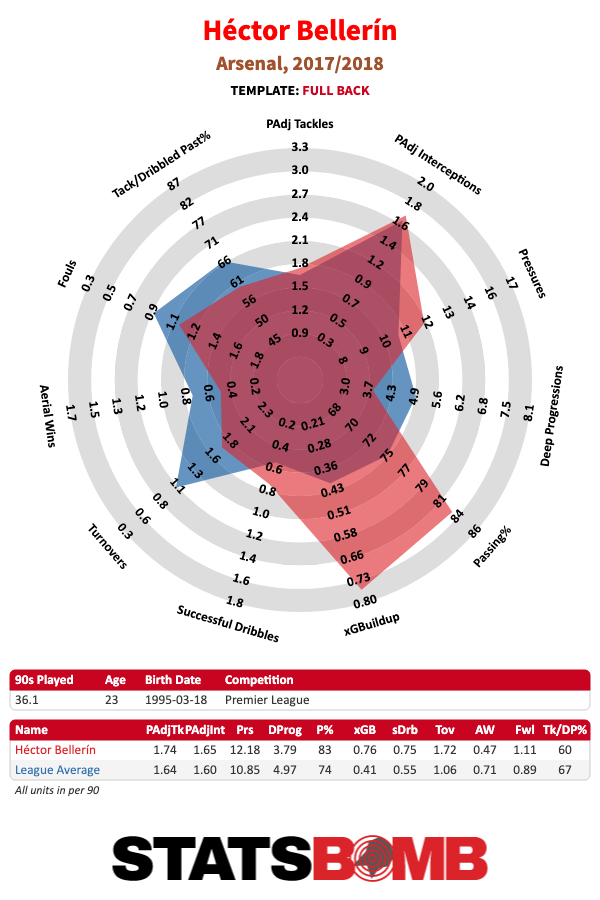 When Unai Emery took over Arsenal, the club tried to bring in a more defensively-minded backup for Bellerín. This likely reflected the new manager’s preferences. It was also, at least in part, a function of Mathieu Debuchy finally being off the club’s books. Maitland-Niles had filled in during the Frenchman’s tenure, but it was unclear if the club even saw him as a fullback (more on that later). Arsenal needed somebody — anybody, really — to serve as a backup right back. Intelligent people can debate whether Stephan Lichsteiner, signed in the summer of 2018, fit that billing. On the one hand, he had a corporeal presence and had played right (sometimes wing) back. He also had a “winning mentality,” whatever that is. On the other hand, it wasn’t clear his legs actually worked at the time he signed. It quickly became clear, through a combination of injuries and statuesque performances, that even if they had been operational before, those legs certainly didn’t make the trip from England to North London with the rest of him. Maitland-Niles was once again the de facto backup, which might not have mattered all that much if Bellerín’s leg had not also exploded. All of which is to say that Ainsley Maitland-Niles wound up playing more than 2,100 minutes for Arsenal in 2018-19 and was fine, basically. He played nothing like Bellerin, but a team that’s on its third right back can’t really be picky. It also helped that he played like a budget version of Aaron Wan-Bissaka.
When Unai Emery took over Arsenal, the club tried to bring in a more defensively-minded backup for Bellerín. This likely reflected the new manager’s preferences. It was also, at least in part, a function of Mathieu Debuchy finally being off the club’s books. Maitland-Niles had filled in during the Frenchman’s tenure, but it was unclear if the club even saw him as a fullback (more on that later). Arsenal needed somebody — anybody, really — to serve as a backup right back. Intelligent people can debate whether Stephan Lichsteiner, signed in the summer of 2018, fit that billing. On the one hand, he had a corporeal presence and had played right (sometimes wing) back. He also had a “winning mentality,” whatever that is. On the other hand, it wasn’t clear his legs actually worked at the time he signed. It quickly became clear, through a combination of injuries and statuesque performances, that even if they had been operational before, those legs certainly didn’t make the trip from England to North London with the rest of him. Maitland-Niles was once again the de facto backup, which might not have mattered all that much if Bellerín’s leg had not also exploded. All of which is to say that Ainsley Maitland-Niles wound up playing more than 2,100 minutes for Arsenal in 2018-19 and was fine, basically. He played nothing like Bellerin, but a team that’s on its third right back can’t really be picky. It also helped that he played like a budget version of Aaron Wan-Bissaka. 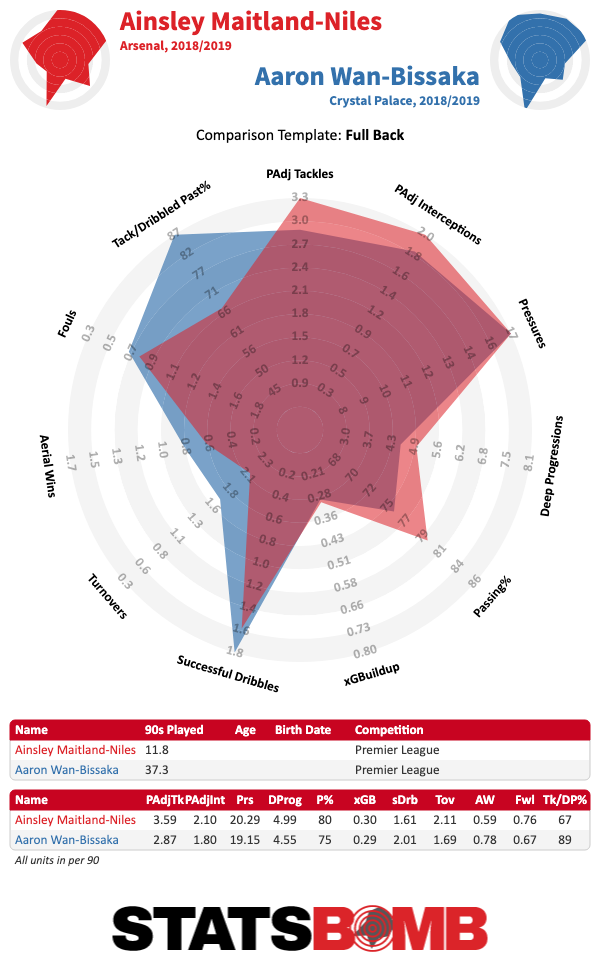 Let’s pause her for a brief digression about Aaron Wan-Bissaka. The comparison with Maitland-Niles is instructive insofar as it shows what Manchester United paid for this summer: A right back who opponents can’t escape on the dribble. The tackles and interceptions and pressures are all nice, but the point of Wan-Bissaka is that you can’t dribble past him. That’s what you pay $60 million for. Still, if you don’t have $60 million to spend and are just fishing around the academy for solutions, as is the late-period Arsenal way, a fullback who does lots of defensive work is a handy find. The high tackle, interception and pressure rates have been a consistent part of Maitland-Niles’ game dating back to Wenger’s final season. (His attacking contribution has been more variable.) He defends slightly deeper than Bellerín, but not in a way that can explain away the substantial difference in outcomes. They’re just different players.
Let’s pause her for a brief digression about Aaron Wan-Bissaka. The comparison with Maitland-Niles is instructive insofar as it shows what Manchester United paid for this summer: A right back who opponents can’t escape on the dribble. The tackles and interceptions and pressures are all nice, but the point of Wan-Bissaka is that you can’t dribble past him. That’s what you pay $60 million for. Still, if you don’t have $60 million to spend and are just fishing around the academy for solutions, as is the late-period Arsenal way, a fullback who does lots of defensive work is a handy find. The high tackle, interception and pressure rates have been a consistent part of Maitland-Niles’ game dating back to Wenger’s final season. (His attacking contribution has been more variable.) He defends slightly deeper than Bellerín, but not in a way that can explain away the substantial difference in outcomes. They’re just different players. 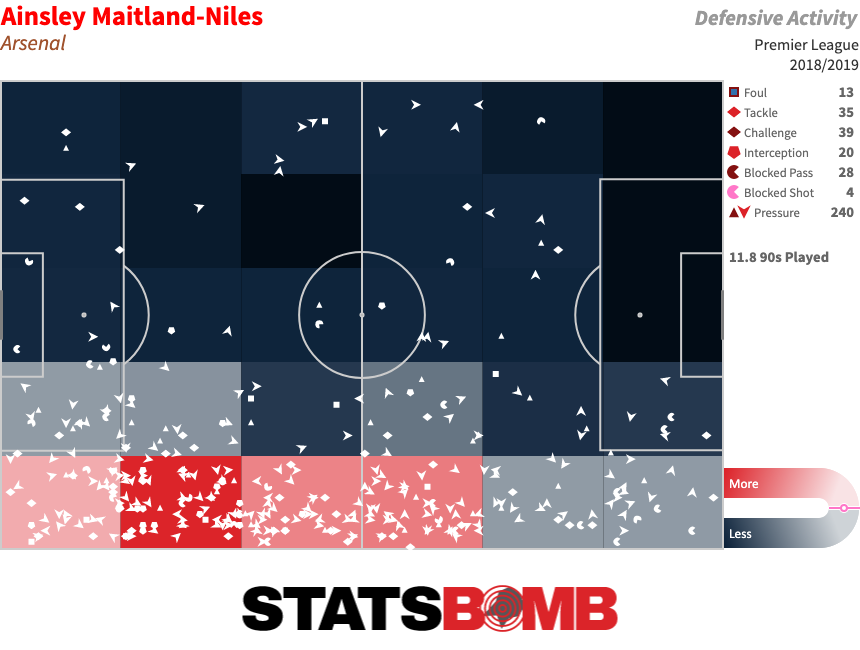 There’s a certain ambiguity to the things Maitland-Niles does well. Some of the tackling, for instance, might be explained away as recovering after opponents dribble past him. Recovering in such situations is good, but it doesn’t always inspire confidence. It’s easy to overstate the extent of the concern here. Opponents have dribbled past Maitland-Niles at a league-average rate in each of the last two seasons. He’s not Wan-Bissaka, obviously, but he does not have a history of getting roasted on the dribble. (So far this year, in a small sample, he’s been well below average.) Sometimes a tackle is just a tackle. Imagine a player who has played more than 2,100 minutes in consecutive seasons before his 22nd birthday. He’s a league-average defender against opposing players on the dribble but elite when it comes to pressing, tackling and intercepting. He’s a good dribbler, but doesn’t contribute much else in attack. Would you dispute that he’s a fullback? Would you dispute that he is of value? Such is the case with Ainsley Maitland-Niles, who some Arsenologists still insist is a defensive midfielder filling in at fullback in the club’s frequent times of crisis. (Some reporting suggests Maitland-Niles also feels this way.) About which, maybe??? Players can move between being defensive midfielders and fullbacks. That may be the biggest tactical legacy of Pep Guardiola’s Bayern Munich. But football is also rife with fullbacks who began their careers as midfielders. Maitland-Niles might one day be a midfielder, but it seems clear enough that he is already an interesting defensive fullback. This leaves Arsenal in an interesting position. There is no fullback competition. Bellerín is the starter when healthy, and Maitland-Niles’ defensive performances have done little to solidify the team in his absence. He is nevertheless an interesting piece, and definitely more than a squad player to be called upon in emergencies. Arsenal set out to get a defensive backup for Bellerín in 2018 only to find him already within the squad. What would be more Arsenal than lucking into such a player only to have no plan for using him?
There’s a certain ambiguity to the things Maitland-Niles does well. Some of the tackling, for instance, might be explained away as recovering after opponents dribble past him. Recovering in such situations is good, but it doesn’t always inspire confidence. It’s easy to overstate the extent of the concern here. Opponents have dribbled past Maitland-Niles at a league-average rate in each of the last two seasons. He’s not Wan-Bissaka, obviously, but he does not have a history of getting roasted on the dribble. (So far this year, in a small sample, he’s been well below average.) Sometimes a tackle is just a tackle. Imagine a player who has played more than 2,100 minutes in consecutive seasons before his 22nd birthday. He’s a league-average defender against opposing players on the dribble but elite when it comes to pressing, tackling and intercepting. He’s a good dribbler, but doesn’t contribute much else in attack. Would you dispute that he’s a fullback? Would you dispute that he is of value? Such is the case with Ainsley Maitland-Niles, who some Arsenologists still insist is a defensive midfielder filling in at fullback in the club’s frequent times of crisis. (Some reporting suggests Maitland-Niles also feels this way.) About which, maybe??? Players can move between being defensive midfielders and fullbacks. That may be the biggest tactical legacy of Pep Guardiola’s Bayern Munich. But football is also rife with fullbacks who began their careers as midfielders. Maitland-Niles might one day be a midfielder, but it seems clear enough that he is already an interesting defensive fullback. This leaves Arsenal in an interesting position. There is no fullback competition. Bellerín is the starter when healthy, and Maitland-Niles’ defensive performances have done little to solidify the team in his absence. He is nevertheless an interesting piece, and definitely more than a squad player to be called upon in emergencies. Arsenal set out to get a defensive backup for Bellerín in 2018 only to find him already within the squad. What would be more Arsenal than lucking into such a player only to have no plan for using him?
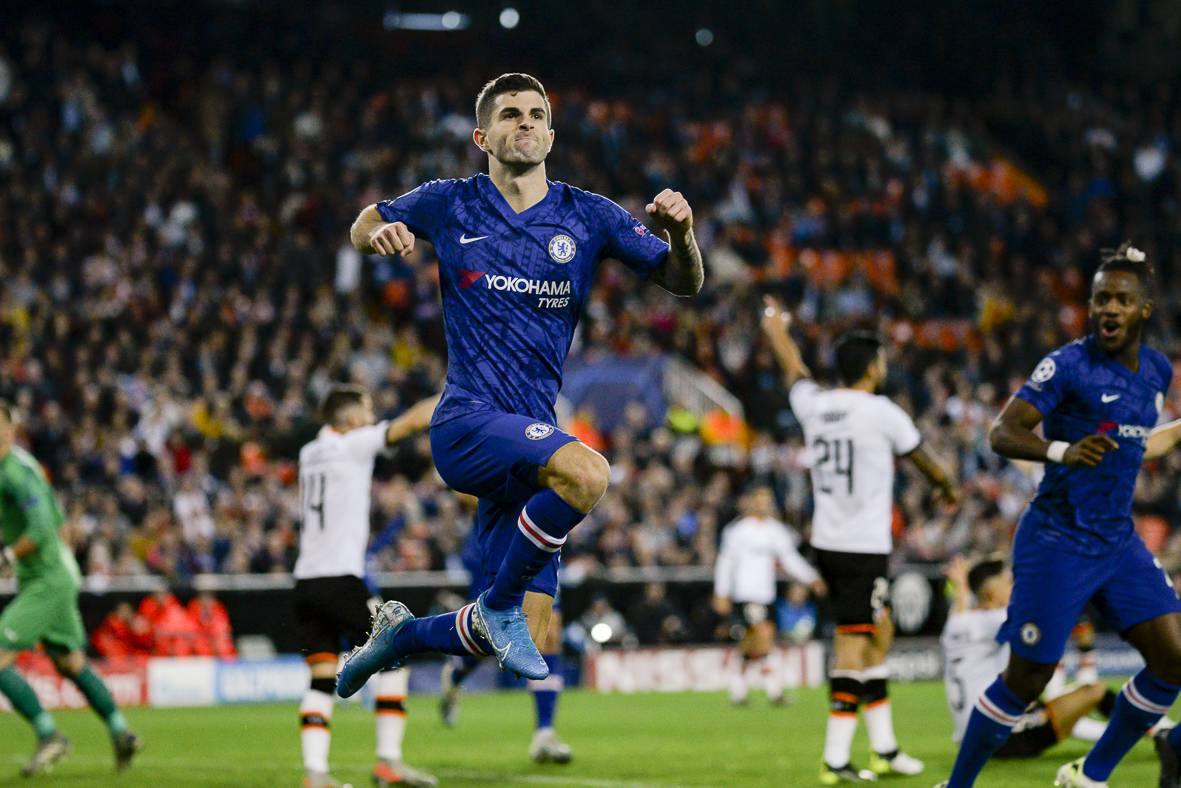
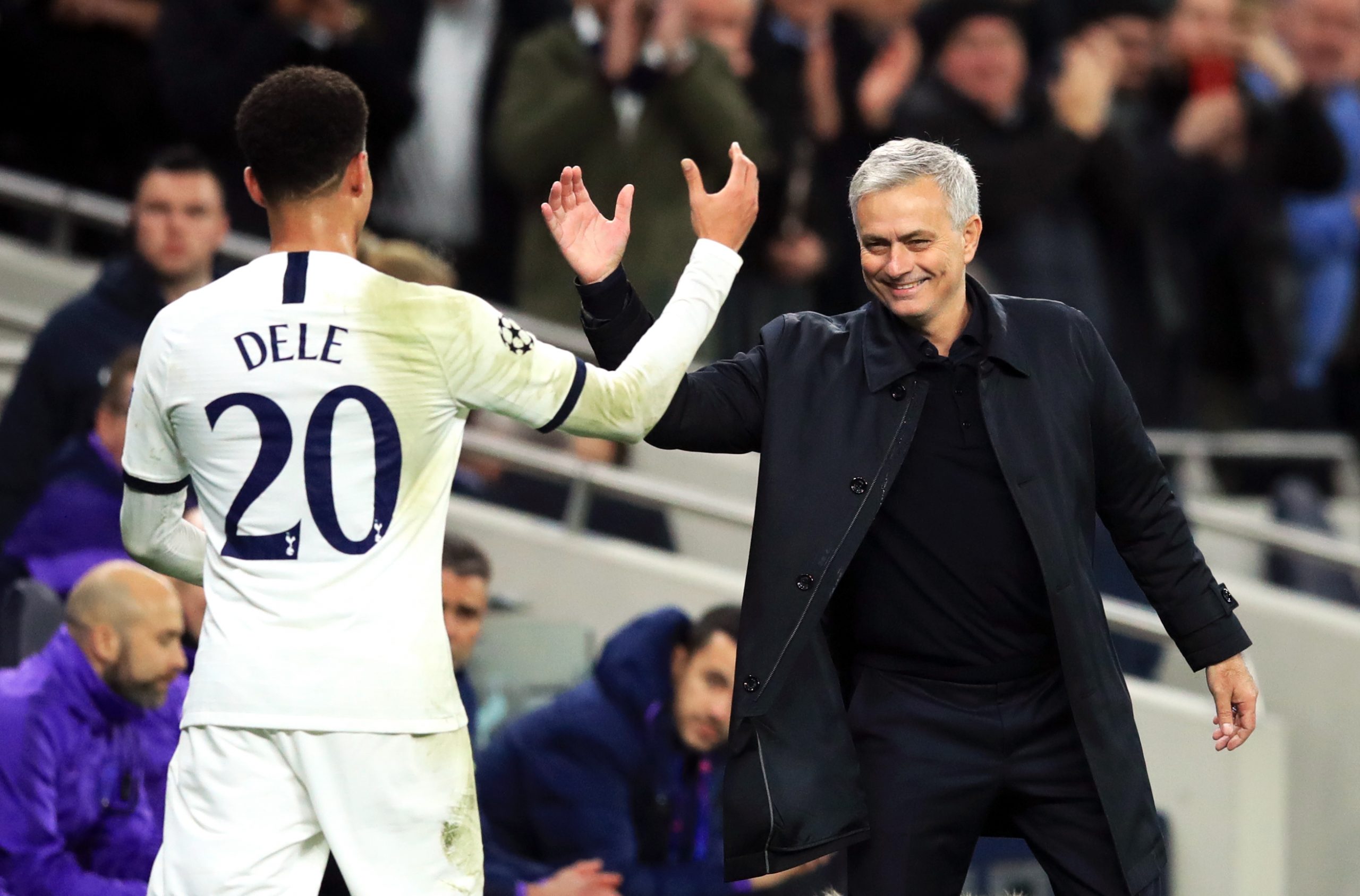
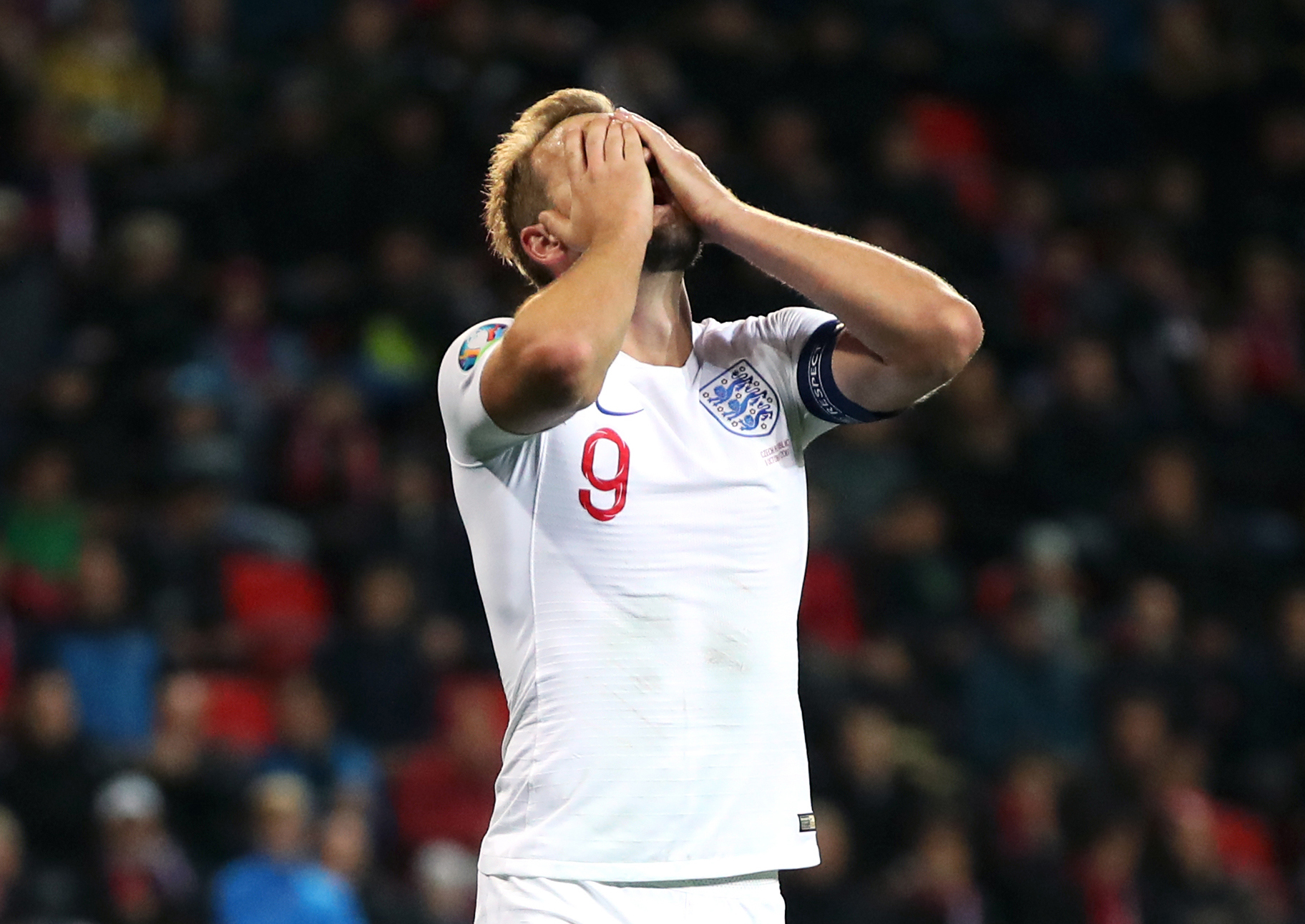
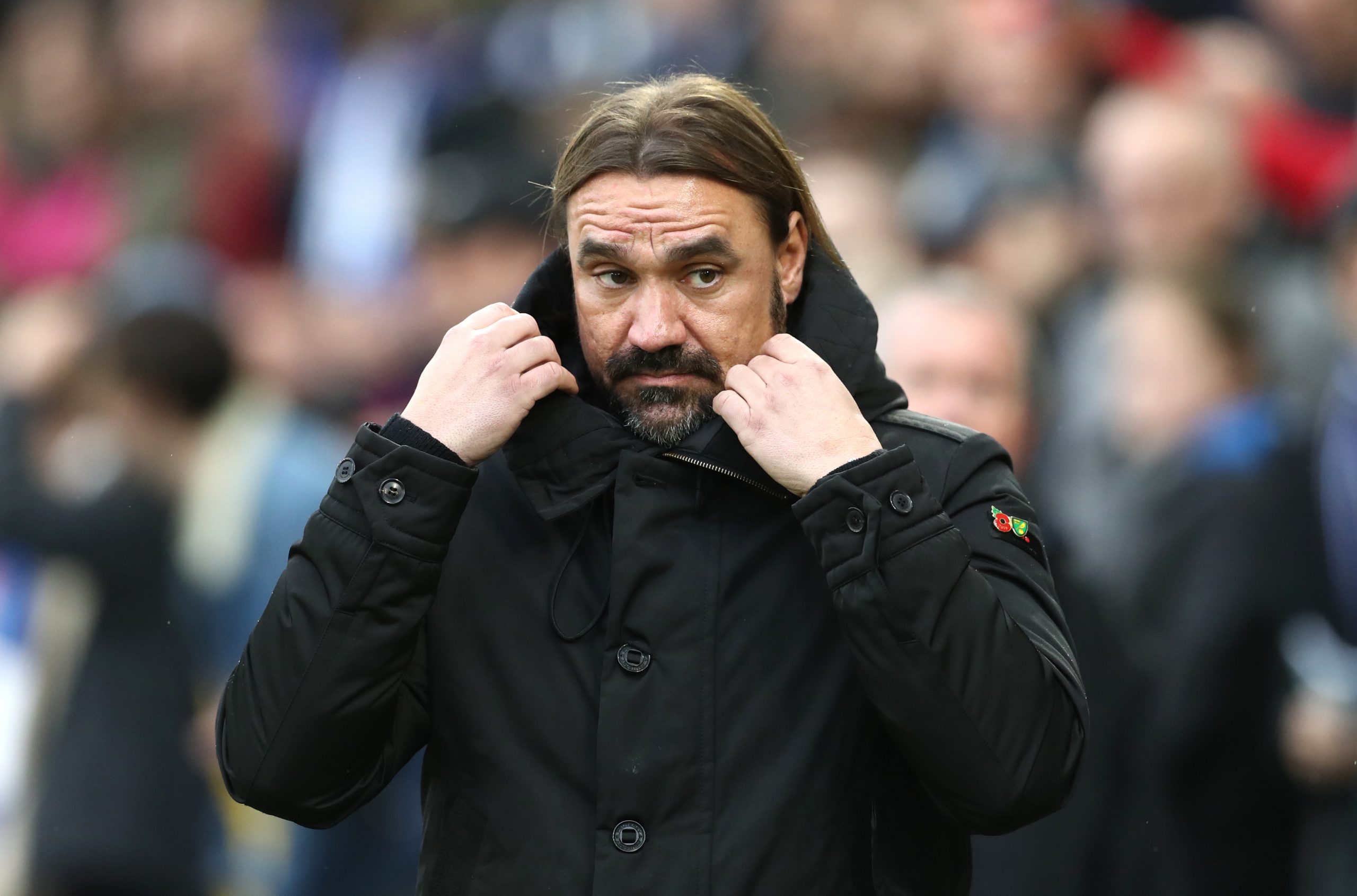
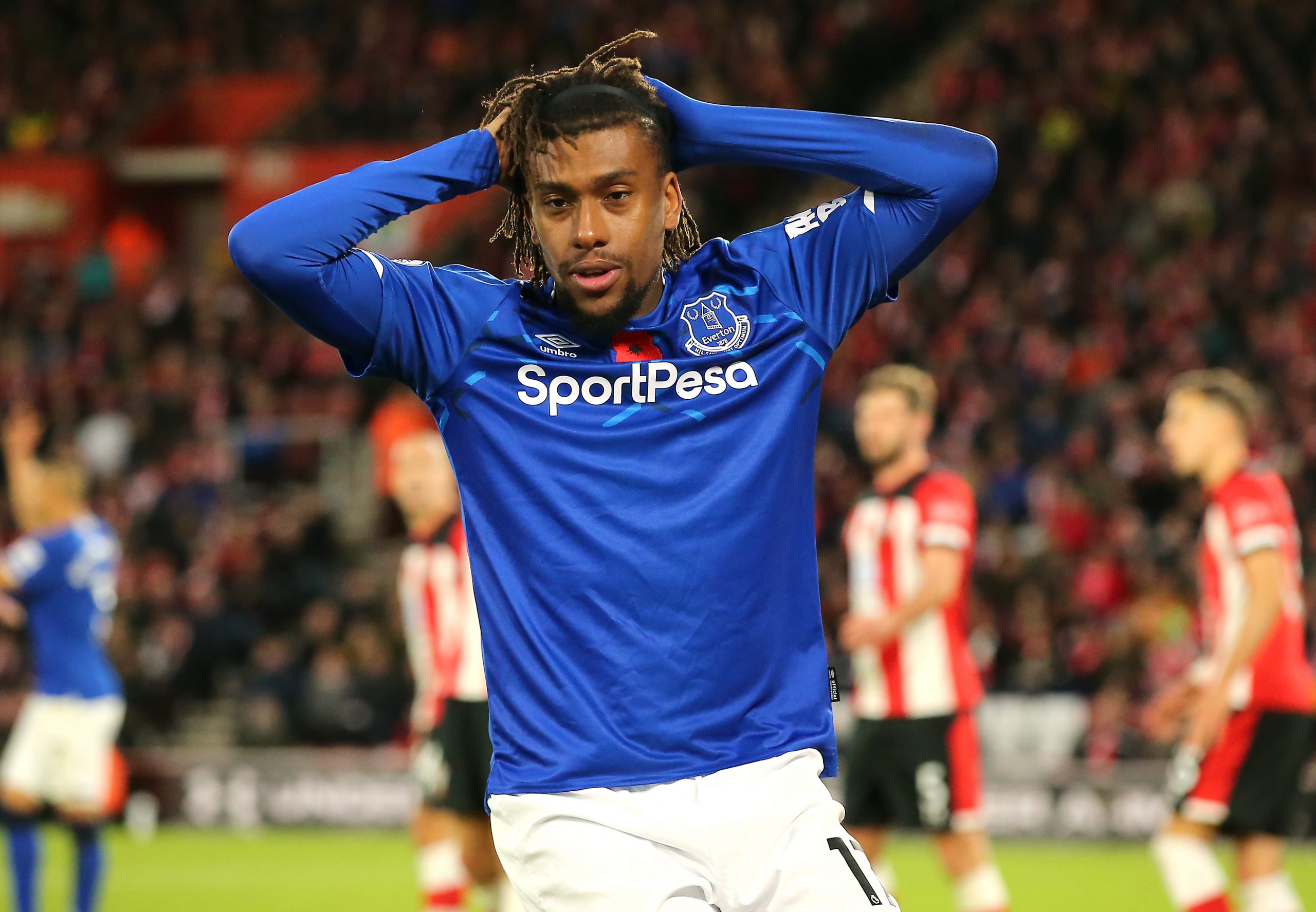
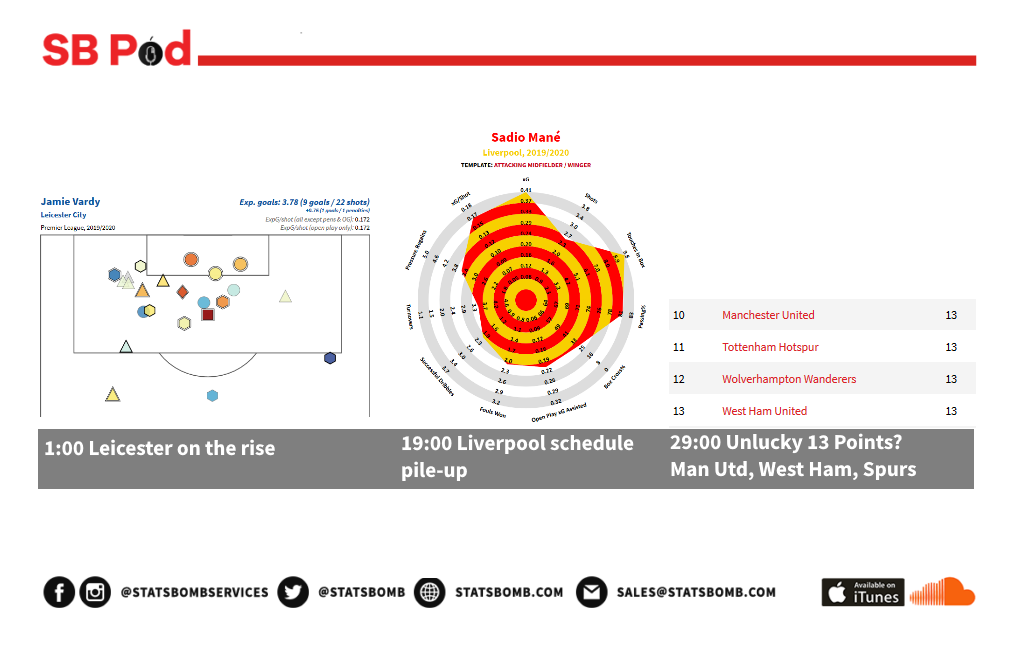
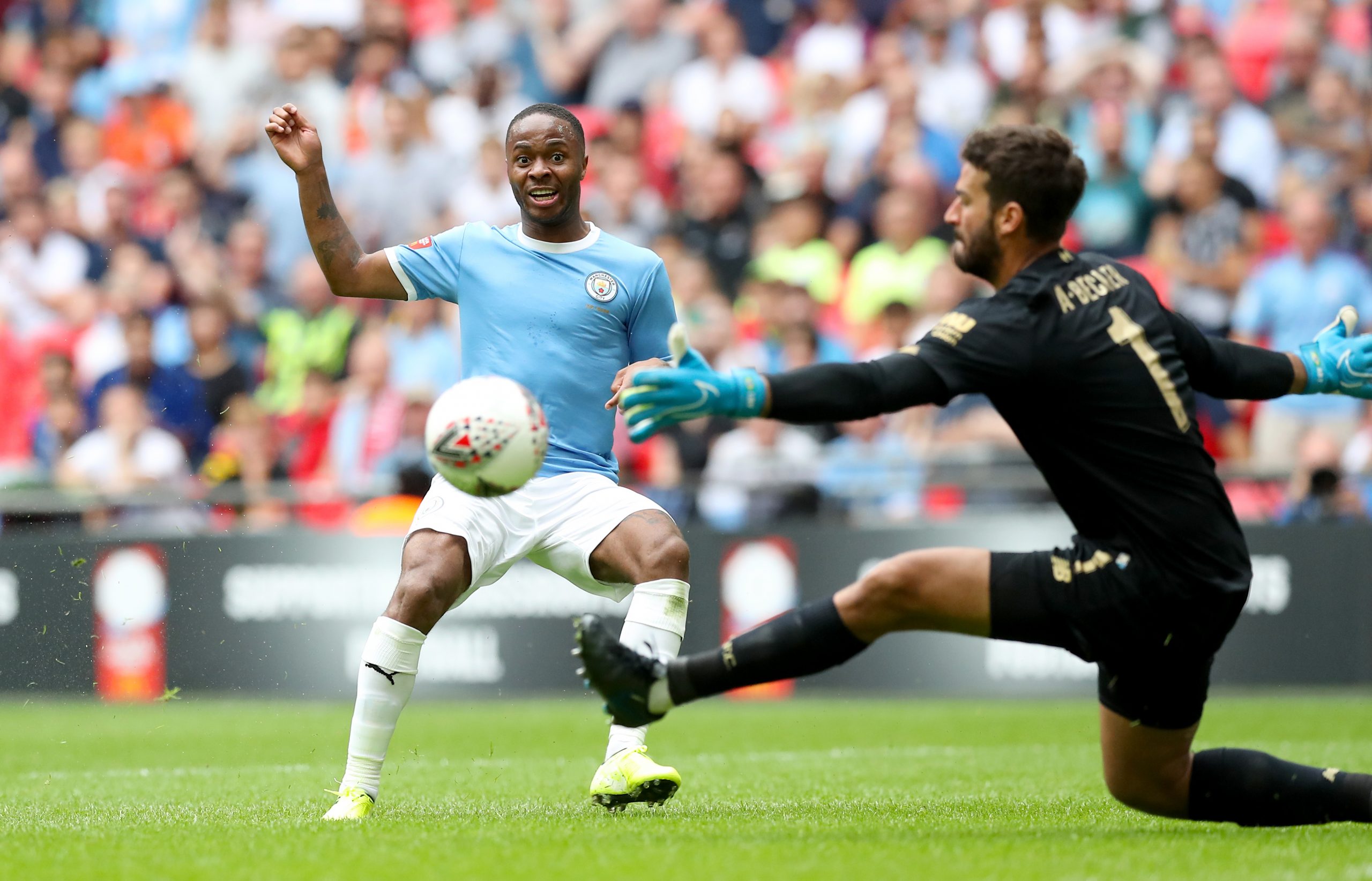
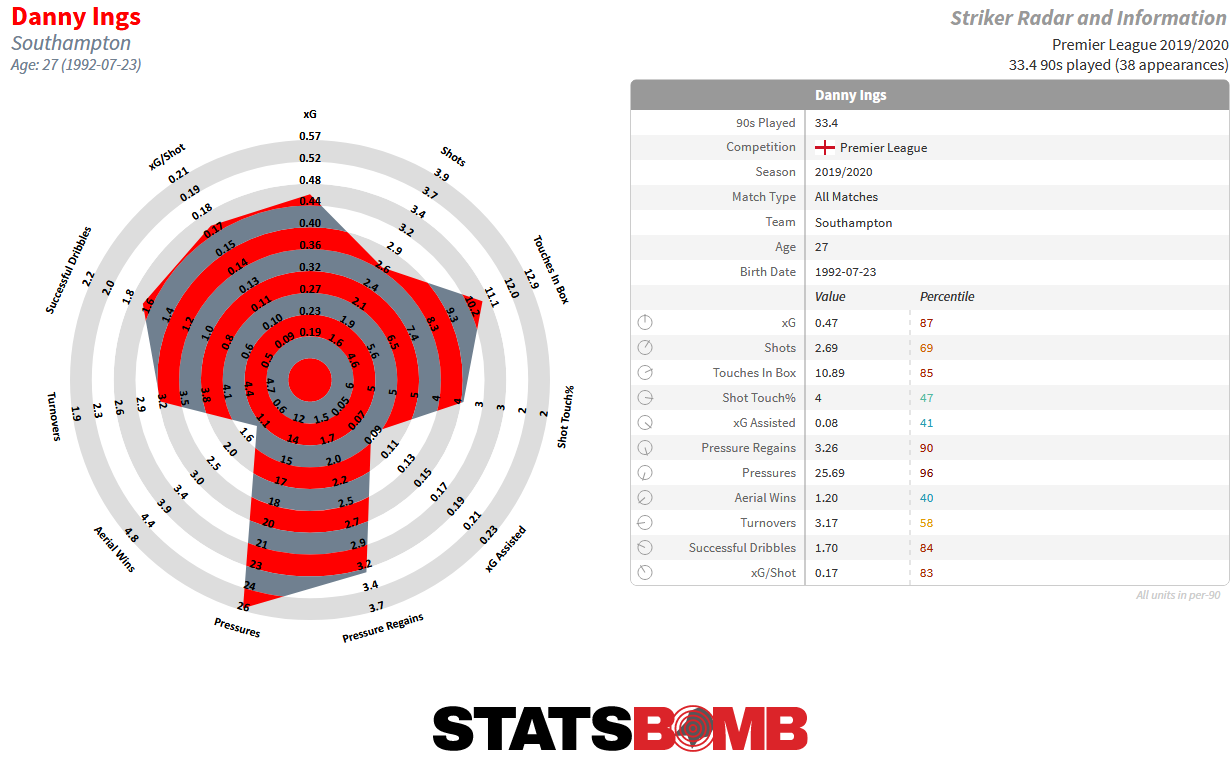 Chris Wood and Ashley Barnes: The dynamic duo
Chris Wood and Ashley Barnes: The dynamic duo
